November 30, 2017
Girls of the Golden West in San Francisco
John Adams’ eighth opera takes his now astonishing sonic and dramatic vocabulary to ever greater depths, creating, ultimately, shattering climax to the lives of seven early Californians, their stories, as construed by librettist Peter Sellars, unfolding both in their own words and in the words of poets and slaves in American history. The real protagonist of Girls of the Golden West is however the corpus of the 49er miners who pursue riches above all else and their inalienable right to the gold of the California mountains.
Girls of the Golden West, as staged by Peter Sellars, is an apt prelude to San Francisco Opera’s forthcoming Der Ring des Nibelungen (it’s essentially the same story). But far more than a prelude it stands on its own as the artistic exploration of the human and social forces of the American post-industrial era (Wagner’s Ring is of the industrial world), insisting that we inherit from these miners a collective guilt for destroying the hopes and lives of people of color — black, brown and yellow, and, yes, even poor Joe Cannon from Missouri (white). It is of epic proportion though it takes a mere three hours compared to the sixteen hours of Wagner’s epic when both finally arrive at a moment of purification.
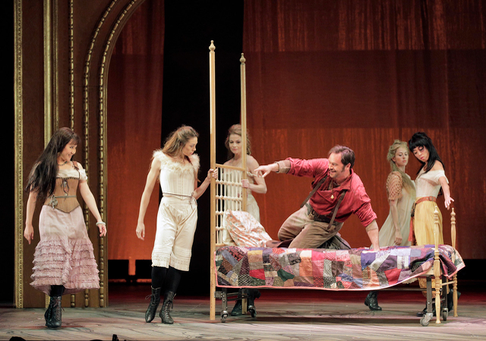 The minor Joe in the whorehouse, with whore Ah Sing, and corp de ballet whores
The minor Joe in the whorehouse, with whore Ah Sing, and corp de ballet whores
But Sellars’ Girls of the Golden West goes dramatically beyond its philosophic purpose, immersing us in Adams’ musical worlds of each of its characters. Dame Shirley is an actress from New England who plays Lady Macbeth to the down-on-luck miner Clarence’s Macbeth inciting the miners to lynch Ned Peters, a black slave turned teamster. Joe Cannon’s Sally back home in Missouri marries a butcher, on the rebound he marries a Chinese whore, Josefa is the beautiful Latina lure to attract the miners to the bar where Ramón is the croupier.
Act I is an idyll of perfect life inasmuch as life may be dreamt to be in this beautiful if rough, ugly world. In Act II these worlds are brutally vanquished in music that relentlessly throbs in powerful pulses, punctuated with bursts of tone that cannot be placed.
This bit of California history is real, in the real words of its historical actors, and thus alien to history or myth as usually imagined by opera where elaborated human situations are acted by invented human psyches. Composer Adams composes music to these real words that create art songs, an extended series of songs that you know and feel to be a cycle of some sort. There is a rare duet or two, six or so magnificent male choruses, several ballets (a respectful bow to grand opera), an occasional orchestral interlude. But there is no dialogue and there is no real story.
It is beautiful music of profound lyricism that is fiendishly difficult to sing, thus adding to the atmosphere of art that liberates this Girls of the Golden West from its imposed moral reprimand.
The Sellars production plays on the minimal, the literal and the naive. Scenic designer David Gropman ignores masking, thus there is no illusion. We know what we see is theater, and only that. Against an upstage gold drape stagehands walk on and off with props now and then. Visual quotes from rustic melodrama fly in and out. There is a huge stump and slice of a sacrificed California redwood. Costume designer Rita Ryack stays literal to the period, adding naive concept to dancers’ costumes. Choreographer John Heginbotham too played the naive against the en point classical technique exploits of the four women of the corps de ballet and particularly for the spider dance of prima ballerina Lorena Feijóo as the famed Lola Montez.
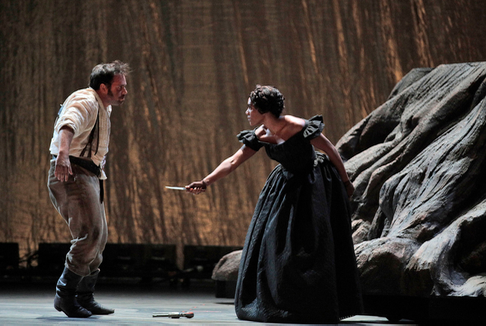 Josefa in the act of murdering Joe
Josefa in the act of murdering Joe
But finally it was the words, and nothing but words, discretely if significantly amplified by sound designer Mark Grey. Amplification served to add heroic dimension to the voices most notably to mezzo-soprano J’Nai Bridges as Josefa Segovia and baritone Elliot Madore as Ramón, these two roles the focus of the Sellars’ romantic tragedy — and it was sublime. Bass-baritone Davóne Tines as Ned Peters as the former slave was the moral focus, drawing a character of immense stature. Tenor Paul Appleby was the driven miner Joe Cannon who with soprano Hye Jung Lee as the Chinese whore Ah Sing created the grittiness and hopelessness of the gold rush free-for-all in their go-for-it-all performances.
Finally the soul of the opera was found in the performance of bass-baritone Ryan McKinny as Joe’s friend Clarence who wielded Lady Macbeth’s knife, forever transforming the lives of the opera’s victims, and in the end, perhaps, embodying the opera’s spiritual redemption (if there was one). The opera’s redeemer was Dame Shirley sung by soprano Julia Bullock who saw all, and as Lady Macbeth motivated all. Mlle. Bullock found the amplitude of emotional tone to observe, live and understand the tragedies of Downieville, by now a mere gold rush relic in the high Sierras, never letting us forget that these are real people with real names as was she (note that skin color was not always consistent with character).
These unique artists responded perfectly to the John Adams musical world, as did the spectacular accomplishment of the men of the San Francisco Opera chorus, all mastering the daunting score in what seemed to be a perfect performance (the fourth of eight). Conductor Grant Gershon took the San Francisco Opera Orchestra to the magnificent heights of the Adams score, in sometimes mind and heart boggling amplified fortes.
Surely this is composer John Adams’ masterpiece. It is understood that the masterful Peter Sellars setting of the opera is but one of the infinite possibilities for stagings of the Sellars libretto and Adams score.
Michael Milenski
Cast and production information:
Dame Shirley: Julia Bullock; Ned Peters: Davóne Tines; Joe Cannon: Paul Appleby; Ah Sing: Hye Jung Lee; Clarence Ryan McKinny; Josefa Segovia: J’Nai Bridges; Ramón: Elliott Madore; Lola Montez: Lorena Feijóo. Chorus and Orchestra of the San Francisco Opera. Conductor: Grant Gershon; Stage director: Peter Sellars; Set designer: David Gropman; Costume designer; Rita Ryack; Lighting designer: James F. Ingalls; Sound designer: Mark Grey; Choreographer: John Heginbotham. War Memorial Opera House, San Francisco, November 29, 2017.
image=http://www.operatoday.com/GirlsWest_SFO1.png
product=yes
product_title=Girls of the Golden West in San Francisco
product_by=A review by Michael Milenski
product_id=All photos copyright Cory Weaver, courtesy of San Francisco Opera.
DiDonato is superb in Semiramide at Covent Garden
Even with some customary cuts, there are over three and a half hours of music, stretching the attention span of most modern audiences. So, some enticing ‘crowd-pullers’ are required, and the ROH served them up in the form of a prima donna non plus ultra, a star-studded cast, and a staging by David Alden that emphasises the Shakespearean scale of the opera’s moral complexities and emotional conflicts.
Crime and punishment, guilt and retribution are at the heart of Semiramide. The opera, which is based on Voltaire’s play Sémiramis, is driven by an innocent hero’s quest for revenge and a guilty anti-heroine’s desire for redemption. The sins of the protagonists rival the most heinous misdeeds to be found in mythic Greek tragedy, and a Freudian would have a field-day with a plot whose deviancies include Oedipal attraction and matricide.
The eponymous Queen of Babylon may be the builder of the wondrous Hanging Gardens, but her wickedness must be purged if her kingdom of Assyria is to be renewed. She has murdered her husband, Nino, and now rules alongside her accomplice and lover, Assur. Forced to name her heir, she chooses the swashbuckling soldier Arsace to whom she is attracted but who, unbeknown to Semiramide, is in fact her long-lost son. In any case, Arsace shares with Assur and Prince Idremo an infatuation with Princess Azema. It takes the divine/supernatural intervention of the gods and a ghost to ensure justice is delivered.
Reviewing Opera Rara’s concert performance of Semiramide at the Royal Albert Hall - one of the highlights of the 2016 Proms season - I commented that ‘a concert staging of the opera was perfectly apt’, given that Rossi’s libretto relates a drawn-out mission to avenge an assassination which has taken place years before while the perpetrators of the crime are essentially in the hands of the gods. Director David Alden opts for a monumentalism which reflects the epic nature of the protagonists’ emotional maelstrom, and which is complemented by chiaroscuro effects (lighting by Michael Bauer) that enhance the air of intrigue and secrecy. But, the vastness and majesty of Paul Steinberg’s swivelling, lowering, expanding sets, while making the most of the massive extent of the ROH stage, don’t do much to pep up the drama.
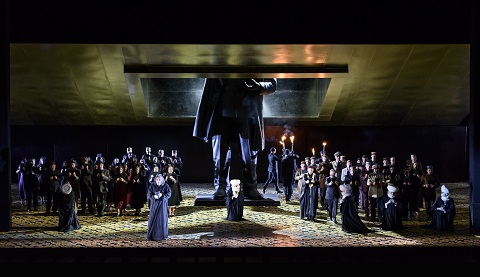 Cast, Act 1. Photo credit: Bill Cooper.
Cast, Act 1. Photo credit: Bill Cooper.
We may not be in Babylon, but we seem to be in the modern-day Middle East. Tyranny is not geography-specific though, so there are allusions - through iconographic propaganda; drab utilitarian locales juxtaposed with richly-hued ceramic mosaics; a cornucopia of marvellously detailed costumes (Buki Shiff has conjured a dressing-up box of every child’s dreams); and choreographic stylisation (Beate Vollack) - to the Soviet Union, North Korea and south-east Asia, as well as to caliphates of yore and now. There are turbaned Turks, shuffling Islamic priests and women in burkas, alongside embroidered Mughal robes and modern business suits. Alden’s general concern seems to be the trouble that brews when politics meets religion, but there’s no clearly articulated ‘argument’, political or otherwise.
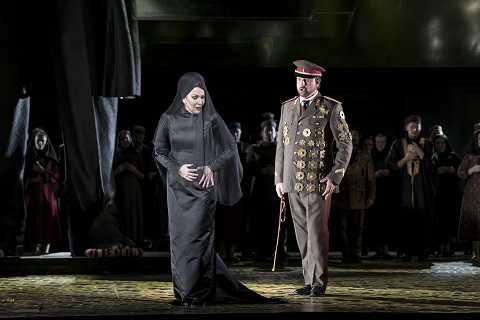 Joyce DiDonato (Semiramide) and Michele Pertusi (Assur). Photo credit: Bill Cooper.
Joyce DiDonato (Semiramide) and Michele Pertusi (Assur). Photo credit: Bill Cooper.
There are, however, visual and gestural motifs a-plenty. The ROH Chorus - in tremendous voice and offering some seriousness to complement the splendour - sport a fabulous array of costumes and wave i-Pads and hymn-books with equal fervour. The High Priest of the Magi, Oreo, is kitted out with some natty pink-tinted shades. There’s a small child clutching a stuffed-toy horse who drifts, then rolls, around the stage. Assur has more medals on his uniform than Prince Philip, while Princess Azema - whose future will be determined by others - is confined inside a gold lama straight-jacket and afflicted by, alternately, arm-flailing fits and catatonia; moreover, her feet seem to have been bound Chinese-style, as she has to be fireman-lifted on and off the stage. The smoke-swirling resurrection of Nino’s ghost (acted by John O’Toole) owes more to Bram Stoker than to Hamlet; well, that will teach Semiramide for disrespectfully plonking her goblet of red wine on her dead husband’s coffin.
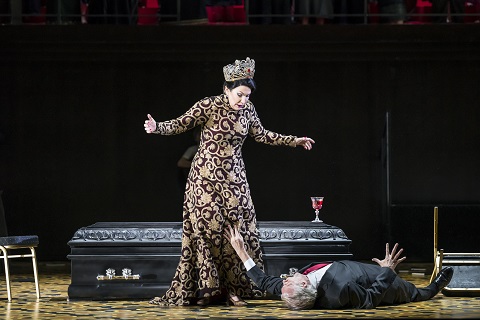 John O’Toole (Nino’s ghost). Photo credit: Bill Cooper.
John O’Toole (Nino’s ghost). Photo credit: Bill Cooper.
In the opening scene, the citizens, who are celebrating the anticipated announcement by their Queen of the identity of the next King, assemble at the feet of a huge, pedestalled statue: the prophet Baal has been replaced by a modern-day dictator, though there are distinct shades of Ozymandios. Later we get the full picture, in the form of enormous wall-paintings of a royal clan who bear a disconcerting resemblance to the US First Family. In one looming portrait, the King raises an arm à la Statue of Liberty while the Alpine view evokes the Romantic questing of Caspar David Friedrich’s Wanderer Above the Sea of Fog - though, facing us, he’s not really inviting us to explore his vision, but showing us what he has already conquered.
Semiramide is an opera in which the Queen’s redemption is necessary for the renewal of her state, and fortunately for this production, it is itself redeemed by some fabulous singing, not least by Joyce DiDonato in the title role. What struck me most was what a perceptive, intelligent and thoughtful singing-actress DiDonato is. She can rattle off the pyrotechnics and infuse the Queen’s lines with beguiling lyricism; but she does so much more than this. She shapes each tiny gesture into meaningful musical utterances which communicate every iota of Semiramide’s distress, desire and dilemma. She moves from whispered pianissimo to rich projection with startling control, and her vocal and dramatic performance perfectly accords with the visual ‘progression’. The Queen’s emotions are initially confined by black turban and veil; she then declares her regality in resplendent red and gold, topped with a sparkling crown; finally, her inner life is revealed as her dark tresses tumble over her midnight-blue silk nightdress in her bedroom colloquy with Assur. DiDonato’s understanding of her character - and how to communicate it - and her utter commitment are reason alone to see this production.
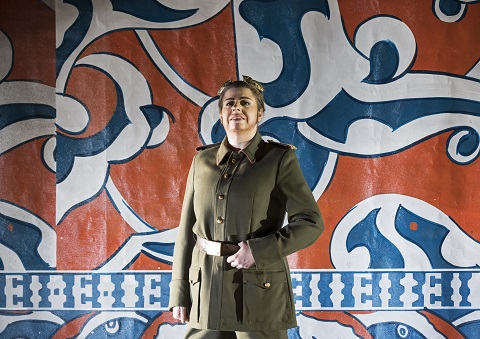 Daniela Barcellona (Arsace). Photo credit: Bill Cooper.
Daniela Barcellona (Arsace). Photo credit: Bill Cooper.
In 2016, at the RAH, I found Daniela Barcellona’s interpretation of the role of Arsace impressively focused and profound. Here, she was less consistently in command: her voice retained its agility and dusky beauty, and there could be no doubting her dramatic presence and boldness, but at the bottom her mezzo seemed less focused this time around. That said, the two mezzos formed a stunningly affective blend in their numerous duets, and here Barcellona’s lyrical flights really did convey inner feeling and enlarge the emotional field.
The ladies didn’t entirely steal the show, though. Lawrence Brownlee is a superb Rossinian stylist, and it was a pity that we were not treated to both of Idreno’s arias. The tenor’s high excursions and expansive phrasing were as effortless as his dramatic presentation of this minor role was confident and credible - a good thing, too, when some Bollywood garlands and gallivanting threatened to reduce this Mughal raja to ridicule.
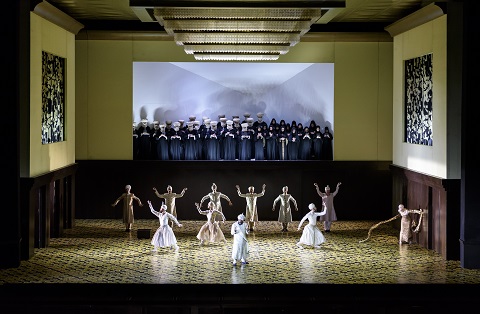 Lawrence Brownlee (Idreno). Photo credit: Bill Cooper.
Lawrence Brownlee (Idreno). Photo credit: Bill Cooper.
Assur’s mad scene was delivered with dark passion allied with accuracy by Michele Pertusi. Pertusi’s Assur is no pantomime villain: the Italian bass offered a nuanced characterisation which conveyed a complex psychology expressed through dynamic and tonal variety. In Pertusi’s and DiDonato’s Act 2 duet, their mutually destructive anger and rivalry was laid brutally bare.
All credit to Jacquelyn Stucker for her forbearance, trussed up as Princess Azema was inside gilded shackles. She sang with directness and clear tone, and it was good to see this Jette Parker Young Artist partnered by two other young singers on the ROH scheme: South Korean tenor Konu Kim (Mitrane) and South African bass Simon Shibambu (Voice of Nino’s Ghost). Due to illness, Hungarian bass Bálint Szabó was unable to sing the role of Oroe and he was replaced by Simon Wilding.
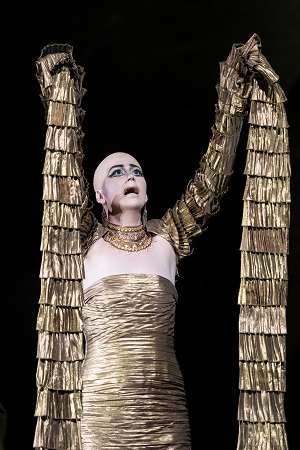 Jacquelyn Stucker (Azema). Photo credit: Bill Cooper.
Jacquelyn Stucker (Azema). Photo credit: Bill Cooper.
In the pit, Pappano aimed for and achieved pin-point precision and definition: it was clear from the overture, and from the horns’ beautifully shaped first theme, that lightness would prevail, and Pappano remained sympathetic to his singers throughout while evidently having the structural measure of the sprawling score. But, even Pappano couldn’t keep the momentum raging through a first Act lasting nearly 2 hours, although Act 2 did turn up the intensity.
Alden seems to have been intent on injecting irony into Rossini’s seria drama, but the singers ensured that the emotional depths of the opera were unfolded. And, DiDonato’s contribution cannot be underestimated: she balanced fire, fear and fatalism with astonishing conviction and credibility.
Claire Seymour
Rossini: Semiramide
Semiramide - Joyce DiDonato, Assur - Michele Pertusi, Arsace - Daniela Barcellona, Idreno - Lawrence Brownlee, Azema - Jacquelyn Stucker, Oroe - Simon Wilding, Mitrane - Konu Kim, Nino's Ghost - Simon Shibambu; Director - David Alden, Conductor - Antonio Pappano, Set designer - Paul Steinberg, Costume designer - Buki Shiff, Lighting designer - Michael Bauer, Choreographer - Beate Vollack, Orchetra and Chorus of the Royal Opera House.
Royal Opera House, Covent Garden; Tuesday 28th November 2017.
image=http://www.operatoday.com/Pertusi%20Assur%20and%20iconography.jpg image_description=Semiramide at Covent Garden product=yes product_title=Semiramide at Covent Garden product_by=A review by Claire Seymour product_id= Above: Michele Pertusi (Assur) and ROH castPhoto credit: Bill Cooper
November 29, 2017
Hans Werner Henze Choral Music
Calling these "choral" works is a misnomer, since Henze writes so well for vocal ensemble that the voices move as a unity and as individuals, like a parallel orchestra, voices interacting with instruments. Such are the densities of vocal interaction in Orpheus Behind the Wire that Henze can dispense with orchestra altogether. SATB form is stretched with such refinement that the voices are almost microparted, in 12 part a capella. The voices of the SWR Vokalensemble are so perfectly balanced that the singing seems to flow seamlessly, the rich textures, enhanced with great depth.
That sense of flowing movement is significant, for Orpheus Behind the Wire was created to be danced to. Fluid movements, subtle changes which suggest constant evolution. This is music as Greek sculpture, form as clearly defined as muscles carved in marble, or the folds of garments on statues frozen mid-flow. The progress across the five songs is formal, yet elegant and deliberate, as stylized as Greek art. The text was written in 1978 by Edward Bond, and re-tells the story of Orpheus's journey to the Underworld in search of Eurydice with a modern twist : the idea of individuals caught up in situations beyond human control. Orpheus can never unite with Eurydice, but will forever remain alone and alienated from the world around him. When Henze splits the four vocal groups into twelve individual voices, he unites meaning with musical form.
An otherworldy hum underpins the first song, What was hell like?, the vocal line shimmering on several levels. "No echo came from my music". The words “silence, silence" repeated like an echo spreading into empty distance. Orpheus and Eurydice cannot travel together, but the physical death of one means the spiritual death of the other. Thus the long lines reaching out, but not connecting. Undulating lines, where words are broken into particles and scattered, like dust in the wind, "silenced, silenced". This is deliberate irony. The singing is pitch perfect and beautifully modulated but the sentences are hard to make out, for this is the Underworld, where shadows deceive. In Hades, meaning is shrouded. By breaking up the vocal line, Henze is using sound to capture the ambiguity. Like Orpheus we must pay attention and feel our way.
Orpheus grows old, "more strings on this lyre than hairs on my head", but he is not free. Occasionally the men's voices dominate, but the mood is troubled. At last, something stirs. "Pressed" the voices sing on an upbeat, "by the weight of the world". Now tense, more anguished figures, a multiplicity of voices, their lines wavering in tumult. The text draws hope that "somewhere the starving have taken bread/from those who argue the moral of guns/ in assemblies guarded by guns". When the poor no longer shiver in rags, "Then I hear music of Orpheus, of Triumph ! of Freedom!". In the dense layers of texture, the exact words aren't easy to make out, but that might be for the reason that freedom is not yet at hand, meaning must remain occluded, secretive, literally "Behind the Wire".
In Lieder von einer Insel, Henze recalled his close friendship with Ingeborg Bachmann. She wriote the poems in the summer of 1953, when the pair had escaped to Italy, symbol of the "golden South" celebrated by Goethe and so many other northerners before and since. Bachmann's poems are sunlit, but haunted : "Schattenfrüchte fallen von der Wanden". Henze's setting is dominated by celli, trombone and double bass, long, keening lines that suggest darkness. The voices sing in unison, the range of timbres creating a rich lustre. The double bass leads the celli into a solemn dance. The central song, Einmal muss das Fest ja kommen, resembles a festive procession, led by trombone and portative, a small portable organ with connotations of the Middle Ages, extended by simple percussion. The male and female voices separate, singing alternate lines, the vocal parts then alternating with instrumental. The effect of a medieval celebration. But what celebration ? perhaps a brief Carneval before a period of mourning. ? "...die Krater nicht rühn!" Henze sets the men’s voices in the fourth song almost as plainchant, the women's voice high and piping like choirboys. Whoever leaves the island cannot return unless rituals are performed. The mood is sinister : the trombone wails, the portative groans. The final song is deceptively simple, though the images are apocalyptic. "es ist ein Strom unter der Erde, der sengt das Gebein". And we shall bear witness. When Henze set Bachmann's poems, she still had ten years to live, but he knew the dreams they'd had were doomed.
Based on translations of early French poetry, Henze's Fünf Madrigales is a lively mix of mock medievalism and modernism. He was only 21, just emerging from a youth in which music had to conform to Nazi taste. Although it's an early work, we can already hear Henze's distinctive personality in embryo.
Anne Ozorio
mage=
image_description=
product=yes
product_title=Hans Werner Henze : Lieder von einer Insel, Orpheus Behind the Wire, Funf Madrigaleby= SWR Vokalensemble, Ensemble Modern, Marcus Creed
product_id=SWR Classic SWR19049CD[CD]
price=
product_url=
November 28, 2017
Philippe Jaroussky and Ensemble Artaserse at the Wigmore Hall
Jaroussky and Ensemble Artaserse - the period instrument ensemble that he co-founded in 2002 - offered a wonderful Handel-fest/feast at the Wigmore Hall, following the release of their Handel Album last month on the Erato/Warner Classics label. In the liner notes to that disc, Jaroussky comments that although ‘it’s only in the last few years that I’ve been able to play the big Handel roles on stage … I wanted to choose a selection of arias from less well-known operas’. And, so, alongside arias from Radamisto, we had a selection which dipped into the lesser-known waters of Tolomeo, Flavio, Siroe (kings of Egypt, Longobardi and Persia respectively) and Imeneo.
Handel is, in every sense, a ‘man of the theatre’, and this concert was structured into quasi-operatic sequences of arias and instrumental items that, performed segue, carried us through varied moods in discrete groups. Occasionally the juxtapositions were startling, even a little disconcerting, but they created a vitalism that surged through the sequences. ‘Theatricality’ was at the heart of this recital. After accompanying the ensemble onto the platform at the start, Jaroussky retreated, returning during the archlute’s striking prefaces, or during improvised instrumental bridges, or - in the case of Radamisto’s ‘Vile! se mi dai vita’ - bursting passionately through the players during the accompanied recitative.
Jaroussky’s effortless lyricism and dulcet tone have long been acclaimed, but his countertenor has now acquired an increasing weight and diversity of colour, and the aria choices seemed designed to show-case this, with rapid and rage-fired numbers outweighing those of limpidity and lament. The seductive slipperiness of the voice across and between ranges remains, though, as does the ease with which it pours smoothly through the extended coloratura that Handel spins - as in ‘Se parla nel mio cor’ from Guistino.
While Jaroussky had the resonance to penetrate through the vibrant instrumental accompaniments, his voice is not necessarily best suited to Handel’s ‘rage arias’. His vocal agility impressed, but he couldn’t quite capture Radamisto’s burning outrage when he is condemned by the tyrannous Tiridate (‘Vile! se mi dai vita’), despite the turbulent, quasi-percussive string fire; but there was melodic nuance and a shining melisma expressing confident defiance. In contrast, ‘Ombra cara’ from the same opera, was a peak of unaffected beauty: every note, every phrase was perfectly shaped and controlled, Jaroussky’s vocal shading ever-alert to the major/minor coloration and chromatic nuances in the instrumental accompaniment.
Flavio, re de’ Longobardi framed the programme, and the opening aria, ‘Bel contento’, conveyed all of the protagonist’s impetuous joy as Guido expresses his delight at his forthcoming marriage to Emilia. Jaroussky’s lower range pulsed with varied colours and matched the strings’ sprightly dotted rhythms. The voice surged through the triplets as if overflowing with content, and the da capo elaborations were both idiomatic and enriching, particularly as the expansion of range showcased the bright purity of Jaroussky’s upper voice. Handel’s heroic roles were composed for Senesino, who was renowned for the projection of his messa di voce, and his alto timbre must have been quite different to Jaroussky’s light soprano-light colour.
A beguiling solo by concert-master Raul Orellana seemed to invite Jaroussky back onto the platform for Tirinto’s beautiful ‘Se potessero i sospir’ miei’ from Imeneo - an aria which borrows from David’s ‘O Lord, whose mercies numberless’ from Saul, which Handel was composing simultaneously. The sweetness of the quiet close of the B-section, as Tirinto prays that his beloved Rosmene will return safely, was simply magical, and with the gentility of the final cadence and trill Jaroussky really did seem, as Tirinto sings, to ‘breathe out every sigh in my heart’. Best of all was Tolomeo’s ‘Stille amare, gia vi sento’ from Tolomeo, in which both players and singer were astonishingly responsive to Handel’s extraordinary depth and range of expression. In the recitative, Marc Wolff’s enticing archlute made the cup of poison seem as sweet as honey, while the strings’ brusque down bows urged him to drink. The intensity of the vocal line at the end of the recitative was salved by the light, trilling quavers of the upper strings - ‘bitter drops’ which, paradoxically, ease Tolomeo’s pain as he approaches death, his acceptance finding expression through Jaroussky’s wonderful lyricism and ornamentation.
The instrumental items were as ‘theatrical’ as the arias. Ensemble Artaserse have a tonal brightness and vitality of articulation which makes the ear sit up, and their risk-taking musical rhetoric rivals that of Fabio Biondi’s Europe Galante. Whether there are twenty or three instrumentalists, playing the sound is airy and buoyant - bow strokes rose and hovered far above the string - but the tone quality has a real ‘bite’. Tempi were generally on the swift side. There was no languorous lingering in the Adagio from the Concerto Grosso in C (incorporated into the 1736 ode Alexander’s Feast), which showcased the strongly defined meatiness of Nicolas André’s bassoon line complemented by the richly coloured resonance of Guillaume Cuiller’s oboe.
Drama was sought, and found, in each diverse movement - in the gritty down bow strokes at the start of the Grave from the C minor Concerto Grosso, in the beautiful song for cello and oboe in the Largo from the Bb concerto Op.3 No.2, in the fugal intensity of the Allegro ma non troppo from the sixth of the Op.6 set. But, such drama was balanced with delicacy in the Largo from the Op.6 No.2 concerto; and, having generally emphasised the incisive individualism of the parts, the instrumentalists blended in plush, warm, layers in the Largo from the Concerto Grosso in A minor Op.6 No.4. The Sinfonia from Solomon flashed by with such brio and brightness that it was as if we were hearing the celebratory announcement of the arrival of the Queen of Sheba for the first time: one could image the Queen floating in triumphantly on the shimmering sheen of sound.
This was a generous concert but - judging from the players’ smiles, and their physical and musical responsiveness to each other throughout - the musicians were enjoying the music-making as much as we were; and, so, we had three encores - two from Serse, including that enduring favourite ‘Ombra mai fu’, and ‘Pena tiranna’ from Amadigi di Gaula in which bassoonist André and oboist Cuiller joined Jaroussky at the front of the platform for a sarabande of exquisite intimacy and grace.
Claire Seymour
Philippe Jaroussky (countertenor), Ensemble Artaserse
Handel: Radamisto HWV12 - Overture; Flavio, re di Longobardi HWV16 - ‘Son pur felice al fine … Bel contento già gode quest’alma’; Concerto Grosso in G Op.6 No.1 HWV319 (Allegro); Concerto Grosso in C HWC318 (Alexander’s Feast); Siroe, re di Persia HWV24 - ‘Son stanco, ingiusti Numi … Deggio morire, o stelle’; Sinfonia from Solomon ( Arrival of the Queen of Sheba); Concerto Grosso in C minor Op.6 No.8 HWV326 (Grave); Imeneo HWV41 - ‘Se potessero i sospir miei’; Concerto Grosso in A minor Op.6 No.4 HWV322 (Largo and Allegro); Radamisto - ‘Vieni, d'empietà mostro … Vile! Se mi dai vita’; Concerto Grosso in F Op.6 No.2 HWV320 (Largo); Giustino HWV37 - ‘Chi mi chiama alla gloria? … Se parla nel mio cor’; Concerto Grosso in F Op.6 No.6 HWV320 (Allegro ma non troppo); Concerto Grosso in Bb Op.3 No.2 HWV 313 (Largo); Tolomeo HWV25 - ‘Inumano fratel, barbara madre … Stille amare, già vi sento’; Concerto Grosso in A minor Op.6 No.4 (Larghetto affetuoso and Allegro); Radamisto - ‘Ombra cara di mia sposa’; Concerto Grosso in G Op.3 No.3 HWV315 (Adagio); Flavio, re di Longobardi - ‘Privarmi ancora … Rompo i lacci, e frango i dardi’.
Wigmore Hall, London; Sunday 26th November 2017.
image=http://www.operatoday.com/Jaroussky%20%28C%29%20Simon%20Fowler.jpg
image_description=Philippe Jaroussky and Ensemble Artaserse at the Wigmore Hall
product=yes
product_title=Philippe Jaroussky and Ensemble Artaserse at the Wigmore Hall
product_by=A review by Claire Seymour
product_id= Above: Philippe Jaroussky
Photo credit: Simon Fowler
November 24, 2017
La Rondine Takes Flight in San Jose
Not only was the performance musically rewarding, the piece was also staged with genuine care and fidelity to the composer’s intentions. General Director and (on this occasion) set designer Larry Hancock seems to have his finger firmly on the pulse of his constituency’s preferences. The happy result is that his period scenery is visually luxurious and vibrantly colorful, all the while it exudes a distinctively Old World appeal. That is not to suggest it is in any sense “dated,” just winsomely “accurate.”
The handsomely paneled, burgundy-curtained drawing room of Act I yields to a wrought ironed revelry of a popular Parisian bar in Act II, before making way for a serene seaside haven in Act III, replete with a profusion of many-hued flowers. Mr. Hancock’s appealing settings were ably complemented by Elizabeth Pointdexter’s sumptuous costumes, which were not only richly detailed, but also particularly characterful in defining the station of the dramatis personae. In tandem with Ms. Pointdexter, Christina Martin was in command of the effective wig and make-up design, which ably completed the “look.”
Kent Dorsey has contributed a particularly subtle, beautifully judged lighting design. The discreet shifts in intensity and color captured the vacillating emotional state of the leading characters. Mr. Kent also used creditable deployment of specials, including understated implementation of follow spot effects.
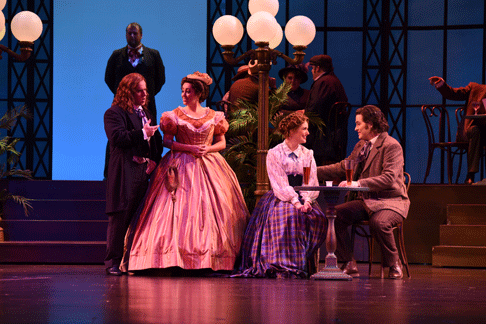 Act II Quartet with (from l) Mason Gates (Prunier), Elena Galván (Lisette), Amanda Kingston (Magda) and Jason Slayden (Ruggero)
Act II Quartet with (from l) Mason Gates (Prunier), Elena Galván (Lisette), Amanda Kingston (Magda) and Jason Slayden (Ruggero)
Director Candace Evans has devised an unfussy, dramatically apt staging with effective traffic patterns and groupings, which underscored meaningful character relationships; and she made commendable use of the entire playing space. Occasionally, Ms. Evans might let an actor wander a bit unmotivated to make use of a different stage area, but I always appreciated her thoughtful quest for variety and her intelligent sense of dramatic focus. Michelle Klaers created the sprightly choreography that enlivened Act II.
But no matter how successful the physical production, no one should come out of Puccini humming the scenery or the staging, so I can gladly report that the musical virtues were nothing less than top tier.
As the enigmatic, evasive “swallow” of the title, Amanda Kingston presented a Magda that embodied all that one could wish in this part. First, she is a statuesque beauty with a glowing, poised stage presence. More important, Ms. Kingston is a Puccinian dream of a singer with a plush, vibrant top voice characterized by creamy, luxuriant tone that is even throughout the range. Her vocal appeal is such that I mentally made a list of all the heroines I would love to hear her lavish with her artistry. Moreover, Amanda has an easy, unforced demeanor that is highly engaging. Her treatment of the famous Doretta’s Song in Act I was ravishing in its aural beauty.
As Ruggero, the physically handsome presence of Jason Slayden represented a one-two punch of effective casting. And he sings, too! Ruggero does not have much to do in Act I, and Mr. Slayden’s rather reserved presence and slightly hard-edged beginning (marked by a rather rapid vibrato) did not allow him at first to show off his interpretive gifts. However, this accomplished tenor quickly made up for lost time.
In Act II, Jason was all boyish charm and he poured on the vocal allure, solidly claiming his status as co-equal co-star with exuberant tone and arching phrases. Act III is largely his showcase, and here he rose to convincing heights with full-throated declarations that rang out in the house with impassioned conviction. The Dynamic Duo of Kingston and Slayden made quite an unassailable case for this neglected opus.
Nor were they alone in their accomplishment. The entertaining tenor Mason Gates was quite an irresistible Prunier, honeyed of voice, bewigged of presence, and assured of theatrical delivery. As his foil, the animated soprano Elena Galván was a silver-voiced, spunky actress who accurately hit each and every one of her musical and dramatic marks. Mr. Gates and Ms. Galván contributed mightily to the soaring Act II quartet (with Magda and Ruggero), helping to make it a true highlight of the evening.
Trevor Neal intoned a mellifluous Rambaldo, his imposing stature and smooth baritone a real asset to the production. Maya Kherani (Yvette); Teressa Foss (Suzy) and especially Katharine Gunnink (Bianca) contributed memorable turns. Babatunde Akinboboye was the firm-voiced Rabbonier, and Dane Suarez the poised Gobin.
In the pit, Andrew Whitfield inspired an idiomatic reading, marked by lush playing from the banks of strings and accents from the winds and brass that were by turns insightful, playful, and dramatic. Maestro Whitfield implemented a detailed, propulsive path for this lesser known piece that made a substantial case for Puccini’s talents in general and La Rondine in particular. His baton ably elicited the abundant colors in the score and he inspired a sweep and expanse that were inevitably very touching.
In short, Opera San Jose has served up such a totally satisfying, stylistically convincing rendition, it made me think La Rondine might yet join the ranks of vintage Puccini.
James Sohre
Cast and production information:
Yvette: Maya Kherani; Bianca: Katharine Gunnink; Prunier: Mason Gates; Magda: Amanda Kingston; Lisette: Elena Galván; Suzy: Teressa Foss; Rambaldo: Trevor Neal; Gobin: Dane Suarez; Ruggero: Jason Slayden; Rabbonier: Babatunde Akinboboye; Conductor: Andrew Whitfield; Director: Candace Evans; Set Design: Larry Hancock; Costume Design: Elizabeth Pointdexter; Lighting Design: Kent Dorsey; Wig and Make-up Design: Christina Martin; Choreographer: Michelle Klaers D’Alo
image=http://www.operatoday.com/Amanda-Kingson-as-Magda.png
image_description=Amanda Kingston as Magda [Photo by Pat Kirk]
product=yes
product_title=La Rondine Takes Flight in San Jose
product_by=A review by James Sohre
product_id=Above: Amanda Kingston as Magda
Photo by Pat Kirk
Bettina Smith, Norwegian Mezzo, in Songs by Fauré and Debussy
Impressive that Bettina Smith (who is, like her pianist, a Norwegian) handles the French texts so well. Still, I noticed some approximate pronunciations: she often forgets to pronounce certain s’s as z’s, the soft g can come a sh, and ou (i.e., oo) sometimes turns into o. Smith’s vibrato is mostly under good control, but the brief passages of coloratura in Fauré’s “Clair de Lune” are not tossed off with ease. Her mezzo-soprano voice broadens wonderfully at the top, especially at high volumes. At the bottom, it is often a bit light. Is she singing these songs in keys that are a little low for her (which thus helps the top notes be well within her grasp)?
On a more interpretive level, the singer is often emotionally neutral. There are few shadings to indicate specific tones of voice: regret, humor, passion. The singer responds to the text mainly by becoming louder or softer, or by speeding up or slowing down a little, and this is done at the level of entire long phrases and sentences, rarely individual words. The touching conclusion of “C’est l’extase”—“tout bas” (“soft and low”)—here becomes merely two more words for Smith to sing in her nice, solid fashion. Her pianist shows high skill but, at least in this repertoire, little independent imagination.
This shortcoming is most apparent in the least well-known set: a true cycle by Fauré that amounts to a kind of mini-opera for Eve, the world’s first woman. I cannot help but wonder if Smith (or, indeed, Røttingen) has thought about the many fascinating aspects of the ten poems that Fauré selected out of a much longer collection by Charles van Lerberghe. For one thing, Eve, in Fauré’s cycle, has an intriguing relationship with what seems to be the primary more-or-less-male figure in her life: God, about whom the world’s first woman sings in an intimate, even sensual manner (e.g., songs 4 and 7). Smith and Rottingen’s straightforward approach—and their high competence on a purely musico-technical level, which I do not mean in any way to disparage—can be heard on YouTube in the minute-long song 3 of the cycle, “Roses ardentes.”
There are numerous recordings of these works that I know, or suspect, provide more variety in the emission of the voice and greater attention to the subtleties of the poetry. I have either read high praise of, or have sampled with pleasure on YouTube, recordings of the Eve cycle by Elly Ameling, Jan De Gaetani, Barbara Hendricks, Irma Kolassi, Nathalie Stutzmann (who is a native French-speaker), and Dawn Upshaw. Upshaw is pure and gripping, with superb support from pianist Gilbert Kalish. The pioneering and highly responsive recording by Phyllis Curtin and Ryan Edwards (1964) is still available on VAI 1186, and the long first song from the Curtin/Edwards recording is on YouTube, revealing the great soprano’s admirable combination of warmth and control.
The booklet-essay for the present CD alternates trenchant observations and hyperbolic generalizations. I was delighted to find full texts and translations, from Graham Johnson and Richard Stokes’s first-rate A French Song Companion.
Ralph P. Locke
The above review is a lightly revised version of one that first appeared in American Record Guide and appears here by kind permission.
Ralph P. Locke is emeritus professor of musicology at the University of Rochester’s Eastman School of Music. Six of his articles have won the ASCAP-Deems Taylor Award for excellence in writing about music. His most recent two books are Musical Exoticism: Images and Reflections and Music and the Exotic from the Renaissance to Mozart (both Cambridge University Press). The first is now available in paperback, and the second soon will be (and is also available as an e-book).
image=http://www.operatoday.com/F%C3%AAtes_Galantes.png image_description=Lawo LWC1116 [CD] product=yes product_title=Fêtes Galantes: Songs by Debussy and Fauré product_by=Bettina Smith, mezzo-soprano; Einar Røttingen, piano. product_id=Lawo LWC1116 [CD] price=$16.81 product_url=https://www.amazon.com/Fetes-Galantes-BETTINA-RØTTINGEN-EINAR/dp/B01N3LVT3X/ref=as_sl_pc_tf_til?tag=operatoday-20&linkCode=w00&linkId=f8e91745e84d3545dceed1e22fd4d146&creativeASIN=B01N3LVT3X
Clonter Opera Gala
It was billed as an evening for newcomers and it delivered, dazzling them with a line-up of classy young singers, a world-class repetiteur and a slickly staged set of pieces. But it also worked for the aficionados in that the chosen pieces were certainly known yet not only Boheme and Butterfly, but also Rodelinda and Cendrillon – my only gripe was there was one too many in each half although you couldn’t fault the pianist Robin Humphreys who, along with director Lissa Lorenzo kept the action moving swiftly between the numbers. It was a cleverly crafted programme, and the arias flowed neatly on from one another with Lorenzo, acting as compere, announcing them in groups - the first lot involving kings and queens, she dubbed ‘Game of Thrones.’
Whenever Clonter is unearthed from its Northern roots, it rightly receives huge commendation for its work, namely paving the way between music schools and the big wide world by running courses where a singer can learn a role and perform it publicly. This is not such an original idea any more with opera houses themselves running young singers’ programmes. However, it was back in 1974, when Jeffery Lockett, a young singer himself at the time, invited Abbey Opera Group to perform in his barn. Possibly because of his own experience, Clonter’s residential artistic programme was born and due to his tireless audition process and talent for spotting young artists, Clonter has since been on the operatic map.
Last night’s talent didn’t disappoint. A line-up of three girls and two boys, they sang arias and duets, with skilfully light staging by Lorenzo. Working with the repertoire and these artists, Lorenzo paired them perfectly for duets. Tall Catalan tenor Eduard Mas Bacardit and tiny Spanish soprano Lorena Paz Nieto were authentically delightful in Breton’s La Verbena de la Paloma, while the more Northern (Anglo-Scottish) baritone Thomas Humphreys and Estonian soprano Mirjam Mesak were well matched in Leoncavallo’s Pagliacci and (even better) Rodgers & Hammerstein’s Oklahoma. The lonesome mezzo Bianca Andrew opened the evening in a show-stopping red halter neck gown with ‘Nobles Seigneurs, Salut!’ from Meyerbeer’s Les Huguenots – aptly French bearing in mind the mirrored Louis Quatorze setting, her softly-rounded mezzo is intrinsically suited to this music, and she has an easy upper register and with her boyish good looks she’d be a gorgeous Cherubino. Interestingly a scout from the Royal Opera House’s young artist programme was at the concert.
This is an exposed venue for young artists as well as being a boomy one. Mirjam Mesak initially sang Ilia’s ‘Padre! germani! addio!’ from Mozart’s Idomeneo impressively having no problem with the tessitura as her voice lies high, but there’s an edge to the sound - as the evening wore on, she got louder and louder and really only came back into her own in the musical numbers – she’d be an exciting Donna Anna and even a Constanze. Her fellow soprano Lorena Paz Nieto has a smaller voice and sang Tornami a vagheggiar from Handel’s Alcina cleanly and crisply but again her inbuilt projection nearly played against her in close proximity, but she has huge charm and vitality on stage. The baritone Thomas Humphreys took some time to settle and by aria four, the sublime Ideale by Tosti, he was velveteen in tone. The one to watch in my book was the tenor Eduard Mas Bacardit who opened with the beautiful Fatty inferno…… ‘Pastorello d’un povero amento’ from Handel’s Rodelinda and sang meltingly legato lines – he’s a clean almost pretty sounding tenor with a firm Italianate tone, a natural stage presence and is quite easy on the eye too….
They ended with ‘The Saga of Jenny’ from Weill’s Lady in the Dark again choregraphed lightly by Lorenzo but ‘musical’ enough so they repeated the finale in true musical style – a hat’s off moment to a great evening.
Louise Flind
image=http://www.operatoday.com/Clonter_Gala.png image_description=Clonter Opera Gala [Photo by Jack Thompson] product=yes product_title=Clonter Opera Gala product_by=A review by Louise Flind product_id=Above: Clonter Opera Gala [Photo by Jack Thompson]Étienne-Nicolas Méhul: Uthal
Or they avoid the problem by not performing the work at all. The French operatic tradition, in particular, is full of important works with spoken dialogue that we rarely get to see on stage: some comic (e.g., by Auber or Adam), others serious (e.g., by Cherubini or, as here, Méhul).
Recording a little-known work, whether in the studio or during a performance, can give performers a chance to find out whether it retains enough vitality to speak to present-day listeners. I am currently reviewing two works with spoken dialogue and will soon post them here: Hérold’s Le pré aux clercs, a long-loved French opéra-comique whose tone alternates between giddy and grim; and, most unusually, an Italian work: De Giosa’s comic opera Don Checco. (The latter recording was actually made during a staged performance, apparently quite a successful one.)
Here we have the first fully satisfactory modern recording of the one-act opera Uthal (1806) by Étienne-Nicolas Méhul (1763-1817). This work has long been praised for its unusual treatment of the orchestra, but performances have been few. An LP of a BBC studio performance from 1972 was once available on a pirate LP; it can now be retired.
The opera’s story comes from the writings of “Ossian,” a bard purported to have lived in southern Scotland in the third century. The Ossian epics were beloved in the late eighteenth and early nineteenth centuries, even after it became known that they were, to a significant degree, inventions by a Scottish poet named James Macpherson, not (as Macpherson had at first claimed) translations from Gaelic originals. In Méhul’s opera we meet Malvina, her aged father Larmor, and her husband Uthal, who has deposed Larmor. There is much mention of Fingal, the people’s leader; many of us still recognize that brave warrior’s name through the other standard title for Mendelssohn’s “Hebrides” Overture: “Fingal’s Cave.” The libretto was written by J. B. de Saint-Victor, largely in classical alexandrines (rhymed verses consisting of six-plus-six syllables, as in the great tragedies of Corneille and Racine).
The many intriguing musical moments include an arioso for Malvina (track 9) in which orchestral fragments of the tramp-tramp of the warriors (who have just left the stage) can still be heard; the first chorus of bards, to which Malvina then overlays an entirely different melody (track 10); and the soliloquy aria for Uthal upon his long-awaited first appearance, halfway through the work (track 12). One senses here an opera composer who is never content to provide music in an automatic, conventional manner—and one from whom Berlioz, who likewise loved to layer disparate musical materials on top of one another, learned a lot.
Another intriguing moment: a solo cello, in high register, threads its quiet way through that aria of Uthal’s, playing long notes that form the melodic core of his vocal line, which has been somewhat more elaborated by the composer to allow for extra syllables in the text. (The vocal lines throughout the opera are on the plain and direct side, with nary a hint of coloratura.)
The singers here all have steady and attractive voices and sing their texts persuasively. They speak the dialogues well, though with a very wide dynamic range: I had to turn the volume up for some patches of whispering and then turn it down again when a character became agitated or insistent, or when the singing returned. But this complaint is also a compliment: the performers take the work seriously and make sure to convey the drama at every turn. And of course one can skip the dialogue tracks (clearly marked in the track list) and go from musical number to musical number.
My favorite singer here is Karine Deshayes, whom I have previously praised in Rossini arias and as the pagan queen in Félicien David’s 1859 opera Herculanum. Jean-Sébastien Bou sings beautifully as the father, though his lowest notes lack fullness, as was also true when he played another heroine’s father: in Lalo and Coquard’s La Jacquerie. The much-recorded tenor Yann Beuron—his voice still firm at 48—conveys well the resoluteness of the title character Uthal.
Christophe Rousset’s early-instrument group plays with spirit, accuracy, and much tonal variety. The orchestration is somewhat dark, because Méhul excluded the violins: instead, he called for a larger-than-usual viola section and divided it into two parts to provide the top lines of the string choir. (Brahms would similarly do without violins in his orchestral Serenade No. 2 and in the first movement of the German Requiem.) The absence of violins is frequently relieved by many other interesting instrumental effects. We often hear two very woodsy flutes, colorful stopped notes from two unvalved horns, and glinting arpeggios from two light-toned period harps. Passages of tremolo for the string sections are full of energy and impulse. The chorus (men only) is small but spirited and nearly always clear in pitch. The solo singers playing Ullin and four other bards—cousins, in a sense, to Oroveso and the druids in Bellini’s Norma—have only a little to sing, but they do it superbly.
The small book that comes with the CD contains excellent essays and background readings in French and English (including substantial passages by the composer, the librettist, and three nineteenth-century critics, one of them being Berlioz); the libretto is likewise given in both languages. The alexandrine lines are broken up into shorter ones on the page. This inadvertently disguises the verse meter and the rhyme schemes. But a reader, once alerted, should be easily able to restore mentally the original layout. Translations throughout are straightforward but occasionally too literal to be immediately clear.
The performance materials were prepared, and the recording funded, by the Center for French Romantic Music, located at the Palazzetto Bru Zane (Venice). The recording sessions took place in the Versailles-palace opera house, whose acoustics have long been admired. The Center’s website offers one track from the CD—Uthal’s cello-aria discussed above—plus a video interview with the conductor. An informative interview with the conductor can be seen on YouTube (with snippets from the recording). And YouTube offers track 18, in which the bards calmly of glorious battles from the past, while Malvina keeps interrupting them as the sounds of actual battle increase offstage, pitting her husband against her father, increase offstage. The published score can be downloaded at IMSLP.org.
I urge anyone who has a fondness for Cherubini’s Médée (or Medea, as it is known in its more usual Italianized version) to get to know this work by Méhul. You are in for an hour of pleasant surprises in the areas of melody, harmony, orchestral color, musico-dramatic cogency, and Napoleonic-era cultural mythology.
Ralph P. Locke
The above review is a lightly revised version of one that first appeared in American Record Guide and appears here by kind permission.
Ralph P. Locke is emeritus professor of musicology at the University of Rochester’s Eastman School of Music. Six of his articles have won the ASCAP-Deems Taylor Award for excellence in writing about music. His most recent two books are Musical Exoticism: Images and Reflections and Music and the Exotic from the Renaissance to Mozart (both Cambridge University Press). The first is now available in paperback, and the second soon will be (and is also available as an e-book).
image=http://www.operatoday.com/Uthal.png image_description=Ediciones Singulares ES1026 [CD] product=yes product_title=Étienne-Nicolas Méhul: Uthal product_by=Karine Deshayes (Malvina), Yann Beuron (Uthal), Jean-Sébastien Bou (Larmor), Sébastien Droy (Ullin), Philippe-Nicolas Martin, Reinoud Van Mechelen, Aravazd Sargsyan, Jacques-Greg Belobo (bards). Les Talens Lyriques, Choeur de Chambre de Namur, conducted by Christophe Rousset. product_id=Ediciones Singulares ES1026 [CD] price=$34.99 product_url=http://www.arkivmusic.com/classical/Drilldownname_id1=7997&name_role1=1&bcorder=1&comp_id=626341
A New Anna Moffo?: The Debut Disc of Aida Garifullina
She was clearly well trained in her native Tatarstan and then in Nuremberg and Vienna. She won first prize in the Operalia competition (2013), and has already sung at major European opera houses in Russian roles. She is scheduled to make her Metropolitan Opera debut in 2019.
The repertoire she has chosen here displays her strengths. She sings Russian arias and songs by Tchaikovsky, Rimsky-Korsakov, and Rachmaninov, the Russian popular song known in English as “Midnight in Moscow,” and two folk songs: a Cossack lullaby and (in her native Tatar) “Allüki.”
She starts the CD off with two French arias: “Juliette’s Waltz Song” from Gounod’s Roméo et Juliette and the “Bell Song” from Delibes’s Lakmé. She transposes the latter down a bit to suit her voice, which is not the stratospheric type of soprano that has often been associated with the role, though she can certainly sing normal high notes with ease. Her French pronunciation is approximate: the mute e is too open, and I did not notice a single nasal vowel. She also did little in those two arias to color individual words—the focus is far more on producing a beautifully even string of pearl-like notes.
Garifullina says in the booklet that she took the recordings of Anna Moffo as one of her main models, and she has chosen well. I hope she continues to grow as a singer, mastering the art of performing in other languages and responding more to the meanings of individual words and phrases—but without losing the astounding perfection of vocal production that is on display here.
The orchestra is sometimes a bit in the background. Various orchestrators are credited for the songs she chose to sing (e.g., Rachmaninov’s “Lilacs”), and their work is mostly capable and inoffensive. But I disliked Paul Bateman’s reorchestration of the “Song of India” (from Rimsky-Korsakov’s Sadko): why not just let us hear what Rimsky-Korsakov wrote, since this is already an opera aria, not a song with piano? Bateman had the not-brilliant idea of making the orchestration more elaborate in the second strophe. It’s somewhat distracting and unnecessary.
Far more distracting, I find, is Paul Campbell’s lush arrangement of the Tatar folk song. Campbell seems to have taken as a model what Joseph Canteloube did with the famous Chants d’Auvergne: a cushion of string sound, swooshing harps, soft arpeggios in the woodwinds, and so on. If you like the Canteloube songs (I have never had the patience for them), then here’s a Tatar equivalent.
Complete texts in the original languages, plus good translations into French, German, and English. The CD’s table of contents is a little confusing: the layout could give the inadvertent impression that Rachmaninov wrote the Tatar song and the Cossack lullaby.
You can sample all the tracks at https://www.youtube.com/watch?v=2tMPAqWICoE. YouTube also has a video version of Garifullina doing the Gounod (with fake applause at the end). One way or the other, I suggest that you listen to her: she offers some of the most beautiful singing I have heard in years.
Ralph P. Locke
The above review is a lightly revised version of one that first appeared in American Record Guide and appears here by kind permission.
Ralph P. Locke is emeritus professor of musicology at the University of Rochester’s Eastman School of Music. Six of his articles have won the ASCAP-Deems Taylor Award for excellence in writing about music. His most recent two books are Musical Exoticism: Images and Reflections and Music and the Exotic from the Renaissance to Mozart (both Cambridge University Press). The first is now available in paperback, and the second soon will be (and is also available as an e-book).
image=http://www.operatoday.com/Aida_Garifullina.png image_description=Decca 478 8305 [CD] product=yes product_title=A New Anna Moffo?: The Debut Disc of Aida Garifullina product_by=Aida Garifullina, soprano. ORF Radio-Symphonieorchester Wien, conducted by Cornelius Meister. product_id=Decca 478 8305 [CD] price=$10.69 product_url=https://www.amazon.com/gp/product/B017MZSLJW/ref=as_li_tl?ie=UTF8&tag=operatoday-20&camp=1789&creative=9325&linkCode=as2&creativeASIN=B017MZSLJW&linkId=061820c306fd3a9ba7ff49498d5083c4
A New Die Walküre at Lyric Opera of Chicago
The mortal twins Siegmund and Sieglinde are Brandon Jovanovich and Elisabet Strid. Hunding is sung by Ain Anger and Fricka by Tanja Ariane Baumgartner. The sisters of Brünnhilde are portrayed by Whitney Morrison, Alexandra LoBianco, Catherine Martin, Lauren Decker, Laura Wilde, Deborah Nansteel, Zanda Švēde, and Lindsay Ammann. The Lyric Opera Orchestra is conducted by its music director Sir Andrew Davis. The production is directed by David Pountney with scenery by Johan Engels and by Robert Innes Hopkins, costumes by Marie-Jeanne Lecca, and lighting by Fabrice Kebour. Mmes. Strid and LoBianco and M. Anger make their debut at Lyric Opera of Chicago in this production.
As the curtain rises Wotan appears briefly while holding his spear of authority and justice. During the orchestral introduction the ash tree, into which Wotan had previously plunged his sword, descends onto the stage into the midst of Hunding’s dwelling. Figures representing the three Norns and assistants push Hunding’s domestic table into place; Sieglinde, now alone, moves about, held by an extended chain attached to the tree. As a door at stage rear opens, Siegmund stumbles into the presumed haven. Visibly worn by battle, Mr. Jovanovich utters the lines “Hier muss ich rasten!” (“I have to recover here!”) with a gasp of desperate hope. Ms. Strid’s reaction shows an immediate sympathy for the weakened man seeking refuge. Her vocal color and range are ideal in portraying Sieglinde’s solicitous curiosity and her subsequent statements to Siegmund describing her own plight. From low pitches on “ihn muss ich fragen” (“I must find out where he’s from”) to the higher, palpable emotion with which she sings “noch schwillt ihm der Atem” (“I hear him still breathing”), Strid invests her lines with an anticipation matching the introductory tone set by Jovanovich. The refreshment of water once provided is followed by a lush orchestral performance of the love motif under Davis’s taught direction. In Sieglinde’s identification of home and self as “Hundings Eigen” (“belonging to Hunding”) Strid’s words are fraught with tension. Once both characters drink from the mead-vessel, Jovanovich’s voice blooms with noble color in describing his flight from the pursuit of “Misswende” (“ill fate”). In response to Sieglinde’s tentative yet clear invitation, the hero names himself “Wehwalt” and declares with assured resolve, “Hunding will ich erwarten” (“I intend to await Hunding here”). At the close of the scene each character sits alone at the base of a tower positioned on opposite sides of the stage, an indication of burgeoning attraction stunted by the domestic atmosphere and spirit of Hunding.
The entrance of Hunding, the lord and husband, injects a tone of caution and formality into the closed interior of the dwelling. Mr. Anger’s deep, resonant intonation emphasizes Hunding’s suspicion while asking after Siegmund and later during his visual comparison of the guest to Sieglinde. After reassurances of the law of hospitality, expressed by Anger with rich vibrato, Siegmund is encouraged to name himself. Upon complying, Siegmund also volunteers the story of his youth in the forest together with his father Wolfe. Here Jovanovich sings excited pitches on “Zwillingsschwester” (“twin sister”), then drifts to a piano lament at “kaum habe ich sie gekannt” (“I scarcely knew her”) when narrating the disappearance of both mother and sister. While telling of Siegmmund’s progressive isolation from father Wolfe and from potential friend or wife, Jovanovich sings the final line explaining his name with a hushed delivery of “Wehwalt … des Wehes walte’ ich nur” (“Wehwalt … only sadness was ascribed to me”). After describing his battle against a cruel race that tried to force a maiden into marriage, Siegmund’s extended pitches on “Friedmund - nicht heisse!” (“not called - Friedmund!”) identify him as Hunding’s enemy. From this point forward, the focus shifts from the past to an imminent struggle with future consequences. Anger’s chilling notes on “Sippenblut” (“clan’s blood”), and his vow to avenge it against the hero “Wehwalt,” prompts several violent movements. He throws his wife to the floor and demands from her his evening draught. Before departing grimly from the scene, Hunding casts a battle-axe into the communal table.
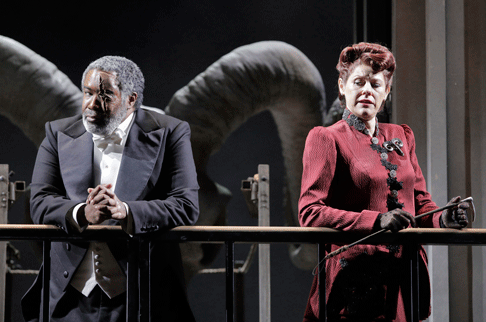 Eric Owens and Tanja Ariane Baumgartner
Eric Owens and Tanja Ariane Baumgartner
In the final scene of Act I Siegmund searches desperately for a weapon with which to counter Hunding’s threat. The dramatic cries of “Wälse! Wälse! Wo ist dein Schwert?” (Wälse! Wälse! Where is your sword?”) become endlessly held pitches by Jovanovich until the light of the glowing weapon catches his eye. When Sieglinde returns to the hearth, she indicates that Hunding has been drugged and that Siegmund should escape. Strid’s highly dramatic declamation of the narrative “Der Männer Sippe” (“My husband’s kinsmen”) becomes a catalyst for emotional and scenic development. Siegmund embraces her and reveals his love, whereupon the door at stage rear opens revealing the wonders of a springtime scene. During their subsequent duet spontaneous displays of genuine affection are here a natural extension of love through song. These displays render believable Jovanovich’s emotional declaration “Heiligster Minne höchste Not” (“Holiest love in highest need”) when he prepares to pull the sword Notung from the ash tree. As a joint impulse and with the future in mind the two principals escape from the confines of Hunding’s dwelling onto the spring heather, where their physical love is consummated.
The start of Act II in this production is ultimately bound to the previous space, yet now from the perspective of the immortal beings. The brief opening introduces Wotan and Brünnhilde, the latter giddy as she trips through the spring heath. The stage then assumes horizontal division with Wotan appearing on an upper level and Brünnhilde remaining below. The expected battle between Siegmund and Hunding fills Mr. Owens’s voice with rich excitement, as he instructs Brünnhilde to stand by Siegmund (“dem Wälsung kiese sie Sieg” [“let her assure victory for the Wälsung”]). Ms. Goerke in turn acquiesces with equivalent excitement and the exemplary performance of her repeated “Hojotoho!” with decorative trills inserted after each cry. Yet the mood of adventure fades just as Goerke reports with a decidedly expressive frown that Fricka approaches. Two central doors on Wotan’s raised station open, enabling Fricka - dressed similar to Wotan in formal attire befitting rank - to emerge from her chariot and demand an audience from her husband. In the role of Wotan’s wife and protector of marriage, Ms. Baumgartner assumes at once the position of a goddess slighted. She presents details of the infraction with deep resonant pitches, then rises vocally to emotional outbursts against the incestuous union at “ich klage!” (“I accuse”) and “Geschwister sich liebten?” (“the siblings as lovers?”). Despite Owens’s passionate defense of the twins’ innocent love, accompanied again by the orchestral spring motif, this Fricka reminds him imperiously of his own less than faithful treatment of marital vows. When Baumgartner demands that the sword, with a telling emphasis on “zauberstark” (“associated with magic”) be taken back, Wotan’s plan for the hero is clearly halted. She continues to press her case against Siegmund until Owens asks, with his voice descending to a statement of deep resignation, “Was verlangst du?” (“What must I do?”). His final words to Fricka, “Nimm den Eid!” (“Take my oath!”) capture decisiveness here and the duty of Brünnhilde to intercede in recovering Fricka’s honor.
The following scenes of Act II are admirably staged in natural progression. Wotan’s balcony descends so that he stands on Brünnhilde’s level to meet her return. In his intimate exchange with Brünnhilde, Owens narrates as “unaugesprochen,” with the hush of privacy, the story of the ring, Erda, and the Walküren. Wotan’s voice shakes with emotion as Owens declares forte that he seeks only “das Ende” (“the ending”) to what he has caused. Despite his daughter’s protests Wotan threatens chastisement if Brünnhilde does not assure the victory of Hunding. The stage platform lifts Wotan again to the elevation of his power while Brünnhilde realizes, beset with gloom below, her task.
Siegmund and Sieglinde appear in flight from Hunding’s wrath. Despite his encouragement to continue, Sieglinde relates her hysterical fears from dreams of the sword breaking in battle. Jovanovich’s tender replies of “Schwester” (“Sister”) coax her into a fitful sleep. Brünnhilde’s approach bearing shield and cloak is greeted by Siegmund as “schön und ernst” (“beautiful and somber”). When Goerke informs him with ceremonial dignity that she has come as a messenger of death to ensure his entrance into Walhall, the hero asks if he will find there his father and be joined by Sieglinde. At the denial of this second hopeful request, Jovanovich replies with grim resolution, “… folg ich dir nicht” (“ … I shall not follow you there”). Goerke then circles the stage through the air on an elevated steed perched on a crane manipulated from below. Despite her emotional supplications to consider honor and “ewige Wonne” (“eternal joy”) as a slain hero, Siegmund refuses to ignore his companionship of Sieglinde. The Walküre’s declaration that she can understand the hero’s suffering is expressed here with moving empathy, leading to her ultimate defiance of Wotan’s will. When Goerke announces with searing determination “Beschlossen ist’s” (“It is decided”), the course of the remaining action is set. In his final address to Sieglinde Jovanovich incorporates achingly soft melismatic phrases into what becomes a touching farewell. Battle horns accompany a transformation of scene: Wotan and Fricka appear on the towers at opposite sides of the stage, with Siegmund and Hunding on raised platforms closer to the center. When Wotan allows Siegmund’s sword to shatter, causing his death at the hand of Hunding, Fricka’s will is complete. With Owens calling excitedly for Brünnhilde’s punishment, the orchestra swells to accompany Fricka’s contented smile as she gazes, at stage center, upon Wotan’s spear of justice.
The musical and dramatic excitement of the opening scene of Act III is imaginatively staged and costumed. The Walküre sisters appear variously on elevated horses, reminiscent of Brünnhilde’s steed, and at work on stage level, while they prepare or direct the transport of fallen heroes to the honor of Walhall. When Brünnhilde appears shielding Sieglinde, Goerke utters her line “Schützt mich!” (“Protect me!”) with frantic appeal. Before the arrival of Wotan, she is able to transform Sieglinde’s desperation into thoughts of her future child and an escape into the forest. During the following scene the sisters attempt to conceal Brünnilde before Wotan’s wrath. Instead they become witnesses to his public condemnation of the favored child. Here Owens delivers Wotan’s address with powerful declamation in his pronouncement that she will no longer fill his drinking horn in Walhall. Indeed she is, with Owens’s dramatically conclusive pitch, “verbannt” (“banished”).
In the opera’s last scene, the Walküren have retreated at Wotan’s command and left father and daughter alone for the reckoning of punishment. The emotionally wrenching dialogue between the two principal singers is here sung and acted by Goerke and Owens as an ultimate, moving confrontation. When Goerke declares, with sustained top pitches, that in her way she remained loyal to Wotan, Owens concedes with resignation that duty forced him to change his resolve. In their simple clasp of hands both figures show here the inevitable resolution of the story. Brünnhilde, now as a mortal, is surrounded by the bridal fire to be discovered only by the bravest hero. The masterfully played orchestral conclusion seals this unforgettable production.
Salvatore Calomino
image=http://www.operatoday.com/Christine-Goerke_Brandon-Jovanovich_Elisabet-Strid_DIE-WALK%C3%9CRE_37A5218_c.Cory-Weaver.png
image_description=Christine Goerke, Brandon Jovanovich, and Elisabet Strid [Photo by Cory Weaver]
product=yes
product_title=A New Die Walküre at Lyric Opera of Chicago
product_by=A review by Salvatore Calomino
product_id=Above: Christine Goerke, Brandon Jovanovich, and Elisabet Strid
Photos by Cory Weaver
November 22, 2017
As One a Haunting Success in San Diego
This relatively new one act opera (music by Laura Kaminsky, book by Mark Campbell and Kimberly Reed) has become the most often performed contemporary work in recent years for several reasons. First, it is a wholly engrossing character study as it traces the topical, personal, transgender journey of “Hannah.”
Second, it achieves a luminous and absorbing effect with absolute economy of means, requiring only two singers, a string quartet, suggested scenery, and simple costumes. It is an opera producer’s dream that is also a spectator’s wonder.
Hannah Before and Hannah After are compellingly sung and impersonated by baritone Kelly Markgraf and mezzo-soprano Blythe Gaissert. As Hannah evolves from being trapped in a male body to embracing the woman she is, the two perform seamlessly together, to coin a phrase, “as one.”
Mr. Markgraf (Before) has a beautifully rich and well-modulated vocal delivery. He can thunder out pain that rings off the back wall one minute, and then break your heart with hushed, intense phrases of melting beauty the next. He is somewhat slight in stature, but looms large in stage presence and a total emotional investment.
Ms. Gaissert (After) matches her co-star in complete conviction, breathtaking musicality, and vocal allure. She is afforded a complex, riveting final scena of rage and frustration and doubt and acceptance that highlighted every one of her substantial vocal gifts. Blythe has a beautiful sheen in her well-schooled instrument and deploys an even delivery throughout the wide-ranging writing.
Director Kyle Lang has choreographed stage movement that is fluid and restless when possible, and wondrously still and reflective when appropriate. His varied use of the simple floor plan of a few steps and adjoining platforms is notable for its profound simplicity. Moreover, as the music intertwines the two beings, Mr. Lang visually embodies this with carefully considered, dance-inspired interplay between the singing duo.
He is well served by filmmaker and videographer Kimberly Reed who has collaborated fruitfully with set designer Jonathan Gilmer to devise a handsome backdrop of hanging screens. Projected on these are images of Hannah’s life experiences that accomplish the feat of being informative without being distracting. Ingrid Helton’s honest costumes provide just the right look, especially in her choice to have the actors and onstage musicians barefoot. That simple touch conveyed a subtle feeling that somehow primal truths were being addressed.
Pride of place for the physical production must go to Christopher Rynne for his accomplished lighting design. Not only did Mr. Rynne make potent use of well-focused specials, but he (and the director) were also not afraid to incorporate an intriguing use of shadows. Since Hannah’s life developed in a series of shadowy denials, having the soloists occasionally be on the edge of the light, or in and out of it, was telling.
Conductor Bruce Stasyna wrought a demonstrative performance from his small band of mighty performers. The Hausmann String Quartet played superbly under Maestro Stasyna’s assured baton, and their ensemble with the singers was musically and dramatically flawless. The conductor and two of the players were even called upon to play cameo roles in the action, which they accomplished with aplomb.
Ms. Kaminsky, Mr. Campbell and Ms. Reed have crafted a beautiful, informed work that might have been pulled out of today’s headlines. While its framework is somewhat that of a themed song cycle, with brief pauses after set pieces, the entire artistic team admirably keeps the tension, interest, and emotional honesty urgently tumbling forward throughout the eighty-minute duration.
I can’t imagine a better case being made for As One than San Diego Opera‘s haunting, lovingly mounted production.
James Sohre
Cast and production information:
Hannah Before: Kelly Markgraf; Hannah After: Blythe Gaissert; The Hausmann String Quartet, Violins: Isaac Allen, Bram Goldstein; Viola: Angela Choong; Cello: Alex Greenbaum; Conductor: Bruce Stasyna; Director: Kyle Lang; Filmmaker/Videographer: Kimberly Reed; Set Design: Jonathan Gilmer; Costume Design: Ingrid Helton; Lighting Design: Christopher Rynne
image=http://www.operatoday.com/KarliCadel_SDOpera_AsOne_4421.png
image_description=Scene from As One [Photo by Karli Cadel courtesy of San Diego Opera]
product=yes
product_title=As One a Haunting Success in San Diego
product_by=A review by James Sohre
product_id=Above: Scene from As One [Photo by Karli Cadel courtesy of San Diego Opera]
OLF: Songs by Tchaikovsky, Anton Rubinstein, Rachmaninov and Georgy Sviridov
The rich and sensuous timbres of Ukrainian baritone Andrei Bondarenko, coupled with the consistently sensitive and elegant piano accompaniment of Gary Matthewman, made this a highly enjoyable recital.
The themes confronting us were heavy; life, death, doomed love and loneliness dominated the programme, with a sprinkling of nature and alcohol for good measure. However, whilst the programme was weighted with songs of melancholy and regret, Bondarenko was never afraid to show a lighter side, presenting a work in each half of the evening that lightened the pensive sound-world of the surrounding works.
The second half of the evening consisted of a dozen Tchaikovsky songs, songs which – despite the fact Tchaikovsky, as the programme acknowledges, looked down on them – form a key part of the Russian song repertoire. Bondarenko expertly conveyed the anguished soul at the core of these works, frequently displaying a powerful higher register that was equally capable of dropping to a delicate piano in the space of a bar; this was clear in Solovej (The Nightingale), where he brilliantly evoked the unjust power of “evil folk” in separating the narrator from his “fair maid”, only to rein in the undeniable force of his voice for the hushed whisperings of “a grave for me”. The interpretation at times lacked the sense of the sinister – the menace, the harshness, the coldness – that the texts conveyed. However, Bondarenko’s warmth worked well for Moj Genij, Moj Angel, Moj Drug (My Genius, My Angel, My Friend), the earliest surviving song by the composer; he dealt admirably with the higher leaps of “my friend” and “you bestow”, with the slightest hint of portamento adding an extra level of expressive power. What seemed most impressive to the audience, however, was the sheer power of Bondarenko’s voice, projecting the louder dynamics with great force and richness. The insistent fortissimo reached towards the end of the vocal line of Otchego (Why?), a setting of Heine, formed a great contrast to the quiet opening verse, whilst Matthewman deftly brought the dynamics back to a delicate softness for the extended piano postlude.
Indeed, Matthewman’s piano accompaniment was consistently elegant and sensitive, never overpowering the baritone nor afraid to raise the dynamics or reinforce a prominent countermelody. The biting dissonances of the major seventh chord in the introduction to Primiren’e (Reconciliation) makes clear Tchaikovsky’s sense of imperfect and pained happiness, taking “solace on the couch of suffering”; the composer’s extensive use of interludes and postludes showcased Matthewman’s soaring lyricism and heartfelt feeling, the richly romantic piano writing ruminating upon the words of the singer. Matthewman’s sensitive presentation of the insistently repeating single note that closes Snova, Kak Prezhde (Again, As Before, Alone) was profoundly moving, the sense of tolling bells not far away.
But melancholic reflection and sweeping lyricism were not the only qualities on display; lightening the heavy atmosphere of introspection was Don Juan’s Serenade, a bravura piece embodying Don’s endless romantic escapades. Despite a consistently rapid tempo, both Bondarenko and Matthewman maintained a superb sense of control, the baritone beautifully broadening the speed momentarily at the line “Fight them to the death”, as if to draw our attention to the histrionic force of Don Juan’s words. Similarly, Matthewman’s virtuosity was on full display with Tchaikovsky’s rapid runs, which the pianist captured with an energetic bounce and finesse. The delicate ending – brought about with great control and no slackening of tempo – was enjoyed by all.
The opening half of the evening was formed by a collection of songs by Anton Rubinstein, Rachmaninov and Sviridov; Bondarenko conveyed the wistfulness of much of the texts with well-controlled surges of dynamics, capturing the poets’ swell of feeling, and – notably in Sviridov’s Bogomater v Gorode (Virgin in the City) – he delineated the clear climaxes of each work with a powerful, ringing high note. However, Bondarenko’s consistent warmth may have been enhanced by an occasional reversion to harsher shades to more powerfully capture the anguish of the speaker and the rawness of this emotion. His frequent wistfulness of tone prevented him from, at times, embracing a harsher timbre, something that may have exposed the unattractive realities of the death and loneliness described; this would have further animated Sviridov’s Nevesta (Bride) - in particular the sub-clause “Not for him” in the parenthesis in the fourth verse - creating a greater sense of pain by emphasising its commentary on doomed love. Despite this, and in the same manner of the second half, the programme found an enjoyable contrast in the more light-hearted Ikalos Li Tebe, Natsha? (Did You Hiccup, Natasha?), Rachmaninov’s portrayal of a drinking song which Bondarenko conveyed with a great sense of burlesque and enjoyment, cueing a roar of laughter from an appreciative audience.
Andrei Bondarenko makes his debut at the Royal Opera House in the 2017/18 season, and – judging by the rapturous applause and stamping he received at the close of this enjoyable recital – he will be followed closely by those present that evening. His ringing top notes, rich and hefty timbre, and brilliant control of dynamic surges and sudden hush conveyed the dramatic and expressive power of so many of these songs. Gary Matthewman provided a sensitive and lyrical piano line that was greatly appreciated by all. The intimate environment of the Holywell Music Room was well-suited to the lyrical outpourings of these relatively neglected works. This was a thoroughly enjoyable concert that formed a fitting part of the finale to the rightly-celebrated Oxford Lieder Festival.
Jack Pepper
image=http://www.operatoday.com/_J7B5961.png image_description=Andrei Bondarenko [Photo by Yuri Shevtsov courtesy of Askonas Holt] product=yes product_title=Oxford Lieder Festival: Songs by Tchaikovsky, Anton Rubinstein, Rachmaninov and Georgy Sviridov product_by=A review by Jack Pepper product_id=Above: Andrei Bondarenko [Photo by Yuri Shevtsov courtesy of Askonas Holt]Stockhausen’s STIMMUNG and COSMIC PULSES at the Barbican.
“I am an adventurer. I like invention, I like discovery.” Karlheinz Stockhausen’s view of himself as a composer is, oddly enough, precisely what we experience as an audience when we hear and see his works. Though these pieces span the era of the student revolutions and social and political unrest of 1968, to the final two years of Stockhausen’s life when he was still tarnished by the “monstrous art” (my quotes) period before his death, there is much they have in common. They are works about projection - they both share a sense of ritual and mysticism, albeit from entirely differing perspectives. They are both works of theatre, though the impact of one is solitary whilst the impact of the other is entirely enveloping and spatial. STIMMUNG is entirely about inner voices projecting outwards; COSMIC PULSES, is about a hurricane of sound that projects inwards towards nothing and the eventual desolation of silence. They are both about the nature and extremes of sound - the possibilities that are thrown up by the human and the computerised.
STIMMUNG , it has to be said, is a notoriously difficult work to pull off. In part, the work’s structural simplicities (everything that follows is developed from a single low B flat) are offset by its vocal complexities (harmonics, pitch, melodies, identities, phonetics), and the improvisatory scale of the work that can make it vulnerable to wildly different timings. This one clocked in at almost exactly 70 minutes, a touch shorter than usual. Singcircle have this music in their blood, and the performance was driven by a sense of momentum and intimacy that has been lacking in some performances I’ve heard elsewhere. Today, there is a considerable age gap between some of these artists - Gregory Rose has been with the ensemble for all of its forty years; other members very much less than this. This posed some challenges, especially vocally, but the unanimity of ensemble was both transparent and pitch sharp.
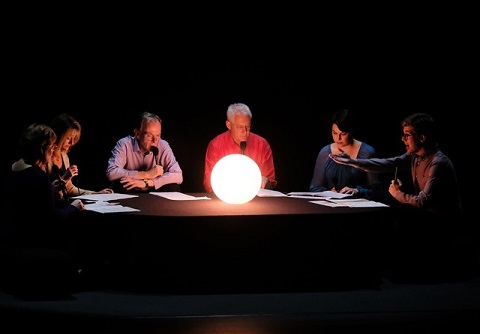 STIMMUNG. Photo credit: Mark Allan.
STIMMUNG. Photo credit: Mark Allan.
A masterpiece this work might be, but in a bad performance it can be a very dull masterpiece. I found the six voices - three female, and three male - to be almost perfectly in tune with what each was doing: singers were able to find an identity, a requisite in this work, and then pass it on so the performance had a seamless quality to it. Tempos, rhythms and dynamics were almost universally shared between the sextet. Perhaps today, Stockhausen’s actual text for STIMMUNG - with its erotic and intimate love poems - doesn’t raise quite the same sense of surprise it might have in 1967/8 any more than one would find the poetry or drawings of Verlaine or Cocteau risky; in this sense, the work sounds a little dated. The staging for STIMMUNG was as it usually is - a bright globe on a table with the singers placed around it. If in this particular instance this had the feeling of Leonardo’s Last Supper this was probably not by design. The only occasional problem during the performance was some microphone glare through the speakers at the sides of the auditorium but this was barely loud enough to cause a significant problem.
 COSMIC PULSES. Photo credit: Mark Allan.
COSMIC PULSES. Photo credit: Mark Allan.
The intimacy of STIMMUNG before the interval had been memorable, but the pyroclastic explosion of sound that is COSMIC PULSES was on a different level entirely. Composed in 2006/7 as part of the incomplete KLANG cycle, based on the 24 hours of the day, COSMIC PULSES, is the thirteenth hour. Musically, in its most basic sense, it’s twenty-four melodic loops, each of which has a different number of registers between one and twenty-four, rotated in twenty-four registers between a range of seven octaves. The loops are then layered on each other in a sequence from low to high, and slow to fast - and then they repeat and end one another in the same order until the work ends in desolation as if the universe has imploded on itself. They are played through eight speakers giving a sense of dynamic, surround sound.
The cleverness behind COSMIC PULSES is multi-fold. Stockhausen could simply have done nothing with the sound other than left it pure - but he doesn’t. The tempi are given accelerandi and ritardandi - just as the electro-acoustic melody is pushed upwards and downwards, elastically stretched to breaking point, sounding at times like electronic glissandi. The greatness of the work is that huge blocks of electronic sound have an almost neo-classical form to them. I remain unconvinced I heard everything as intended, but the spatialisation of the work was more dramatic than I have encountered on the CD recording of the work, for example. Visually, of course, looking straight ahead at an empty black stage is rather like peering into a black hole. The eyes are drawn up to fan-belts of lasers that spin and loop to the changes of the tempo. Did Robert Henke’s laser projection add anything to the performance? I think yes because it underscored the work’s planetary sculpture. This was certainly an unforgettable experience.
Marc Bridle
Singcircle - Gregory Rose - bass, Jacqueline Barron - soprano, Zoë Freedman - soprano, Heather Cairncross - mezzo, Guy Elliott - tenor, Angus Smith - tenor.
Robert Henke - laser artist, Kathlinka Pasveer - sound projection, Stephen Montague - assistant sound projection, Reinhard Klose - sound engineer.
Barbican Hall, London; 20th November 2017.
image=http://www.operatoday.com/Cosmic_Pulses_Barbican_141_preview.jpg image_description=Stockhausen’s Cosmic Pulses and Stimmung, Singcircle at the Barbican product=yes product_title=Stockhausen’s Cosmic Pulses and Stimmung, Singcircle at the Barbican product_by=A review by Marc Bridle product_id= Above: Cosmic PulsesPhoto credit: Mark Allan
November 21, 2017
Bampton Classical Opera Young Singers’ Competition 2017 - Winner Announced
The decision was reached after an exciting final on Sunday 19 November at the Holywell Music Room, Oxford. The adjudicators were renowned British singers Bonaventura Bottone and Jean Rigby. Conductor and accompanist from the Royal Opera House, Paul Wynne Griffiths, was an additional adjudicator in the preliminary rounds.
Emma is awarded £1,500 and Wagner £600. Keval Shah is awarded £500.
This biennial competition was first launched in 2013 to celebrate Bampton Classical Opera’s 20th birthday, and is aimed at identifying the finest emerging singers currently studying or working in the UK. 58 young singers aged between 21 and 32 entered this year’s Competition, and 22 were selected by the judges to progress through to the first (closed) round. From this, six singers were chosen to compete at the public final in the Holywell Music Room. The finalists were Corinne Cowling (soprano), Kamilla Dunstan (mezzo-soprano), Wagner Moreira (tenor), Emma Stannard (mezzo-soprano), Samuel Pantcheff (baritone) and Olivia Warburton (mezzo-soprano).
Emma’s varied programme included ‘Que fais tu blanche tourterelle’ (from Gounod’s Roméo et Juliette); Belsatzar, Op.57 (Schumann); ‘Parto, parto’ (from Mozart’s La clemenza di Tito); ‘The Highland Balou’ (from Britten’s Charm of Lullabies); ‘Polo’ (from de Falla’s 7 canciones populares españolas).
The judges were impressed with Emma’s overall performance, and her partnership with Keval Shah. Bonaventura Bottone said:
“We were looking for a well-chosen balanced programme where the singers engaged with the text creating the character and atmosphere of the pieces from the outset, sung within their vocal capabilities. Emma fulfilled this criteria in her prize-winning performance.
The balance of her performance was superbly supported by Keval Shah who underpinned Emma's programme with effortless musical poise.”
Emma Stannard recently completed her studies with Royal Academy Opera, under Yvonne Howard and Joseph Middleton. With RAO she performed the roles of Ruggiero (Alcina), Hanna (May Night), Poppea (L’incoronazione di Poppea) and Junon (Orphéeaux enfers). Emma has since performed the role of Minerva in Il ritorno d’UIisse and Pepa in Goyescas for Grange Festival, was a Britten-Pears Young Artist at the Aldeburgh Festival and toured the Verdi Requiem with Merry Opera Company. In January 2018, she will return to MOC as Cherubino in performances of Le nozze di Figaro. She is supported by Help Musicians UK.
Wagner Moreira is a member of Royal Academy Opera where he studies with Richard Berkeley-Steele and Iain Ledingham. He obtained a BMus degree from the Federal University of Minas Gerais and a MA from the Royal Academy of Music. He has performed the roles of Don Ottavio (Don Giovanni), Oebalus (Mozart’s Apollo et Hyacinthus), Basílio and Don Curzio (Le nozze di Fígaro), Secondo soldato in ( L’incoronazione di Poppea), Goro (Madama Butterfly) and Pluto in Orphée aux nfers. Recent concerts include Mozart’s Requiem and Coronation Mass, Beethoven’s Mass in C and Ninth Symphony, Haydn’s Nelson Mass, Handel’s Messiah and Bach’s St John Passion.
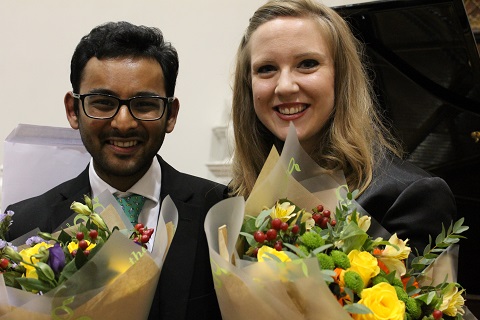 Keval Shah (winner accompanists' prize) with Emma Stannard (winner Bampton Young Singers' Competition 2017).
Keval Shah (winner accompanists' prize) with Emma Stannard (winner Bampton Young Singers' Competition 2017).
Winner of the 2017 Oxford Lieder Young Artist Platform, Keval Shah performs extensively as a song accompanist, with recent appearances including Aldeburgh, Edinburgh Fringe, Oxford Lieder and Leeds Lieder Festivals. He studied at Trinity Hall, Cambridge and the Royal Academy of Music, graduating from both institutions with Distinction, and is currently a Fellow at the Academy. Engagements in 2017/18 include Wolf’s complete Mörike Lieder and Italienisches Liederbuch, and debut recitals at the Wigmore Hall, St John’s Smith Square and at the Heidelberger Frühling. Keval is an Oxford Lieder Young Artist and a Britten Pears Young Artist, and is grateful for the support of the Winifred Christie Trust, Countess of Munster Musical Trust and the Viola Tunnard Memorial Trust.
Looking ahead to 2018, Bampton Classical Opera’s 25th anniversary season opens with a concert on 7th March to celebrate the legendary soprano Nancy Storace. Anglo-Italian soprano Nancy Storace (1765-1817) was renowned for her vocal prowess and remarkable stage presence, enjoying a glittering career across Europe. Recruited for the Emperor Joseph II’s new Italian opera company in Vienna, she came to the notice of the leading composers of the day, above all Mozart who created the role of Susanna in Le nozze di Figaro specifically for her. Bampton Classical Opera marks the bicentenary of her death with an appealing concert of music associated with her, including arias sung by rising star Jacquelyn Stucker, currently a Jette Parker Young Artist at the Royal Opera.
BCO’s summer production will be Nicolo Isouard’s Cinderella, the hugely popular predecessor to Rossini’s version, thereby continuing Bampton’s remarkable exploration of rarities from the classical period. Isouard died in Paris in 1818 and so this new production also marks his bicentenary. Born in Malta in 1773, Isouard was renowned across Europe, composing around 42 operas, many of which were published and widely performed. As a young man and following the success of his first operas which were performed in Italy, Isouard became director of the Teatru Manoel in Valletta, Malta. Moving to Paris in 1799, Cendrillon of 1810 was one of his many successes at the Opéra-Comique and was performed across Europe to huge acclaim, and especially in Germany and Austria, until knocked off its perch by Rossini’s La Cenerentola in 1817.
Cendrillon is designated as an Opéra Féerie, and is in three acts, to a libretto by Charles Guillaume Etienne, after the fairy-tale by Charles Perrault. The Bampton production will be sung in a new English translation by Gilly French and Jeremy Gray. With his gifts for unaffected melody, a sharp sense of parody in the music for the step-sisters, several appealing ensembles and always beguiling orchestration, Isouard’s Cinderella is ripe for rediscovery. Performances will be conducted by Harry Sever and directed by Jeremy Gray:
The Deanery Garden, Bampton, Oxfordshire: Friday, Saturday 20, 21 July 2018
The Orangery Theatre, Westonbirt School, Gloucestershire: Monday 27 August
2018
St John’s Smith Square, London: Tuesday 18 September 2018
Il sogno di Scipione: a new recording from Classical Opera
This one-act serenata drammatica was thought to have been commissioned to celebrate the installation of Hieronymus, Count Colloredo, as Archbishop of Salzburg in spring 1772 but, after ultra-violet testing revealed that in the recitative leading to the dedicatory licenza the name ‘Girolamo’ (Italian for Hieronymus) had supplanted the erased ‘Sigismondo’, this opinion was revised. [1] The work is now believed to have been commissioned the preceding year by the then Archbishop, Sigismund von Schrattenbach. When Schrattenbach died unexpectedly in December 1771, the fifteen-year-old Mozart altered the dedication and date of composition, and replaced the original licenza with a longer and more florid honorific conclusion. (Classical Opera perform this second licenza, but provide the original as an appendix.) In any case, there is no documentary evidence that it was ever performed, in part or in its entirety, and the first performance is generally held to be that given in Salzburg in January 1979.
Il sogno di Scipione is light on action and heavy on allegory. Metastasio’s libretto, drawing on Cicero’s tale of the Roman general Scipio Aemilianus, presents the dilemma faced by Scipio who, falling into a deep sleep, dreams that he is visited by two goddesses, Fortuna and Costanza, who each implore him to choose them to be his sole guide as he fulfils his duty to complete the destruction of Carthage. Fortuna beguiles him with the thrills offered by chance. Costanza transports him to the heavens where he is confronted by the spirits of Roman generals of yore, among them the ghosts of his father, Emilio, and adoptive grandfather, Publio. His forebears offer their advice but tell him he must make his own choice. To Fortuna’s fury, Scipio elects to follow constancy; she throws him back down to earth where, with this right and proper conclusion to the moral quandary, Licenza appears and pays homage to the Archbishop.
The six roles are all assigned to high voices (three sopranos and three tenors), and Page has been fortunate to be able to call upon a talented young cast comprising Classical Opera Associate Artists soprano Soraya Mafi (Fortuna) and tenor Stuart Jackson (Scipio), alongside four other gifted young singers - sopranos Klara Ek (Costanza) and Chiara Skerath (Licenza) and tenors Krystian Adam (Publio) and Robert Murray (Emilio). For, the bravura demands of the da capo arias are considerable and sustained.
Soraya Mafi conveys the full extent of Fortuna’s tempestuous unpredictability in ‘Lieve sono al par del vento’ (I am capricious as the wind): the florid curlicues are rhythmically even, the pitch spot-on, and the tone sparkles. She evinces a core strength of sound, and considerable lung-power, to sail through the extended runs and emerge gleaming at the top. In Fortuna’s Act 2 ‘A chi serena io miro’ the sweetness of the violins speaks of her duplicity and manipulativeness, while the vocal line really glistens. The enchanting triplets are supple and seductive, but the brief, indignant B-section tells us all we need to know about the perils of meddling with Fortune, while Mafi’s suavity of tone and phrasing confirms Fortuna’s egoism in the da capo repeat.
Klara Ek brings a thrilling brightness and muscular agility to the role of Costanza. The sound is pure and direct in ‘Ciglio che al sol di gira’ (The eye that turns to the sun) as she warns Scipio against the excesses offered by Fortuna, which will dazzle him, disguising her danger: the graceful violin playing adds significantly to the earnestness of the vocal expression. If Ek’s trills are not quite so shapely as those of Mafi, then she admirable enormous stamina; and if the final cadential decoration is rather extended and not entirely idiomatic, then the radiant stratospherics are impressive and one might forgive such indulgence in a dramatic context. Ek’s diction is excellent in the bravura show-piece aria ‘Biancheggia in mar lo scoglio’ (The rock turns white in the sea), in which Costanza asserts her case that she alone can ‘impose limits and laws on her dreaded empire’: we can hear the incipient seeds of the determination and intransigency the Queen of the Night, Kostanze and Fiordiligi - we know that this Costanza will not give up.
As Scipio, in his first recitative Stuart Jackson sounds genuinely bewildered to have been woken and confronted by a divine duo - an amazement expressed by the accomplished vocal vaults, some of which take the ear by surprise, florid runs and rhetorical trills of his opening aria, ‘Risolver non osa’ (My confused mind). Jackson’s coloratura is not quite as pristine as that of his female implorers, though the interpolated extravagances at the close do impress; but, the tenor certainly captures Scipio’s conflicting confusion and majesty, and launches with confidence at the mountainous peaks. In Act 2’s climactic ‘Di’ che sei l’arbitra’ (You say you are the arbiter), Page is sensitive regarding tempo and dynamics but Jackson’s fioratura is not consistently centred and the intonation wanders at times. That said, he does create a convincing three-dimensional character and in the more lyrical passages the vocal warmth and appeal is unwavering.
Krystian Adam’s Publio is dignified and earnest in the long recitative in which he urges his grandson to remember his responsibilities to his family, to history and to his present subjects. Adam convincingly suggests experience, maturity and wisdom: in his aria, ‘Se vuoi che te raccolgano’ (If you wish these realms to welcome you), imposing brass imply his former might but the vocal line is itself sensitively shaped, replete with strong emotion which will surely touch his grandson’s heart and conscience. The coloratura is lightly negotiated; there is never a sense of an old man huffing and puffing, and if a little more baritonal colour might have deepened the characterisation further, then this was in evidence in Publio’s fluently unfolding Act 2 aria, complemented by vibrant strings and propulsive horns.
Robert Murray displays a fittingly youthful ring and crispness as Emilio, which is complemented in ‘Voi colaggiù ridete’ (Down there you laugh) by some lovely interjections from the flutes and violins; indeed, I wonder if Emilio does not come across as rather too sympathetic here - after all, the father is taunting his son’s, and all mortals’, presumption and pride? But, in the B-section of the aria Murray finds a brusqueness - ‘Up here we laugh at you,/for at the end of your days, when your hair is all white/you are still children’ - which briefly suggests contempt and a warning born from undoubted love for his son.
Chiara Skerath floats through the lovely extended, florid phrases of Licenza’s ‘Ah perchè cercar degg’io’ (Ah why should I search), in which her timbral variety is complemented by woodwind and horns. And, the Chorus of Heroes would undoubtedly have given Scipio a shock upon his arrival in heaven! A triumphant wall of sound greets him, the trumpet’s flourishes of glory cutting through the massed choral ensemble (which is admittedly not the young Mozart’s most inspired effort - though there are a few tricks borrowed from Handel).
The Orchestra of Classical Opera plays stylishly for Page, and with plenty of character and spirit. The Overture skips fleetly along, punctuated by ceremonial punch from brightly ringing horns and trumpets. The string articulation is incisive and clean; the woodwind offer piquant hues and, in the slower triple-time section that concludes the overture, blend beguilingly - no wonder Scipio is lulled into comforting oblivion. The tuttis conjure excitement and drama, and Page makes effective use of the modulatory twists. In the ensuing arias, the ambitious young Mozart loads his instrumental parts with copious detail and Page - and the Signum engineers - makes sure that we hear them all, but also that busyness does not become weightiness. To take an early example, just a few bars into Scipio’s first aria, the second violins find themselves breezing delicately through rapid arpeggio figuration. Page moves with fluency between the varied tempi and moods of the individual arias and the light touch continuo keeps the secco recitatives moving along. The single accompanied recitative - when Scipio resists Fortuna’s blasts of light and upturned spheres, and feels Constancy’s ‘divinity’ infusing his breast - is brilliantly crafted. This number finds Jackson at his best too: his tone is forthright, plosive consonants giving way to first gentility and assurance, and finally noble confidence. This is stirring musical theatre.
The CD-booklet presents a complete libretto, with English translation. And, Page provides an engaging and informative account of the contextual background and the composition of the work, as well as drawing attention to striking features of the libretto and score. As always, there is no doubting Page’s commitment and he writes persuasively and with evident passion and pleasure about the telling details which reveal the teenage Mozart’s ‘dramatic genius’, such as the musical representation of Scipio’s dream-swept progress into Elysium and his subsequent re-awakening.
Could Il sogno di Scipione ‘work’ in the theatre? When Christopher Alden offered the US its stage premiere of the work - with Henry Street Chamber Opera (now Gotham Chamber Opera) conducted by Neal Goren - his spicy modern-dress production was praised (in Opera News, August 2001), for its ‘valiant’ attempt to bring life to a drama which is ‘forbiddingly inert’. A 2006 Salzburg production, directed by Michael Sturminger and conducted by Robin Ticciati was felt by Brian Robins ( Fanfare, July 2007) to have musical merits but to suffer from ‘idiotic direction’. Judith Weir must have considered the work to have innate dramatic potential when in 1991 she adapted Mozart’s serenata for her 30-minute chamber opera Scipio’s Dream. [2]
Perhaps Page and Classical Opera will one day give UK audiences the opportunity to judge for ourselves. In the meantime, the characterful music-making on this recording offers substantial musical enjoyment.
Claire Seymour
Mozart: Il sogno di Scipione K.126
Classical Opera - Ian Page (conductor)
Scipione - Stuart Jackson, Costanza - Klara Ek, Fortuna - Soraya Mafi, Publio - Krystian Adam, Emilio - Robert Murray, Licenza - Chiara Skerath, The Choir and Orchestra of Classical Opera.
[1] A detailed account of the work’s origins can be found in E.T. Glasow’s review of the 2001 recording by the Freiburg Baroque Orchestra under conductor Gottfried von der Goltzin, in The Opera Quarterly, Autumn 2001, Vol.17(4), pp.739-743. Glasow also suggests that it was the association of Mozart’s azione teatrale with the Archbishop who later dismissed Mozart from his service, that led to its negative reception by musicologists who scorned it as ‘that wretched piece’ (Alfred Einstein, Mozart: His Character, His Work) and ‘formal and uninspired’ (Edward J. Dent, Mozart’s Operas: A Critical Study).
[2] This chamber opera, written in collaboration with Margaret Williams, was commissioned by the BBC and AVRO Holland as a television film in the Not Mozart series.
November 20, 2017
Nico Muhly's Marnie at ENO
It’s little wonder Alfred Hitchcock was attracted to the book for his 1964 film - though he changed much. Hitchcock gave his film a more optimistic ending, and changed the setting to the United States, but in doing so stunned his viewers with an almost 1920s Germanic Expressionist take on the story. There is a sense of Gothic horror to Hitchcock’s film - not one vindicated by the novel - but in part it helps explain the Jungian and Freudian despair and angst of the anti-heroine. At times, the film seems almost to be filtered through a veil of blood-curdling red or flashes of lightening. This is the apotheosis of anti-Romanticism, anti-love, where rape and brutal sexual mores become almost normalised.
That Nico Muhly had so much thematic material to draw on for his opera is a given, though it’s questionable he’s really used the material well. He has chosen, with his librettist Nicholas Wright, to return largely to Graham’s novel and its deep class divisions, and this certainly works for the ending where Marnie’s redemption is to be found in her acceptance of her fate as she faces arrest, and probable imprisonment, for her thefts. Likewise, we are back in a Britain of circa 1959 with its gloomy, Lowryesque landscapes that seem as suffocating and repressed as most of the sexual manners of the characters the composer and his librettist have drawn so unflatteringly. It is rare in an opera to find oneself feeling a lack of empathy for any of the characters in it - but Muhly and Wright have succeeded in doing just that. From Marnie herself, to the domineering Mrs Rutland, who owes much to Britten’s Mrs Sedley, the twisted Mark and his equally rapacious brother these are people who lie to themselves, each other and us. These are characters trying to find their own complex, emotional landscapes in a brutalist, post-war urban industrial world that has almost no disconnect from their behaviour towards each other.
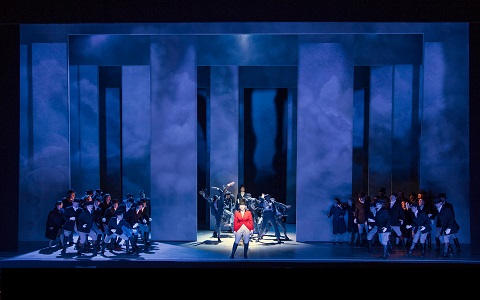 Cast of Marnie. Photo Credit: Richard Hubert Smith..
Cast of Marnie. Photo Credit: Richard Hubert Smith..
Whilst there is much that is beautiful in Muhly’s opera - the Hunting Scene is a real operatic and musical tour de force but it is almost the only one - too much of it gravitates towards past operatic influences rather than having anything new to say. If Muhly’s musical language, minimalist though it can sometimes be, sounds distinctly his own, the use of the woodwind, with individual instruments mirroring characters on stage, feels like Debussy. The Britten of Peter Grimes hangs like a huge and obvious shadow, especially in the musically weaker first act - notably in the choruses. Janaček’s The Makropoulos Case and Shostakovich’s Lady Macbeth of Mtensk provide more subtle musical and dramatic influences. The scale of Muhly’s writing, too, tends towards a more chamber-sized orchestration and eschews much of the demi-Romanticised writing that Bernard Herrmann used for his Hitchcock score. In part this works because this isn’t a love story in any conventional sense - but neither is Muhly’s score haunting, or tense or psychologically deep. It’s rare for the music to act as a catalyst for drama in much of this opera. The upside to this is that voices aren’t drowned out by the scoring, though that is not to say clarity wasn’t an issue. At times it was.
Where Marnie is an unqualified triumph is in its direction and sets. Michael Mayer, Julian Crouch and 59 Productions have created a set that is clever, drives the narrative and entirely seduces the eye in one’s visual experience of this opera. It doesn’t necessarily replicate Hitchcock’s film, but it owes much to the influence of Hitchcock’s mastery of cinematography nevertheless. Certainly having a stage as large as that at the Coliseum, with its width and depth, allows for a genuinely widescreen presentation so the hunt, for example, with filmed galloping horses and on-stage percussion, with Marnie herself in the centre as the focus, was a moment of high drama in an opera that sometimes felt drawn out, especially in Act I. The cleverness wasn’t that the staging recalled the Hitchcock of his 1964 Marnie, it was that it threw up comparisons to his earlier film Psycho - especially Saul Bass’s opening title sequence with its sharp perpendicular lines, and the use of bars or panels to highlight the fragmented psychosis of Marnie herself. The use of four “Marnie Shadows”, dressed in different colour dresses to the central character herself, in a psychiatrist scene in Act II, are a further extension of this Jungian neurosis that try to take us deep inside the deeply fragmented mind of our anti-heroine: split-screens, split personalities.
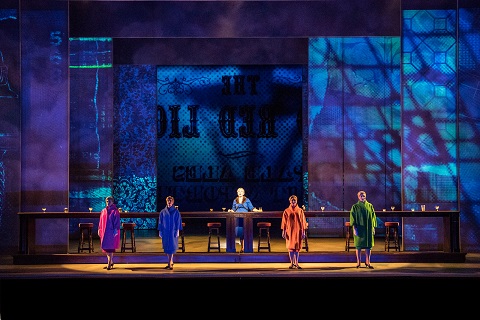 Charlotte Beament, Katie Stevenson, Sasha Cooke, Emma Kerr and Katie Stevenson. Photo Credit: Richard Hubert Smith.
Charlotte Beament, Katie Stevenson, Sasha Cooke, Emma Kerr and Katie Stevenson. Photo Credit: Richard Hubert Smith.
Arguably, a British audience might have had some problem identifying the shadowy, blackened skyline as London - but a New York audience, when this production transfers to the Metropolitan Opera next year, will have less of a problem with its greyed-out skyscrapers and smoky exteriors. Whilst exteriors create some element of debate as to place, interiors are universal - an office is anodyne and functional wherever its geography. Just as the initial backdrop of London conveyed the image of Lowry, so did the choruses tightly packed together like a crowd in certain quarters of the stage for their scenes - and there was more than a hint towards the surrealism of Magritte in the troupe of nattily-dressed, male, trilby-hatted dancers. Just as in Magritte’s painting, the Son of Man, distended joints of an arm were articulated in rigid dance movements - and as in the painting the backdrop on the scenery was replicated by moving clouds.
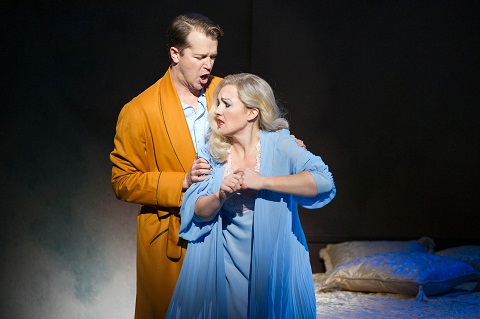 Sasha Cooke and Daniel Okulitch. Photo Credit: Richard Hubert Smith.
Sasha Cooke and Daniel Okulitch. Photo Credit: Richard Hubert Smith.
Casting for Marnie was largely first rate, though this is an opera that doesn’t rely on a huge ensemble cast - perhaps underscoring its minimalist credentials. The American mezzo, Sasha Cooke, sang the lead role with both insight into her character’s many psychological torments and her sexual neuroses. If there was a significant problem, it was that she sometimes seemed to allow herself to be swamped by the stage - but this could be a virtue in her vulnerability that was all too apparent. She was magnificent in the hunting scene where she seemed to become the vixen and held the centre of the stage superbly here - especially when there was so much else to catch the eye. A lesser singer - and actress - would have been quite overwhelmed by this scene. Daniel Okulitch as Mark had no such problems with his strong, clear voice and of all singers had the most crystal-clear diction - though the role is not an attractive one, especially as written in the novel. One did feel the sexually dark side of Mark had been significantly underplayed in this production - but that can hardly be blamed on the singer. The counter-tenor, James Laing, brought hefty contrast to the sheer beauty of his voice and the wonderfully predatory nature of his character, Terry. Lesley Garrett, as the overbearing Mrs Rutland, was sonically dominant - and gleeful in the transparency of her innate malevolence. The chorus were outstanding, and in an opera that is more cameo driven than usual this was a bonus. The ENO Orchestra, under their Music Director, Martyn Brabbins, played well.
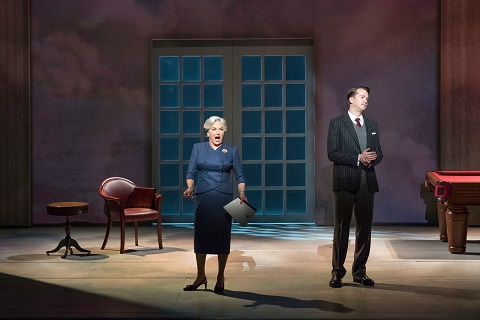 Lesley Garrett and Daniel Okulitch. Photo Credit: Richard Hubert Smith.
Lesley Garrett and Daniel Okulitch. Photo Credit: Richard Hubert Smith.
Marnie is, I think, a bit of a curate’s egg. On the one hand, it isn’t sufficiently gripping as either opera or theatre for it to find a place in the modern repertoire, or bear repeated listening. There are undeniable beauties in places - some of Muhly’s score is deft, even clever - but they go skin deep only. If you really want to experience the intensity of psychological opera Richard Strauss achieved the very pinnacle of this more than a century ago. It tries to delve deep into the mind of a scarred and flawed woman, and the people in her life, but barely scratches the surface. The thinness of the orchestration, the lack of great operatic moments, the inability to develop character are often fatal. On the other hand, there is no question that visually it is stunning to see - but this is only half the point of opera. Or, no point at all.
The performance on 1st December will be recorded and broadcast on BBC Radio 3 on 9th December.
Marc Bridle
Nico Muhly: Marnie (libretto by Nicholas Wright)
Marnie - Sasha Cooke, Mark Rutland - Daniel Okulitch, Terry Rutland - James Laing, Mrs Rutland - Lesley Garrett, Marnie’s Mother - Kathleen Wilkinson, Lucy - Diana Montague, Mr Strutt - Alasdair Elliott; Martin Mayar (director), Martyn Brabbins (conductor), Julian Crouch and 59 Productions (set and projection designs), Arianne Phillips (costume), ENO Orchestra and Chorus.
English National Opera, London Coliseum; Saturday 18th November 2017.
image=http://www.operatoday.com/Dancers%20and%20Sasha%20Cooke.jpg image_description=Marnie, English National Opera product=yes product_title=Marnie, English National Opera product_by=A review by Marc Bridle product_id=Above: Sasha Cooke (Marnie)Photo credit: Richard Hubert Smith
November 14, 2017
TOSCA: A Dramatic Sing-Fest
Strong voiced Zachary Owen opened the performance as the escaping political prisoner Angelotti. Director Fairloth made sure we understood the fine points of her story as the escapee found the key to his family’s side altar and the woman’s clothes that his sister had left for him to use as a disguise. Inadvertently, the painter, Cavaradossi, let the police know that Angelotti’s sister, the Marquesa has been in the church because he painted her portrait there. As Cavaradossi, Marco Cammarota, sang is his picture aria with gorgeous high notes that should point his way to many more renditions of this role. Scarpia, the Chief of Police, used the same picture to rouse Tosca’s jealousy and to make her his “buon falco” or hunting bird.
Costume Designers Andrew Marlay and Heidi Ganser dressed Cavaradossi in simple working clothes for the first act, while Tosca had a gown of soft fabric that said little about her prestigious place in society. The conservative-minded Sacristan, too, was clad in neutral colors as he dialogued with the left-leaning painter. Visually, The red-clad choir singers showed the importance of the Church in that era as their presence contrasted with that of black-garbed Scarpia for the first act’s final Te Deum.
As Scarpia, Aleksey Bogdanov sang with resounding tones that carried through the Te Deum’s heavy orchestration. Conductor Stephen White included a canon sound as part of the orchestral bass and it served to contrast religious ritual with governmental action. The finale of Act One played out with exquisite taste as Scarpia’s henchmen, Sciarrone and Spoletta, underscored his evil.
Act two, Scarpia’s dinner hour, shows us more of his preference for violent conquests. He tortured Tosca’s lover so that she could hear his screams, after which he made her betrayal known. Cammarota’s “Victoria” gave us some fine examples of his sturdy and beauteous high notes. The Tosca, Marcy Stonikas, clad in jewels and blood-red velvet, pulled at the audience’s heart strings when she sang her aria asking God why he rewards her prayers and sacrifices with torture.
All three principals were outstanding in this act. Stonikas, Cammarota, and Bogdanov are three young singers from whom a great deal more can be expected in the future. Having bargained for her lover’s life, Tosca picked up a sharp knife and held it within the folds of her gown so she could to stab her oppressor when he tried to embrace her. Director Faircloth ended the act in the traditional manner. Tosca placed candles on either side of and a crucifix on top of the body.
Soprano Katrina Galka sang sweetly as the Shepherd Boy addressing the cool Roman night. Cammarota’s “É lucevan le stelle” made us all think about the value of life when only a few hours remain. Stonikas showed her dramatic ability, her resilience, and her easy high notes before declaring her intent to meet Scarpia before God.
Conductor Steven White drew dramatic, veristic playing from the Arizona Opera Orchestra. His interpretation gave the singers the melodic accompaniment as well as the space needed to perform at their best. The opera was both a sing fest for fine young voices and a dramatic thriller. It was the best Tosca I had seen in quite a few years.
Maria Nockin
Cast and production information:
Conductor, Stephen White; Director, Tara Faircloth; Set Designer, Ercole Somani; Costume Designers, Andrew Marlay and Heidi Ganser; Fight Director Andrea Robertson; Lighting Designer, Gregory Allen Hirsch; Chorus Master, Henri Venanzi; Floria Tosca, Marcy Stonikas; Mario Cavardossi, Marco Cammarota; Baron Scarpia, Aleksey Bogdanov; Angelotti and Jailer, Zachary Owen; Sacristan, Ricardo Lugo; Spoletta, Anthony Ciaramitaro; Sciarrone, Jarett Porter; Shepherd, Katrina Galka; Roberti, Gil Berry.
Alternate Cast: Tosca, Kara Shay Thompson; Cavardossi, Rafael Davila; Scarpia, Gordon Hawkins.
image=http://www.operatoday.com/Marcy-Stonikas-head-shot1.png
image_description=Marcy Stonikas [Photo courtesy of Fletcher Artist Management]
product=yes
product_title=TOSCA: A Dramatic Sing-Fest
product_by=A review by Maria Nockin
product_id=Above: Marcy Stonikas [Photo courtesy of Fletcher Artist Management]
November 12, 2017
The Lighthouse: Shadwell Opera at Hackney Showroom
Henry James’s Preface to his novella The Turn of the Screw would make a fitting epigraph to Peter Maxwell Davies’s 1979 chamber opera, The Lighthouse, which presents the legend of the disappearance of three lighthouse-keepers at Eilean Mòr of the Flannan Isles in the Outer Hebrides in December 1900. Conducting a routine tour, the supply ship, Hesperus, was surprised to find no one waiting on the jetty; inside the lighthouse, dishevelled beds and an open front door seemed to suggest that the inhabitants had left in a hurry and would shortly return. The light, though functioning, was out; the last log entry had been made at 9am on 15th December. The three men had simply vanished into thin air.
Indeed, in an interview shortly after the opera was first performed, Davies himself acknowledged the unfathomability of the mystery: ‘One night the light failed, and when the investigators came, the three lighthouse keepers were simply gone, with no explanation whatsoever … I've found that audience members all have their own interpretations as to what may have happened. Most agree, however, that, whatever it was, it was pretty extraordinary, even cataclysmic.’ With Jamesian mischief, he added, ‘I’ve left a few clues - some of them contradictory - but for the most part, it’s up to the audience to find out what went on’.
Storms, freak accidents and other surmises remain just speculation. And, to paraphrase James, ‘the opera won’t tell’. But, Maxwell Davies draws upon and extends former operatic representations - such as Vaughan Williams’s Riders to the Sea, Ethyl Smyth’s The Wreckers and Britten’s Peter Grimes - of the irresistible tug of the tide which drags those whose lives depend upon the ocean towards madness and death.
Davies wrote his own libretto and described working in his cliff-top home in Rackwick on Hoy, looking at a seascape which must have confronted seafarers since time immemorial: ‘It was very stormy and very dramatic and I think it all helped in setting the atmosphere. I used a lot of noises from storms and from the sea in the work and I think the whole thing is quite rightly permeated by tensions which arrive out of extreme storm conditions at sea.’ [1] The composer had moved to the Orkney Islands in January 1971, seeking seclusion and respite from the noisy clamour of London life. Alongside, and consuming, the stillness and silence, the composer found the sea: the motions and music of the Atlantic Ocean and North Sea - and of the sea-birds and seals - were to shape his own compositional voice.
Hackney Showroom is a long way from the sea. But, in this austere room director Jack Furness and his designer Alex Berry skilfully evoke the claustrophobic intensity of extended isolation. Daniel Spreadborough’s strobe streaks and floodlight flashes sear through the prevailing darkness, incessantly startling and disorientating audience members hit by a sudden glare. Interestingly, the fifth of Davies’s ten Naxos Quartets is subtitled ‘Lighthouses of Orkney and Shetland’ in reference to, in the composer’s words, ‘not only the dramatic nocturnal sweep of a lighthouse beam across different textures of sea and shore, but to the various lighthouse “calls” - each one can be identified by the individual rhythms of its flashes of light’. [2] Spreadborough imitates such ‘calls’, creating constantly shifting patterns and surfaces - even projecting the fluttering movement of a small aquarium onto a rear wall - which, together with the complex transformations of Davies’s stark, sometimes ear-splitting, score create a world of portentous unrest.
In the Prologue, three officers from the supply ship present their testimonies before a Court of Inquiry in Edinburgh. Berry’s scaffolding makes for a rather abstract courtroom, but the sparseness suggests the disturbing ‘exposure’ of the men’s experiences in the courtroom. The solo horn (superbly played by Jonathan Farey, from the Showroom gallery) conducts an interrogation, the men’s replies offering retrospective clarification of the question posed; the unsettling dislocation is furthered by the discrepancies between the men’s accounts which infer omission or deception.
Taking the witness stand, like Grimes stepping up ‘into the dock’, tenor Paul Curievici offered a gripping narration of wide-eyed terror, though it was occasionally difficult to discern all the details of the evocative text: ‘In silence the ship peeled a steely-furrow from the shale-grey flatness, opening and closing an oily slit. The dawn a corpse-grey scowl.’ Baritone Pauls Putnins, balancing in turbulent light on the central scaffold, and bass Owain Browne, peering into the aquarium stage-left, interspersed more prosaic recollections, until the power of memory seemed to transport the three officers back to the lighthouse door, the ensemble reflections shifting between past and present tense. The voices combined resonantly to record the inquest’s conclusion: ‘death by misadventure’. The lighthouse, now automatic, has been abandoned: ‘its ghosts are shut in, sealed in, tight’.
The main action, subtitled, ‘The Cry of the Beast’, followed on without a break (originally Davies had stipulated a short intermission), as we slipped back in time and the three officers transformed into the lighthouse-keepers themselves, taking their seats at a kitchen table - the teapot an uncanny reminder of domesticity - in a centrally-placed ring. The three singers, who seemed untroubled by the virtuosic demands made upon them, created strongly individualised characters and intimated relationships as unstable and potentially volatile as the weather outside. The bible-thumping zealotry of Arthur (Putnins) infuriates Blazes (Browne), and Sandy (Curievici) struggles to keep the peace. They bicker edgily and squabble over a game of cribbage, as isolation, an undercurrent of sexual tension, and the incalculable vastness and violence of the ocean threaten to tip the men into madness.
Songs - stylistic pastiches and parodies of ballads and hymns - are sung in an effort to keep the tension at bay; and the vocal lyricism and brief harmonic steadiness does offer a contrast to the prevailing parlando which rockily rides the dissonant accompaniment. But, the songs bring back ghosts and guilt from the past. Browne truly ‘blazed’ in a violent account of abuse in which guttural splutterings and falsetto shrieks took us to the world of Davies’s Eight Songs for a Mad King. Putnins’ fire-and-brimstone bellowing boomed with terrifying might and menace, accompanied by strident brass. Curievici’s ardent, sweet-toned love song reached ecstatic heights and brought about some rapprochement.
But, like the water which (literally) sloshed around their ankles, the fear cannot be quelled. Even the revivalist hymn which is a collective chorus of defence becomes more fevered than fervent, as the men are gripped by the belief that a ‘beast’ is coming for them. Their insane terror escalates when they mistake the lights of the supply ship, which shine through the sea-mists, as the eyes of the ‘beast’.
At the close, a chaotic cacophony of sound and light engulfed the men, and us, bringing to a spine-chilling close the tremendously incisive performance by the 12-piece Shadwell Ensemble, conducted with precision and economy by Finnegan Downie Dear. The Ensemble conveyed every macabre twitching texture, and explosive flash and flicker - wind and wave, by turn an eerie whisper or wailing squall - of Davies’s score. The Ensemble was placed on the right-hand side of the studio space, the aim being to re-evaluate ‘the boundary between stage and orchestra pit which the stetting of a traditional opera house cannot provide’; and, it does indeed seem at times as if singers and players alike are being pitched and hurled by the ferocious ocean-scape which they are themselves creating.
The opera ends not with explanation but with enigma, although the repetition of the same music at the end of each part of the score might suggest a ‘twist’ worthy of An Inspector Calls or The Woman in Black. It doesn’t matter that, however resourceful the direction and design, the sharp tang of brine does not really permeate Hackney Showroom. We may not have been transported back to the Outer Hebrides in 1900, but we have been taken to dark places which, in James’s words, ‘reek with the air of Evil’, and at the close it’s the silence that is most terrifying.
Claire Seymour
Peter Maxwell Davies: The Lighthouse
Officer 1/Sandy - Paul Curievici, Officer 2/Blazes - Owain Browne, Officer 3/Arthur - Pauls Putnins; director - Jack Furness, conductor - Finnegan Downie Dear, designer - Alex Berry, lighting designer - Daniel Spreadborough, The Shadwell Ensemble.
Hackney Showroom, Hackney Downs Studios, London; Saturday 11th November 2017.
[1] Cited in Justin Vickers, ‘Peter Maxwell Davies’s variations on a theme: a catalog of the "sea" works’, Notes, 2015, Vol.71(4).
[2] In the liner note to the Maggini Quartet’s 2006 recording [Naxos].
Design credit: Rebecca Pitt
November 11, 2017
Julian Prégardien : Schubert, Wigmore Hall, London
Julian Prégardien has musical thinking in his genes, and it shows. His father's voice is a divine gift from God, but Julian, still only 33, has a gift for communication and, even rarer, an enthusiasm for music itself. Hence the wonderful Schubert Im gegenwärtigen Vergangenes, an unusual work where the lead tenor's part is demanding enough for a top-quality singer, but the song works best as a quartet. Prégardien's voice led, enhanced by the filigree created first as a duet with the second tenor Kieran Carrel - keep an ear out for him - further developed by the entry of the two baritones, Phil Wilcox and Niall Anderson. Schubert's multi-part songs are glorious : a pity they don't get more big-name singers and high-profile gigs. At the end of the recital, Prégardien was joined by Ben Goldscheider for Auf dem Strom D943 (1828, Rellstab). Valve horns were relatively new at the time, and Schubert's writing for the instrument tends to dominate the song, to the detriment of the voice part.
Im gegenwärtigen Vergangenes is based on one of Goethe's Hafiz poems from the West-östlicher Divan. Hence the theme Bilder aus Östen, highlighting the perfumed sensibility of Goethe's invocation of exotic, distant lands of imagination, an aesthetic particularly suited to lithe-toned tenors. Prégardien and Schnackertz began with the rar(ish) fragment Mahomets Gesang D549 (1817) following it with Versunken D715 (1821) where the piano part trills circular figures, as if, through the music, the poet is running his fingers through someone's curly locks. Prégardien brings out the flirtatious intimacy in the song, often lost in more formal "Germanic" baritone approaches. Perhaps the text might apply to fondling a child, but it could equally describe foreplay. Friedrich Rückert was even more of an orientalist than Goethe, and also translated Asian texts. His volume Östliche Rosen (1822), a response to the West-östlicher Divan. was his first of many forays into exoticism. Sei mir gegrüsst D741 (1822) with its lilting tenderness expresses feelings that could apply in any culture. The person being greeted is lost, but "zum Trotz der Ferne, die sich, feindlich trennend" the poet reaches out. Thus the gentle, rocking refrain. The tenderness in Prégardien's delivery suggests lullaby, a caress in music. Similarly, the unforced expressiveness in Prégardien's Dass sie hier gewesen D775 (1823), another Rückert setting where subtlety is of the essence.
A beautifully phrased Am See D124 (1814) led to four settings of Johan Peter Uz (1720-1796). Die Nacht D358, Gott im Frühlinge D 448 and An Chloen (fragment) D363, and Der gute Hirt D449, all from 1816. In a complete song series, someone has to draw the short straw, but Prégardien and Schnackertz gave the rather slight songs good treatment. For Uz, the shepherd in Der gut Hirt was clearly Jesus. For Schubert, the shepherd could be a generic Romantic shepherd. The piano part suggests elegant repose, with a typically Schubertian undertow. The alternating lines in the vocal part are fetching, too, sometimes soaring expansively, sometimes quietly reverent.
Hearing Schubert's Uz settings with his settings of Mayrhofer demonstrates the way Schubert responded to personal relationships as much as to poetry. Prégardien and Schnackertz brought out the delicacy of Geheimnis D491 (1816) which needs an intimate touch - it's about a secret, after all, a whisper, not a shout. In Schlaflied D527 (1817) the vocal line rocks from high to low, taxing the singer. Prégardien, fortunately, made the flow even, so it felt natural, like the movement of a cradle. Prégardien has a gift for songs that need sensitive treatment. He negotiates the changes, letting the line flow illuminated by an understanding of what the words mean, even when the texts aren't particularly distinguished. Lieder is poetry. If words had no meaning, the songs wouldn't be Lieder. The challenge is to grow an interpretation from within.
Then to the challenge of Atys D585 (1817) and Lied eines Schiffers an die Dioskuren D360 (1816) much more sophisticated songs, which gave Prégardien more opportunity to show dramatic power. These songs were/are his father's speciality: Prégardien père will never be equalled, nor should he be. Julian Prégardien gave the songs a personal touch, which I appreciated, for Lieder is about the individual and the way he or she reaches an audience. Being the child of someone so good and so well known is a double-edged sword. You grow up in a musical environment but you have to face pressures of expectation which other young singers aren't burdened with. To stand on the stage at the Wigmore Hall, scene of so many Christoph Prégardien triumphs, must be daunting indeed. That takes guts. Prégardien fils is very good and deserves to be respected for himself. Though he's still young, Prégardien has already forged a substantial career.
For his encore, Julian Prégardien sang Nacht und Träume D827 (1825, Matthäus von Collin), beautifully and masterfully executed, the long lines stretching expressively. I thought I saw a tear run down Prégardien's face, which someone else confirmed. We were touched. Nice to see a singer, not as an instrument, but as a human being.
Anne Ozorio
image+http://orfeo-artist-management.de/fileadmin/redakteure/images/Kuenstler/Pregardien/44_PREG_Borgggreve__2__Port._farbe_Hemd_Schal_vv.jpg
image_description=Julian Prégardien (Photo Marco Borggreve, courtesy Orfeo Arts Management)
product=yes
product_title=
product_by= Schubert Lieder : Julian Prégardien (tenor), Christoph Schnakertz (Piano), Ben Goldschieder(horn). Wigmore Hall, London, 7th November 2017
product_id=
price=
product_url=
November 10, 2017
Elisabeth Kulman sings Mahler's Rückert-Lieder with Sir Mark Elder and the Britten Sinfonia
Though this accident was ‘freakish’ (she suffered a blow to the throat), the consequences led Kulman to reassess the opera singer’s professional, personal and financial lot: she launched a campaign against the practice of not paying singers for rehearsals - meaning that illness or indisposition could result in a singer being financially unrewarded for their hard work and even, taking in accommodation and other costs, potentially facing substantial losses - and established Art But Fair, a lobby group for fair play. Kulman declared, ‘The opera business is an enormous enterprise. The individual’s room to move is relatively small. As an artist what concerns me is individual creativity, personal expression, individuality. Personally, I have discovered for myself that I am best able to develop my creative potential when I am able to work according to my own rules and not have to subordinate myself to other structures. It is not, therefore, a general criticism of the current opera business but rather recognition of the incompatibility of my personality’s makeup.’ ( translation from the German by Martin Snell).
Prior to this concert given by the Britten Sinfonia under Sir Mark Elder, at the Barbican Hall, I had not previously heard Kulman perform, in opera or concert. Her performance of Mahler’s Rückert-Lieder - a work which she presented with Elder and the Bergen Philharmonic Orchestra in September 2016 - was immaculate: her tone was even across the registers, the phrases were gracefully sculptured, the tone suggested the pliant plushness of the softest velvet. Refinement, delicacy, intimacy were the words which most readily sprang to mind.
But, despite the vocal polish and allure, this was a very ‘polite’ performance. I missed the range of emotions - which might be communicated through a varying timbre, for example - in the sequence of Rückert poems (not really a ‘cycle’), and Kulman did not communicate a sense of her personal connection to the texts, though the diction was pristine. There was peace but not passion: ‘Um Mitternacht’ (At midnight) surely traverses wider emotional terrain.
That said, Sir Mark Elder did exquisitely balance the intimate conversations within the small chamber orchestra, as at the start of ‘Blicker mir nicht in die Lieder!’ (Do not look into my songs!) when muted cello, clarinet oscillations, and flickering oboe and flute acciaccaturas formed a rarefied interplay, and the prominent, lyrical horn beautifully complemented the vocal line. ‘Ich atmet’ einen linden Duft’ (I breathed a gentle fragrance) floated on an airy bed of spare viola and violin meandering which allowed the woodwind motifs to sweetly make their mark, and the harp and celeste offered an ethereal closing flourish, evoking the heady piquancy of the ‘fragrance of line’.
Muted strings and the low-lying vocal line evoked a calm acceptance which might have shimmered with greater potential intensity at the start of ‘Ich bin der Welt abhanden gekommen’ (I am lost to the world). Kulman seemed to add vocal weight and fullness, though, to ‘Liebst du um Schönheit’ (If you love for beauty), as if reaching out from a world of quiet intimacy. But, ‘Um Mitternacht’ (At midnight) needed to scale more glistening vocal heights, to provide a counter-weight for the stirring bassoon contributions, the deliciously dark chromatic tuba and horn descents, and the heart-stirring rumbles of tuba, double bassoon and timpani towards the close. Kulman seemed oddly impassive amid such orchestral frissons: there was undeniable vocal beauty and taste, but where was the ardour, or even the animation?
This concert marked the start of a four-year project during which Elder and the Britten Sinfonia will explore the symphonies of Johannes Brahms (though, strictly, the opening of this series took place the previous evening in Norwich); alongside a Brahms symphony, a song-cycle by Mahler and a work by a British composer will throw Brahms’ ‘sound-world’ - which, in a podcast on the Britten Sinfonia website, Elder describes as warm but not thick, lithe but not bombastically heroic - into relief.
The second half of the concert thus comprised Brahms’ First Symphony, which Elder has not previously conducted. This was a delicate reading which foregrounded the woodwinds’ soothing, pure lyricism and subtle expressive gestures and in which the strings (at 10, 10, 8, 8, 4, perhaps not exactly ‘Classical’ in dimension) played with judicious use of vibrato and thoughtful phrasing. Indeed, there was a prevailing sense of ‘care’ and consideration, as Elder moved from a slightly unsettled first movement, through the contemplative middle movements, to well-judged ‘arrival’ and ‘resolution’ in the concluding, Allegro no troppo, ma con brio. There was an exciting and uplifting sense of joy in the final movement without the sound ever becoming self-indulgently or weightily pompous; and, one could sense the players’ intellectual and emotional engagement with the arguments that they were being asked to consider, explore and articulate.
Elder described (in the aforementioned podcast) the first half of the programme as a ‘Mahler sandwich’, and the concert began with Benjamin Britten’s arrangement of the second movement of Mahler’s Third Symphony, titled What the Wild Flowers Tell Me. Britten essentially reduced the extension orchestration of the original to a delicate chamber-like dialogue. In this performance, lyricism was complemented by rhythmic alertness, but the overall effect was one of restraint and Elder did not really establish a strong musical mien - though perhaps this is because this single emblem of Mahler’s monumental, magnificent work feels a little ‘adrift’ from its symphonic moorings.
As someone who believes that anything composed by Gerald Finzi is worth hearing, I was pleased to have the opportunity to enjoy the composer’s orchestral elegy, The Fall of the Leaf, written - like so many of Finzi’s works - over a period of many years, and first published in piano-duet form. Finzi’s close friend, composer Howard Ferguson, developed Finzi’s orchestral drafts, completing the ‘gaps’ left within the basic architectural form. Characteristically, Finzi communicates a restrained nostalgia and a melancholic poignancy that is at once lovely in its tenderness and heart-rending in its pathos. The initial flute solo was wonderfully pure - the expressiveness was equalled by the oboe’s subsequent dolefulness - but from these clean beginnings Elder drew ever greater warmth and soul. Despite my sympathetic leanings, I was not entirely convinced that the work has a structural ‘direction’, but the Britten Sinfonia injected colour - rich brass, shining cymbals - and rhythmic athleticism, through displacement and emphatic stresses. A heavy sadness lingered after the final dull thuds of quiet low strings, harp and bass drum had faded.
The reprise of this programme, in Saffron Waldon, will be broadcast on Radio 3 on 14th November .
Claire Seymour
Elisabeth Kulman (mezzo-soprano), Sir Mark Elder (conductor), Britten Sinfonia.
Mahler - (arr. Britten) What the Wild Flowers tell me; Finzi - The Fall of the Leaf Op.20; Mahler - Rückert-Lieder, Brahms - Symphony No.1 in C minor Op.68
Barbican Hall, London; Thursday 9th November 2017.
image=http://www.operatoday.com/Elisabeth%20Kulman%20sings%20Mahler%27s%20Ru_ckert%20Lieder%20with%20Britten%20Sinfonia%2C%20conducted%20by%20Sir%20Mark%20Elder%20photo%20credit%20%20%281%29.jpg image_description=Elisabeth Kulman, Sir Mark Elder and the Britten Sinfonia at the Barbican Hall product=yes product_title=Elisabeth Kulman, Sir Mark Elder and the Britten Sinfonia at the Barbican Hall product_by=A review by Claire Seymour product_id= Above: Elisabeth Kulman, with the Britten Sinfonia conducted by Sir Mark ElderPhoto credit: Mark Allan
November 9, 2017
Tremendous revival of Katie Mitchell's Lucia at the ROH
There were no pre-show warnings, as in 2016 , that the production contains scenes depicting ‘sexual acts’ and ‘violence’ - it’s hard to think of a nineteenth-century dramma tragico that doesn’t feature sex and violence - but while the dead bodies on the billiard table are still piled high, there seems rather less gore than I had remembered: neither blood vessels nor bathtub overflowed with such gruesome abandon. Lucia and Alisa still show an unhealthy enthusiasm when stabbing and asphyxiating the unsuspecting Arturo who, blindfolded by his apparently compliant new wife, is probably anticipating pillow games of a rather different nature. But, the leg-twitching of Arturo’s death throes was less exorbitantly prolonged, his fairly quick demise avoiding the uncomfortable guffaws prompted by last year’s extravagant expiration.
Vicki Mortimer’s detailed set remains divisive in several senses. Even the programme book synopsis is set out in two separate columns to delineate what is going on stage left and right, as the action unfolds in the public and private domains of the partitioned set, but there is still too much to take in in one visual sweep. There is always a sense that one is missing something, the scribbling of a letter, the fleeting suggestion of a ghostly presence, at the far edges of the production. And, I still found the mimed ‘business’, while visually embodying implied off-stage events, to be distracting. Lucia and Alisa, for example, are perennially preoccupied with changing Lucia’s clothing, whipping off frocks, tugging on trousers, adjusting corsets or hoops, pulling on dressing-gowns. It’s quite a ‘relief’ when Lucia is ‘stripped’ down to her bloodied night-dress, and the costume carousel is over.
The shallow set, its recesses quite dimly lit by Jon Clark, has a tendency to become crowded in the ensembles. The ROH Chorus are once again in tremendous voice, but they can do little more than position themselves like statues - around the graves in the crypt, behind the banqueting table and billiard table. Their Act 3 cry of horror, ‘We are frozen with terror’, prompted the thought that they hadn’t actually moved during the entire opera.
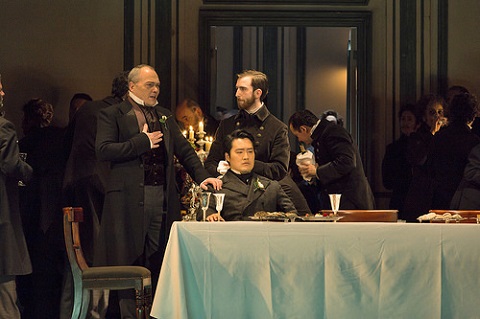 Christopher Maltman (Enrico) and Konu Kim (Arturo). Photo credit: Stephen Cummiskey.
Christopher Maltman (Enrico) and Konu Kim (Arturo). Photo credit: Stephen Cummiskey.
Despite these prevailing misgivings, though, this really was a tremendous performance, the principals offering stunning individual performances and responding to each other with absolute conviction and coherence. As the obsessive, unforgiving and over-bearing Enrico Ashton, Christopher Maltman thundered with dark-toned authority; it was no wonder that Lucia cowered and collapsed in the face of such ruthless intimidation. Occasionally Enrico’s pompous indignation veered dangerously close to ‘cartoon baddie’ territory, but Maltman’s clarion vocal clout was balanced with subtlety and nuance. The clarity of his characterisation also brought the political context neatly to the fore, without the historic grievances between the two Scottish clans ever intruding fussily upon the unfolding personal tragedies; we understood, and perhaps forgave at least in part, the driving rationale behind his domination of his sister and his determination to control her fate. The Wolf Crag confrontation between Enrico and Edgardo bristled and burned with the unresolved conflicts of the past.
Andrew Tortise’s Normanno matched Enrico for vengeful resolve, but Michele Pertusi’s Raimondo was a calmer complement. Pertusi’s Act 2 plea for Lucia to sacrifice herself for the good of her family and for heavenly reward, ‘Al ben de’ tuoi qual vittima’, was beautifully crafted, each phrase carefully measured. Raimondo’s evident sympathy increased our own.
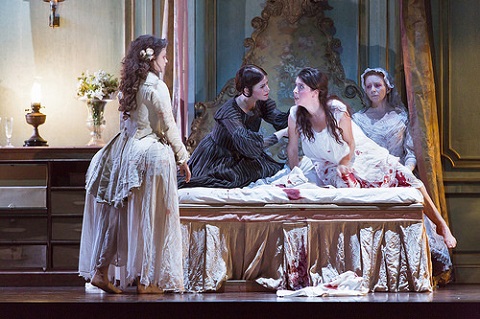 Rachael Lloyd (Alisa) and Lisette Oropesa (Lucia), framed by the ghosts of the murdered girl (Sacha Plaige) and Lucia’s mother (Sarah Northgraves). Photo credit: Stephen Cummiskey.
Rachael Lloyd (Alisa) and Lisette Oropesa (Lucia), framed by the ghosts of the murdered girl (Sacha Plaige) and Lucia’s mother (Sarah Northgraves). Photo credit: Stephen Cummiskey.
The phantoms of Ravenswoods and Ashtons past seemed to me to be even more omnipresent. The murdered girl inserted herself between the embracing Lucia and Edgardo, in the latter’s family crypt - though this was an improvement on the couple’s cliched carnality in 2016 - and appeared at precisely the same time as Edgardo at the wedding banquet, and the ubiquitous apparitions enhance our impression of Lucia’s derangement and mental distress.
Mitchell has declared her intent to make a ‘real woman’ of Lucia, one whose credible physical suffering prompts rebellious reaction and ultimately mental breakdown. There’s still ambiguity, though, whether the pallor and faintness that Lucia and the other characters draw attention to in Act 1 results from her morning sickness or from her brother’s threats and deceptions. Mitchell and Mortimer update the action to Donizetti’s 1830s, the decade which (she noted in 2016) was ‘a very important period for feminism with the Brontës and all those amazing women like Mary Anning who were early feminists, fossil-hunters and scientists’ - a nascent feminism which is further asserted by Mary Evans’ programme article for this revival. But, Cuban-American soprano Lisette Oropesa was appropriately tentative initially, capturing Lucia’s trepidation as she reflects on the ghostly glimmers which haunt her and the water of the fountain which turns blood-red.
Oropesa’s glinting soprano is fairly light but it grew warmly and expansively as Lucia’s distress deepened, and the crystalline precision and limpidness which I had admired at Glyndebourne this summer were again in notable evidence. As the sometimes cruel Norina in Mariame Clément’s Don Pasquale, Oropesa was a woman firmly in control of her own destiny but despite Mitchell’s avowal to make Lucia more feisty than faint-hearted, however much she wishes to challenge Enrico’s callousness Lucia’s destiny is undeniably ordained. She can ‘escape’ only into madness. In the ‘mad scene’, Oropesa was utterly broken but, to the soprano’s and Mitchell’s credit, this Lucia’s melodic meltdown was not an abstraction of disembodied madness but the terrible disintegrated of a real woman for whom we, and the stage witnesses, feel terrible sadness. Oropesa’s vocal purity returned Lucia to childlike vulnerability and victimhood.
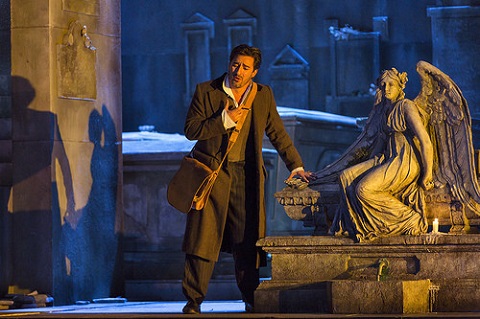 Charles Castronovo (Edgardo). Photo credit: Stephen Cummiskey.
Charles Castronovo (Edgardo). Photo credit: Stephen Cummiskey.
Returning to the role of Edgardo, Charles Castronovo impressed even more than in 2016, his tenor glowing first with ardency and a flawless legato, and then, in the banquet scene, with reproachful anger. His disruption of the wedding banquet was theatrically thrilling, and when he struck Lucia, for her imagined betrayal, it was hard not to flinch.
As Arturo, Konu Kim pushed his tenor a bit hard at the start, but he ironed out the occasional rough edge and gained more urbane control of the phrasing and line. Rachael Lloyd, returning as Alisa, displayed vocal evenness that was an appealing match for Oropesa’s clean sound.
Conductor Michele Mariotti carefully delineated the score’s detail. The woodwind, seated to the far left of the pit, made an eloquent, expressive contribution, and the melodism of the cellos’ and basses’ frequent pizzicato passages was emphasised. The lack of hyperbolic heft in no way diminished the emotional power of the orchestral delineation and commentary.
Castronovo’s ‘Tu che a Dio spiegasti l’ali’ stole the show last time round, but in this revival there was more genuine and tensely affecting feeling between Edgardo and Lucia, and while the romantic throbbing of the final scene was just as electric (and now undisturbed by histrionic wrist-slashing from Lucia), it seemed fitting that Edgardo should rise and rush to her side in her dying moments, so that their last breaths could be taken together.
Lucia di Lammermoor continues on selected dates until 27th November .
Claire Seymour
Donizetti: Lucia di Lammermoor
Lucia - Lisette Oropesa, Edgardo - Charles Castronovo, Enrico - Christopher Maltman, Normanno - Andrew Tortise, Arturo - Konu Kim, Alisa - Rachael Lloyd, Raimondo - Michele Pertusi, Enrico’s Servants - Abe Buckoke and Remi Rachuba, Ghost of Murdered Girl - Sacha Plaige, Ghost of Lucia’s Mother - Sarah Northgraves; director - Katie Mitchell, conductor - Michele Mariotti, designer - Vicki Mortimer, lighting designer - Jon Clarke, movement director - Joseph Alford, fight directors - Rachel Bown-Williams and Ruth Cooper-Brown, revival dramaturg - Cordelia Lynn, Orchestra and Chorus of the Royal Opera House (chorus director - William Spaulding).
Royal Opera House, Covent Garden, London; Wednesday 8th November 2017.
image=http://www.operatoday.com/Lucia%20bathroom.jpg image_description=Lucia di Lammermoor at the ROH, Covent Garden product=yes product_title=Lucia di Lammermoor at the ROH, Covent Garden product_by=A review by Claire Seymour product_id=Above: Rachael Lloyd (Alisa) and Lisette Oropesa (Lucia)Photo credit: Stephen Cummiskey
November 8, 2017
Manon in San Francisco
Not that Jules Massenet’s 1884 opera based on the Abbé Prevost’s 1731 novel has much to do with San Francisco’s tech drenched world. Except that the production by French director Vincent Boussard — with a perfect cast top to bottom (a rare feat for SFO) and deep musical sympathy for Massenet’s trivial but magnificently crafted score by French conductor Patrick Fournillier — reverberated with trivial, exquisitely crafted emotions. It was a pure, universal art without much to do with anything or anywhere.
American soprano Ellie Dehn (Fiordiligi and Donna Elvira in recent SFO Mozart revivals) brought purity of voice, impeccable technique and refined musicianship and made Massenet’s shallow trollop into an exquisite porcelain miniature. In aria after aria (there are lots and lots of them) Ms. Dehn’s Manon’s artistic integrity belied her selfishly frivolous ambitions. Her crystalline portrayal reflected off of the mirrored floor, her shadow caught on a curved wall that was at once her world and the world’s display case.
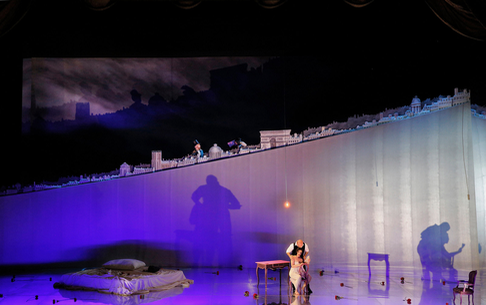
La petite table of Act II
American tenor Michael Fabiano (Rodolfo and Don Carlo in recent SFO productions, Jose at the Aix Festival) added stature to his exploding career as des Grieux, the amplitude of his voice and his studied acting made Massenet’s impulsive young lover — who without a second thought hides his chagrin in abbott’s habit overseen by crucified Jesus hanging in an upper vast black void — into a formidable operatic creation, never mind that it only took a few confused seconds for him to pull Manon onto the floor of the church and roll on top of her. All this after his exquisite "Ah ! Fuyez, douce image” that was met with our thunderous applause.
For those many of you who didn’t stick around for the end, Manon expired down stage center in des Grieux’ arms before rolling off the mirrored floor into the total black void that had enveloped the entire stage, all traces of the world erased. There were only these two meaningless creatures in the throes of high art. It was, in fact, sublime.
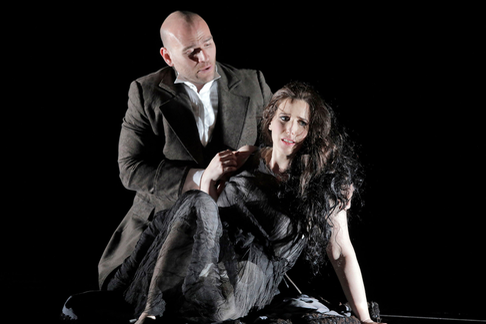 Michael Fabiano as des Grieux and Ellie Dehn as Manon
Michael Fabiano as des Grieux and Ellie Dehn as Manon
Director Boussard’s set designer Vincent Lemaire provided the curved sloping wall and the mirrored floor that continued up the downstage left wall. As well it will have been Mr. Lemaire who provided the nothingness of the black void. Mr. Boussard created his own costumes, fantasy abstractions of the Belle Époque, the women’s costumes adding intense color to the colorless monotones of the stage. Gilded shopping bags and gift boxes punctuated the space, not to overlook the bouquets of balloons, one of which transported Manon from the top of the wall to the floor of the stage!
This complex stage may have been heaven itself for the art of lighting designer Gary Marder, or maybe it was hell. Whichever, the lighting was a tour de force. From time to time the floor reflected onto the wall, the wall was bathed in color reflected on the floor, the minds and bodies of the actors were amplified by their shadows cast upon the wall, all the stage was black except for the precise illumination of the singers, and seemingly infinite variations of all the above.
The French of the all American cast had been coached to kingdom-come, making the spoken dialogues fun to follow as best we could, helped by the supertitles. Excellent companions to the Manon of Ms. Dehn and the des Grieux of Mr. Fabiano were des Grieux’ father (an exact echo of La traviata’s Germont), richly intoned by age appropriate bass James Creswell, Manon’s sleazy cousin Lescaut cockily delivered by baritone David Pershall and Lescaut’s rich friend de Bretigny intoned by elegant and worldly Timothy Mix. Providing additional, substantial vocal pleasure was the trio of actresses smoothly sung by Renée Rapier, Laura Krumm and Monica Dewey (strangely not a current Adler Fellow on the roster).
A slowly descending grand chandelier substituted the fourth act ballet, though when Manon’s original suitor Guillot (Robert Brubaker) entered he was accompanied by a sous-sus-ing ballerina in tutu (Rachel Speidel Little) on a leash.
This masterful Boussard production originated in Vilnius in 2015. From San Francisco it travels to Tel Aviv. Not to be missed.
Michael Milenski
Cast and production information:
Manon: Ellie Dehn; Chevalier des Grieux: Michael Fabiano; Lescaut: David Pershall; Comte des Grieux: James Cresswell; De Brétigny: Timothy Mix; Guillot: Robert Brubaker; Pousette: Monica Dewey; Javotte: Laura Krumm; Rosette: Renée Rapier. Chorus and Orchestra of the San Francisco Opera. Conductor: Patrick Fournillier; Stage Director: Vincent Boussard; Associate Director: Gediminas Seduikis; Scenery: Vincent Lemaire; Costumes: Vincent Boussard; Lighting Designer: Gary Marder. War Memorial Opera House, San Francisco, November 7, 2017.
image=http://www.operatoday.com/Manon_SFO1.png
product=yes
product_title=Manon in San Francisco
product_by=A review by Michael Milenski
product_id=Above: Shadow of des Grieux in the staging by Vincent Boussard [All photos by Cory Weaver, courtesy of San Francisco Opera]
Garsington Opera’s Silver Birch on BBC Arts Digital
Part of the BBC Opera Season, this ground-breaking experience from BBC Arts Digital and Garsington Opera entitled Person 181, utilises 360-degree video capture and cutting edge ambisonic audio recording to simulate being part of the community opera. The technology will give audiences the experience of being on stage standing among the cast of 180 performers during a performance of Silver Birch, as well as unique behind the scenes access in the build up to the actual performance.
Silver Birch is an exciting new commission from leading UK composer Roxanna Panufnik, with a libretto by writer Jessica Duchen. Inspired by Siegfried Sassoon’s poems, and the testimony of a British soldier who recently served in Iraq, the piece illustrates the human tragedies of conflicts past and present. The opera chorus includes a variety of first time singers from various community groups including veterans and family members.
Silver Birch is a celebration of music, drama, poetry and dance and brings together professional singers with 180 members of the local community. Designed to appeal to everyone from age 8 upwards, Karen Gillingham, Creative Director of Garsington Opera’s Learning & Participation programme, directs and Douglas Boyd conducts. The production is also supported by Foley Artists from Pinewood Studios.
Person 181 will be available at www.bbc.co.uk/arts along with three short ‘making of’ films, and at BBC Taster http://bbc.in/2lZfc4S.
image=http://www.operatoday.com/Garsington%20Logo.jpg
November 7, 2017
Mozart’s Requiem: Pierre-Henri Dutron Edition
This sense of tension, of conflicting power and powerlessness, and ultimately of fear and awe at the prospect of death, is ever-present in this new release from Harmonia Mundi. Drama is never far from the surface in this recording, and if it at times perhaps verges on bombast, it certainly conveys the image of a composer facing death in the eye. This is a recording that conveys the fear and tension of this confrontation, but perhaps at the expense of the more poetic aspects of such a conflict.
The voices are immediately full-blooded and rich when they first appear in the opening adagio; the soprano’ first entry is sublime, soaring over the sensitive accompaniment of the Freiburger Barockorchester. Yet prettiness is never with us alone, and the ensemble are quick to emphasise the work’s darker nature by exaggerating the dynamic contrasts, as found in the sudden quiet in the centre of the Introitus: Requiem æternam. Throughout the disc, there is a fine balance achieved between high drama – achieved through crisp articulation and dynamic variety – and melodic sweetness. Indeed, one of the most unsettling features of Mozart’s Requiem may be its juxta-position of beauty with darkness; how can someone write such sublime music to express something that embodies such fear and unpredictability?
This sense of contrast is beautifully highlighted in this new release. When the sopranos and altos glide into the picture after the opening gravitas of the male voices in the Confutatis, the dynamic and timbral contrast is stunning. However, it does at times feel almost overblown, particularly with the tempo that Jacobs adopts here, a tempo noticeably faster than Marriner on Philips (Academy and Chorus of St Martin in the Fields, 1991). Marriner also manages to keep the dynamic quieter for longer in the latter half of the Confutatis, making the tension almost unbearable. Similarly, Karajan’s DG (Vienna Philharmonic, 1987) reading finds a greater hush at the opening of the Lacrimosa, making the prolonged crescendo more striking. Despite the abrasive aggression of the Confutatis and the missed opportunity for genuine quiet in the Lacrimosa, it is impossible not to feel swept away by the sheer force of nature of both the score and the performance here, this force brilliantly communicating the overwhelming nature of death.
This release is certainly never afraid to be forceful, and gives as much prominence to the darkness as to the light. Listen to the explosive opening of the Dies Irae and, with the wonderfully full-bodied choir and aggressive brass, it feels that we are hearing not only a piece of music that is glaring death in the eye, but also performers playing for their lives. Indeed, this sense of vitality and liveliness in the singers (a touch ironic, perhaps) is matched by the instrumentalists, and the acoustic captures the imitation between the brass and choir effectively. A more transparent recording than Karajan’s DG reading enables a more prominent brass and string section, vital in communicating the raw energy and darkness of Mozart’s score.
Indeed, compared to Karajan, Jacobs employs a much faster tempo for the Tuba Mirum – or perhaps I should say that Karajan employed a tempo that was far slower – and Jacobs is much closer to Mozart’s andante marking. It is a shame, however, that the opening descending crotchets speed up, denying the phrase the gravity attained in the more consistent opening tempo of Marriner’s classic Philips recording. However, both Marriner and Jacobs are agreed in their faster tempo reading in comparison to Karajan’s sluggishness, creating a greater sense of movement in the Tuba Mirum. This heightens the drama of the tenor’s entry and the voices’ dotted rhythms. Karajan, whilst aiming for an epic stateliness, achieves more of an inflated sluggishness that detracts from the grandeur of this section. Yet, even compared to Marriner, Jacobs takes a very fast tempo; in the Tuba Mirum, Jacobs’ recording lasts just 3m11s, compared to Marriner’s 3m47s and Karajan’s 4m21s. Jacobs clearly aims for fast-paced dramatic tension; one could argue Marriner finds a better compromise between dramatic agility and stately gravitas, as Jacobs does occasionally feel rushed, as in the opening descending crotchets. Marriner’s tempo is my ideal: weighty yet with a sense of movement.
Tempo is fast elsewhere in the new recording; Jacobs’ genuine allegro of the Communio: Lux aeterna creates a fantastic sense of buoyancy, making the semiquavers sound far more agile than Karajan’s slower reading. The Belgian soprano Sophie Karthäuser sings beautifully in the Lux Aeterna, performing with great purity of tone and a well-controlled vibrato that never distracts from the text. There is a beautiful simplicity and delicacy that expertly conveys the “eternal light” described.
This recording’s unique selling point is the score it uses; instead of utilising Franz Xaver Süssmayr’s completion of Mozart’s original, Jacobs makes use of Pierre-Henri Dutron’s 2016 revised score, a project motivated by Dutron’s frustration at the inadequacies of Süssmayr’s version. Amongst the changes made by Dutron is a revised ending, which turns to an adagio tempo earlier and uses an extra pause – alongside dynamic contrast – to conclude the work with what Dutron argues would have been closer to Mozart’s true style. This recording is thus an important documentation of an alternative perspective on a well-known piece, providing fresh perspectives and asking further questions about the legitimacy and efficacy of Süssmayr’s version.
Harmonia Mundi’s new release is a powerful tour de force that confronts us with the high drama and tension of Mozart’s late masterpiece. With superb dynamic contrast, tempi that mostly strike a good balance between stateliness and momentum, and beautifully expressive singing, this is a highly enjoyable disc that communicates the full force of the huge emotions that Mozart grapples with. Given that the piece was performed at the funerals of Joseph Haydn, Beethoven, Schubert, Chopin, Rossini, Berlioz and Hallé, not to mention Goethe and Schiller, this is music that is intimately connected to death beyond just its subject matter. It is music about death in the fullest sense. With this recording, it is impossible not to be aware that one is listening to a piece of music that looks death in the eye. With the added interest of Dutron’s revisions, the spectre of death in Mozart’s score is communicated here with the fullest force of life.
Jack Pepper
References:
Landon, H. C. Robbins. 1999. 1791, Mozart’s last year. New York: Thames and Hudson.
Mozart, Wolfgang Amadeus, Sylvia McNair, Carolyn Watkinson, Neville Marriner, Francisco Araiza, Robert Lloyd, and Franz Xaver Süssmayr. 1991. Requiem, K. 626. London: Philips.
Mozart, Wolfgang Amadeus, Anna Tomowa-Sintow, Helga Müller Molinari, Vinson Cole, Paata Burchuladze, and Herbert von Karajan. 1987. Requiem K. 626. Hamburg: Deutsche Grammophon.
image=http://www.operatoday.com/Mozart_Requiem.png image_description=harmonia mundi 902291 [CD] product=yes product_title=Mozart: Requiem K.626 product_by=Sophie Karthäuser, Marie-Claude Chappuis, Maximilian Schmitt, Johannes Weisser. RIAS Kammerchor. Freiburger Barockorchester. René Jacobs. product_id=harmonia mundi 902291 [CD] price=$16.33 product_url=https://www.amazon.com/Mozart-Requiem-Freiburger-Barockorchester/dp/B0758CY43T/ref=as_sl_pc_tf_til?tag=operatoday-20&linkCode=w00&linkId=995926ae85d7c85dd543453b0a46adfd&creativeASIN=B0758CY43T
November 5, 2017
A beguiling Il barbiere di Siviglia from GTO
In May last year, I admired the visual beauty of Joanna Parker’s set designs but lamented the lack of genuine human comedy. It’s interesting, 18 months on, to see how and to what extent one’s memories have been preserved, and whether a different venue and cast can produce a fresh response. My first impression was that the smaller dimensions of the Marlowe Theatre stage brought about a more engaging intimacy and also prevented excessive gag-spinning. As Count Almaviva prepared to storm Rosina’s heart with a stylish serenade, the antics of Fiorello’s guitar-band and the three extravagantly costumed supernumeraries who facilitate the Count’s chair-by-chair advance on the flower-bedecked balcony of the beloved’s boudoir, seemed less fussy and distracting - the faux auditioning and ‘tuning up’ was less cumbersome, the comic antics more subdued but focused. Moreover, from my elevated vantage point in the Circle, I could enjoy the decorative floor patterns which reflect the elaborate wall designs and add to the general air of luxurious ease.
Subsequently, the trio of ‘extras’ swapped their extravagant theatrical masks and head-pieces for every-day overalls and involved themselves in the comic carryings-on without becoming overly intrusive. The harpsichords that they originally carted to and fro, at times distracting from the ‘business’ of the arias, persist, and their presence/function remains a mystery; but there are fewer of them. The first ribbon-bedecked keyboard imported into Bartolo’s house is supplemented by a second during the Act 1 finale - its conveyance and disassembly contributes to the general inanity - and complemented in the closing moments of the Act by a third which descends from the heavens and pins down the bewildered Bartolo. But, this is a veritable sparsity of keyboards compared to the riot of winging, swinging, upside-down instruments which populated Bartolo’s house last time around.
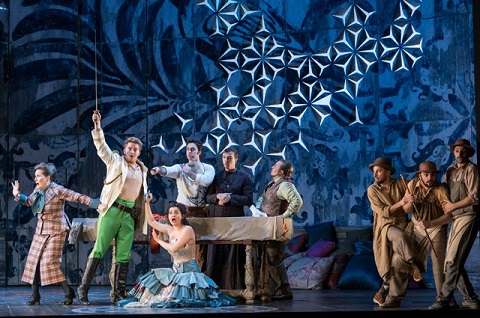 Cast of GTO’s Il barbiere di Siviglia. Photo credit: Bill Cooper.
Cast of GTO’s Il barbiere di Siviglia. Photo credit: Bill Cooper.
Aside from Adam Marsden, a member of the Glyndebourne Chorus, who competently reprises the role of the Officer, Janis Kelly is the only member of the original cast to repeat her role. Once again, she gives a masterclass in comic judgement, as Berta flits charmingly between staid disapproval and self-indulgent caprice, joining Rosina in a flighty fandango and reliving the amorous escapades of her youth in an Act 2 aria in which her memories are given fresh impetus by the chivalrous aid of the supernumeraries who take time off from furniture-removing to sashay with the tartan-suited dame.
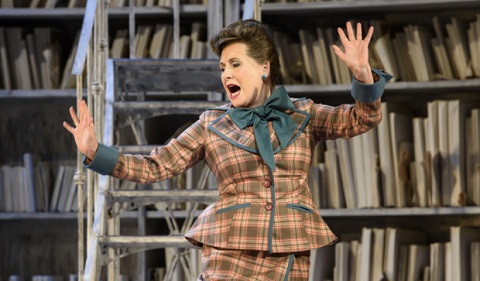 Janis Kelly (Berta). Photo credit: Bill Cooper.
Janis Kelly (Berta). Photo credit: Bill Cooper.
The ‘in-jokes’ are out; so, whereas last time round Act 2 opened in the Library with Bartolo retreating beneath the table to comfort himself with a picnic hamper - in imitation of the chuckling Glyndebourne patrons who’d just ‘enjoyed’ a down-pour disrupted long interval - now he had only a bottle of whiskey for company; and, this was quickly filched by the opportunistic men-about-the-house, ‘waking’ from their shut-eye when the boss’s eye was detained elsewhere.
The cast sing beguilingly but are not all equally commanding in dramatic terms. Jack Swanson is a youthful Count - indeed his fresh-faced innocence seems far too unworldly and pure to attract the headstrong Rosina’s attention - and while he sings accurately and with a clean tone, despite his glamorous floor-length silver coat Swanson doesn’t yet have the vocal swagger or sophistication to convey Almaviva’s guile and allure. He can essay romantic dreaminess in the quieter phrases of ‘Ecco, ridente in cielo’ but some of the phrasing lacks shapeliness. Moreover, he is woefully undirected during the disguise episodes. As Figaro, Tobias Greenhalgh similarly sings with youthful litheness but lacks sufficient dramatic weight to stamp his dominance on the intrigue. Last time round, Björn Bürger engaged in some wry flirtation with Danielle de Niese’s knowing Rosina, but Greenhalgh’s half-hearted hip-bumping in ‘Dunque io son ... tu non m’inganni?’ seemed naively harmless in comparison. Both young Americans sing well, but lack vigour and presence.
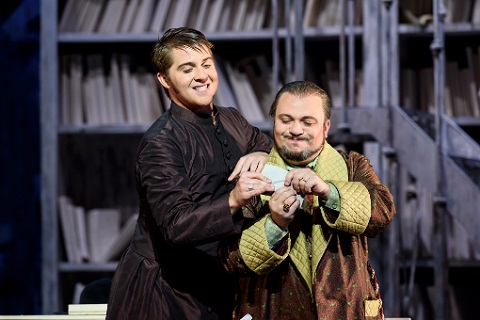 Jack Swanson (Count Almaviva) and Marco Filippo Romano (Dr Bartolo). Photo credit: Bill Cooper.
Jack Swanson (Count Almaviva) and Marco Filippo Romano (Dr Bartolo). Photo credit: Bill Cooper.
Marco Filippo Romano is, however, excellent as a cantankerous Bartolo, eschewing buffo hyperbole for credible indignation and pique, and rattling off the patter with aplomb. Anatoli Sivko is, likewise, a mean and miserly Basilio, but if his bass is quite light and self-contained this only serves to make the dramatic excesses of ‘La Calunnia’ more telling: as the pungent smoke wafts from the music-master’s cassock, Basilio seems delightfully oblivious to this snide comment on his ridiculous huffing, puffing and rumour-mongering.
Laura Verrecchia’s Rosina is less extrovert than de Niese’s unrestrained, over-excited diva, but this Rosina certainly knows her own mind and when things go awry she can take proceedings into her own hands. Verrecchia has a strikingly dark and densely layered mezzo, all amber and honey. I feared at first that it would prove too heavy a voice to flit with agility through Rossini’s sparkling coloratura, but my doubts were unwarranted, for what she lacked in glitter at the top Verrecchia more than compensated for with style and accuracy.
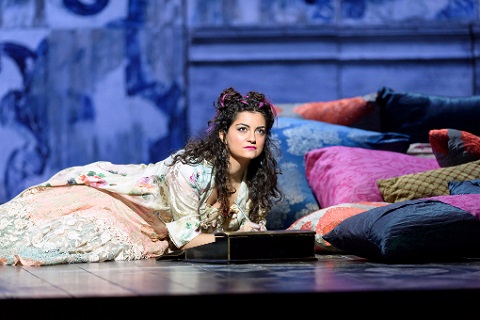 Laura Verrecchia (Rosina). Photo credit: Bill Cooper.
Laura Verrecchia (Rosina). Photo credit: Bill Cooper.
The Glyndebourne Tour Orchestra despatched the tricky overture with impressive ease, despite the racy tempos established by conductor Ben Gernon. The rather dry acoustic of the theatre aided the clarity of Rossini’s bravura motifs and there was some tremendously precise woodwind and horn playing, which did not lack grace and panache.
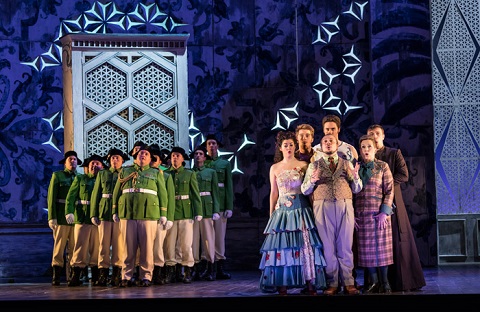 End of Act 1. Photo credit: Bill Cooper.
End of Act 1. Photo credit: Bill Cooper.
Despite this, however, the act finales never quite caught fire. Necessarily simplified stage business might have been to blame; perhaps individuals needed more precise directional guidance. Whatever, the chaotic confusion which should sweep through Bartolo’s house at the end of Act 1 failed to materialise, despite the strong choral singing of the chorus of policemen. Similarly, the surtitles often lagged behind the action. But, this did not seem to hinder the comprehension of the Canterbury audience, nor diminish their enjoyment; the cast and orchestra were met with effusive, warm applause at the curtain call and no doubt this will be replicated as the Glyndebourne tour continues its travels.
Claire Seymour
Rossini: Il barbiere di Siviglia
Fiorello - Michael Wallace, Count Almaviva - Jack Swanson, Figaro - Tobias Greenhalgh, Rosina - Laura Verrecchia, Dr Bartolo - Marco Filippo Romano, Berta - Janis Kelly, Basilio - Anatoli Sivko, Officer - Adam Marsden, Actors - Jofre Caraben van der Meer, Steve Johnstone, Maxime Nourissat; director - Annabel Arden, conductor - Ben Gernon, revival director - Sinéad O’Neill, designer - Joanna Parker, movement director - Toby Sedgwick, revival movement director - Maxime Nourissat, lighting director - James Farncomne, revival lighting director - David Manion, Glyndebourne Tour Orchestra, Glyndebourne Chorus (chorus master - Nicholas Jenkins).
The Marlowe Theatre, Canterbury; Saturday 4th November 2017.
image=http://www.operatoday.com/Rosina%20and%20Figaro.jpg image_description=Il barbiere di Siviglia: Glyndebourne Touring Opera at the Marlowe Theatre, Canterbury product=yes product_title=Il barbiere di Siviglia: Glyndebourne Touring Opera at the Marlowe Theatre, Canterbury product_by=A review by Claire Seymour product_id=Above: Laura Verrecchia (Rosina) and Tobias Greenhalgh (Figaro)Photo credit: Bill Cooper
Brett Dean's Hamlet: GTO in Canterbury
It may be impossible to answer the question, ‘What do we mean by ‘Shakespeare’s Hamlet’? But, rather than fretting, like Hamlet, over whether one should act upon one’s convictions, Dean and Jocelyn have been liberated by this very ‘inauthenticity’ and have fashioned their own Hamlet - which Dean has described as ‘focusing on a dysfunctional family with most of the geopolitics taken out’ (so we have no Fortinbras, Osric, Reynaldo and other courtiers). Having missed the summer performances at Glyndebourne, I was excited to have the opportunity to see and hear the results at the Marlowe Theatre in Canterbury.
The challenge of touring with a cast, orchestra and technical crew of almost 200 personnel has necessitated some revisions: the programme notes that, ‘Both the production and the score have been substantially reworked to allow for the demands of different venues’, resulting in ‘a brand-new version of [director Neil Armfield’s] production’. Yet, even if the original opening scene, in which Hamlet was seen kneeling at his father’s grave, has been replaced (revival director, Lloyd Wood) by a celebratory feast in the grand white dining room of set designer Ralph Myer’s elegant manor house, Dean’s and Jocelyn’s approach to the text and to the characterisation of the eponymous Dane are immediately apparent.
Isolated by Jon Clark’s spectral lighting (revived by David Manion), Hamlet is foregrounded against the dinner guests in modern evening dress who are seated, frozen in shadow, behind. He mutters and murmurs, fragmentations of Shakespeare’s text flitting through his mind like a primer of famous quotations from the text’s familiar soliloquies - ‘The rest is …’, ‘To be or not to be’; but, one’s expectation that the latter will conclude, ‘that is the question’, is denied by the creators’ delvings into the ‘Bad’ Quarto, and we are met with, ‘Aye, there’s the point’. And, that’s about it as far as the play’s soliloquies go, although these few opening lines do reappear intermittently through the opera. Consequently, we are not privy to Hamlet’s internal vacillations as he wavers between self-loathing despair, suicidal distress, vengeful determination and academic disputation.
Some may feel that Hamlet’s soliloquies ‘define’ Hamlet; that the protagonist’s dilemma - whether to act, to ‘take up arms against a sea of troubles’, or to be passive, a stoic like Horatio - is the driving force of the play. Hamlet’s wavering between submissive forbearance and nobility of action creates inner conflict and also tension for the audience. Certainly, Hamlet is ‘about’ love, murder, betrayal - the perennial stuff of opera - but it is also about ‘ideas’, and Dean and Jocelyn pay little attention to the play’s philosophical abstractions. Perhaps that’s a wise decision, and to the benefit of the dramatic tautness of the opera, but it does deprive this Hamlet of any character ‘development’: he is raving and morose at the start, and that’s the way he stays. This operatic Hamlet is less, in the words of director Armfield, ‘the story of someone who is trying to find the truth’, and more a study in melancholy, its causes, manifestations and effects.
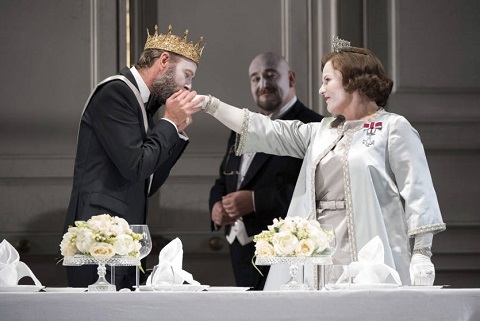 William Dazeley (Claudius), Jeffrey Lloyd-Roberts (Polonius), Louise Winter (Gertrude). Photo credit: Richard Hubert Smith.
William Dazeley (Claudius), Jeffrey Lloyd-Roberts (Polonius), Louise Winter (Gertrude). Photo credit: Richard Hubert Smith.
The angry petulance of David Butt Philip’s Hamlet is evident from this opening scene, as he whips away his chair from the royal couple’s central table and retreats in sulky pique. There is subsequently much childish chair-throwing and some immature baiting of Rosencrantz and Guildenstern as Hamlet tauntingly snatches their pristine pocket-handkerchiefs and brandishes them with a scornful flourish. However, Butt Philip (who sang the role of Laertes in the premiere run this summer) strikingly communicates Hamlet’s introspective alienation and combines this, paradoxically, with a restless physicality, while the shapeliness of phrasing and the tenor’s vocal warmth invite our compassion. Moreover, Hamlet’s prevailing agitation throws into relief the few moments of stillness, making his quiet, almost tender, rejection of Ophelia - ‘I did love you once’ - all the more heart-rending, particularly when his plain words are echoed by Ophelia in her madness.
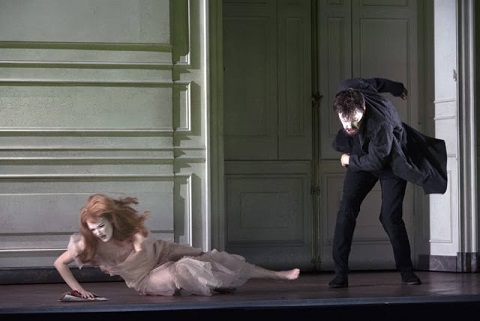 Jennifer France (Ophelia) and David Butt Philip (Hamlet). Photo credit: Richard Hubert Smith.
Jennifer France (Ophelia) and David Butt Philip (Hamlet). Photo credit: Richard Hubert Smith.
Dean’s first scene also introduces the ‘meta-theatrical’ dimension of the Hamlet - ‘the play’s the thing’, after all - with its incessant references to ‘acting’ and ‘playing’, and its presentation of the protagonist as a ‘director’ who manipulates theatrical convention in his search for ‘truth’. The faces of the cast are caked with white powder, as if they are participants in a theatrical masquerade. And, Myers’ set, which slickly swivels to transform the grand dining room first into a cavernous ghostly chamber, and then an intimate interior, eventually converts into a tumble-down back-stage area where the Players gather. The latter’s performance is brief, sensibly restricted to just the dumb-show, and accompanied by an on-stage accordionist (Miloš Milivojević) whose wheezy bellows add to the meta-theatrical self-awareness.
The role of Ophelia was written with the qualities and capacities of its first interpreter, Barbara Hannigan, in mind. Polonius’ daughter is no static, one-dimensional victim but a feisty young woman who not so much crumbles but explodes into insanity. Though she is repeatedly belittled by the condescending Polonius - Jeffrey Lloyd Roberts spits out the guttural consonants of the put-down, ‘green girl’ - and Laertes, she stands her ground in the face of the latter’s impertinence. dismissing her brother’s warnings about her loss of honour with an indifferent repeated riposte, ‘Yes, good, my brother’.
There is very little sense of the relationship between Ophelia and Hamlet, though, and almost no interaction between them, only a scene of bitter rejection as Hamlet projects his feelings of rage against his mother onto Ophelia - ‘get thee to a nunnery’. Indeed, subject to incessant derision and maltreatment by all the male characters, it is no surprise that Ophelia goes mad. Moreover, Dean and Jocelyn have skilfully re-arranged Shakespeare’s text so that rather than Polonius reading the love letters she has received from Hamlet, Ophelia is humiliated by her father and forced to recite them to Claudius and Gertrude. Elsewhere, too, the creators exploit opera’s potential for a simultaneity which deepens expressivity, sharing lines and creating duets which convey the affection that Hamlet feels towards Gavan Ring’s sympathetic Horatio. They also allow Gertrude to speak with Claudius about the reasons for her son’s confusion and ‘turbulent and dangerous lunacy’, and here and throughout the opera Louise Winters makes much of Gertrude’s lyricism and her own full tone to arouse sympathy for the duplicitous queen. In contrast, elsewhere Dean’s general avoidance of vocal lyricism results in a distancing of the characters whose dilemmas and conflictions were do not really enter.
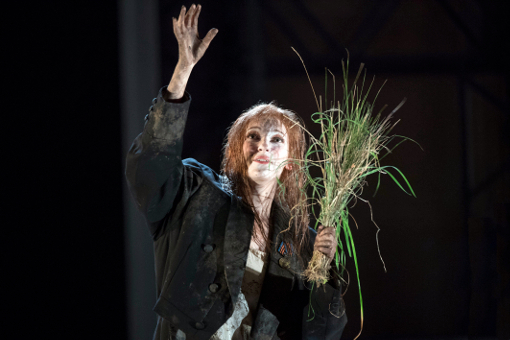 Jennifer France (Ophelia). Photo credit: Richard Hubert Smith.
Jennifer France (Ophelia). Photo credit: Richard Hubert Smith.
In Shakespeare’s play, it is Ophelia’s song fragments which exhibit and heighten her derangement and enforce her isolation. However, if the prevailing medium is song, a composer is challenged to find an idiom or means of equalling such tragic pathos, and Dean’s response is one of the highpoints of the opera. Jennifer France’s portrayal of Ophelia’s disintegration is distressingly visceral, as the soprano’s silky vocal tone and pin-point coloratura of Act 1 transmutes into a gut-wrenching primitive scream. Ophelia bursts onto the stage, only a man’s evening tailcoat covering her underwear; splattered with grime, her filthy hair hanging in rat’s tails, and clutching fractured green grasses, she seems already to have attempted to drown herself in the muddy river. Mutter fragments of recalled derision are replaced by bawdy songs which seem to turn Ophelia’s breakdown into a ‘performance’, a bold, overtly sexual display. Finally, sound replaces words: a hum, a wail, then a scream, this vocal manifestation of tragic alienation rise ever higher, until France flings out a stratospheric, primeval howl, the defiant energy of which is made even more arresting by the stillness of the stunned characters who witness Ophelia’s crisis.
Lloyd-Roberts’ prolix, presumptuous Polonius is without doubt a ‘tedious fool’ - and has one of the opera’s best one-liners, ‘I will be brief’ - but his foolishness in no way lessens our discomfort at his abusive treatment of his daughter. As Claudius, William Dazeley offers an eloquent plea for divine pardon although, as he places one knee upon a back-stage chair, after the Players’ unsettling show, it might not be clear to those unfamiliar with the play that the king is actually at prayer - the reason that Hamlet, who desires both revenge and justice, desists from killing his step-father - thus weakening the cruel irony that the hypocritical Claudius prays for forgiveness for one murder just as he has made arrangements for Hamlet’s own death.
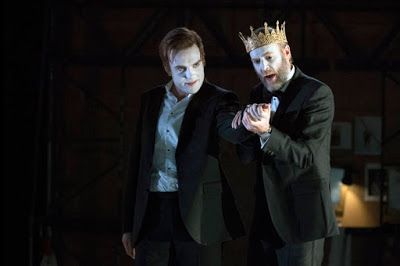 Rupert Charlesworth (Laertes) and William Dazeley (Claudius). Photo credit: Richard Hubert Smith.
Rupert Charlesworth (Laertes) and William Dazeley (Claudius). Photo credit: Richard Hubert Smith.
The post-dumb-show scenes feel rather lengthy, too, with Polonius’ death - a natural point of pause, perhaps - Hamlet’s subsequent conversation with Gertrude, and the reappearance of the Ghost all taking place before the interval, making for a long first Act. No doubt, Dean and Jocelyn were guided by the wish to open the second Act with a dramatic gesture: and they certainly achieve this with the resounding cries of welcome which the semi-chorus launch from the Circle balcony to greet the returning Laertes, played with arrogant self-assurance by Rupert Charlesworth.
As the Ghost of Old Hamlet, Brian Bannatyne-Scott is a disturbing presence, seated up-stage, streaked with spears of light which pour through the tall windows stage-right and pierce the darkness, his back turned from his troubled son. But, while the Scottish bass thunders his command that Hamlet should revenge his father’s foul and unnatural murder, the Ghost is robbed of his nobility by the questionable decision to have him remove his jacket and appear before his son in his under-vest. Surely it is the Ghost’s military might that Shakespeare emphasises when he has Horatio remark the spectre’s ‘fair and warlike form/In which the majesty of buried Denmark/ Did sometimes march’ and Hamlet comment on the Ghost’s apparel when he appears ‘again in complete steel’?
Bannatyne-Scott triples up, as the First Player and as the Gravedigger. In the latter manifestation, he tosses poor Yorick’s skull as if it were a tennis ball and the easy nonchalance which ‘custom’ has bred is evoked by the grubby knotted handkerchief which perches askew on his crown. I wondered, though, why Dean and Jocelyn have chosen to interpolate much spoken text in this scene - previously, the odd line or two are spoken or half-spoken - and in the final scene, when Hamlet challenges Laertes to fight a duel on Ophelia’s grave?
The inefficacy and bewilderment of Rosencrantz and Guildenstern is expertly communicated by countertenors Rupert Enticknap and James Hall, whose voices blend as one as they synchronise their self-conscious hand-wringing and tentative smiles of appeasement.
Dean’s busy score is vigorously driven forwards by conductor Duncan Ward. Dean plummets the eerie depths and scales nerve-jangling heights, finding a kaleidoscope of timbres for every expressive shade that the drama explores. Although the dictates of touring mean that it is not possible to reproduce the use of electronic reverberations and satellite instrumental and choral groups employed in Glyndebourne’s opera house, Dean’s score makes a striking, often discomforting, impact.
While Dean’s Hamlet may not divulge or explore all of the Danish prince’s procrastinations, the opera certainly offered this listener much to think about.
Claire Seymour
Brett Dean: Hamlet
Hamlet - David Butt Philip, Claudius - William Dazely, Laertes - Rupert Charlesworth, Ophelia - Jennifer France, Polonius - Jeffrey Lloyd-Roberts, Horatio - Gavan Ring, Marcellus/Player 4 - John Mackenzie-Lavansch, Gertrude - Louise Winter, Ghost of Old Hamlet/Gravedigger/Player 1 - Brian Ballantyne-Scott, Rosencrantz - Rupert Enticknap, Guildenstern - James Hall, Player 2 - John Findon, Player 3 - Anthony Osborne, Classical Accordionist - Miloš Milivojević, Actors - Ashley Bain, Anthony Kurt Gabel, Ralf Higgins, Mark Ruddick; director - Neil Armfield, conductor - Duncan Ward, revival director - Lloyd Wood, set designer - Ralph Myers, costume designer - Alice Babage, movement director - Denni Sayers, lighting designer - Jon Clark, revival lighting designer - David Manion, fight director - Nicholas Hall, Glyndebourne Tour Orchestra, The Glyndebourne Chorus (chorus master - Nicholas Jenkins).
The Marlowe Theatre, Canterbury; Friday 3rd November 2017.
image=http://www.operatoday.com/Horatio%2C%20Ghost%20and%20Hamlet%20Act%202.jpg image_description=Hamlet: Glyndebourne Touring Opera at the Marlowe Theatre, Canterbury product=yes product_title=Hamlet: Glyndebourne Touring Opera at the Marlowe Theatre, Canterbury product_by=A review by Claire Seymour product_id=Above: Gavan Ring (Horatio), Brian Ballantyne-Scott (Gravedigger), David Butt Philip (Hamlet)Photo credit: Richard Hubert Smith
November 4, 2017
Schumann and Mahler Lieder : Florian Boesch
Although I've heard dozens of performances over the last 40 years, this took my breath away. I've been playing the songs over and over, getting so much from it. Boesch's voice is a thing of wonder — such richness, such beauty — yet fluidly natural, free of mannerisms and self consciousness. When you listen to Boesch, you're not listening to "a performance" so much as being drawn into the music itself, experiencing it in a profoundly personal way.
Mahler's Lieder eines fahrenden Gesellen were particularly personal works for Mahler himself. He wrote the texts himself and set them with a very short period: hence their spontaniety. This is very much a young man's adventure. so youthful vigour is central to interpretation. Martineau plays the first bars of "Wenn mein Schatz Hochzeit macht" which repeat, like tentative but brisk footsteps into the unknown. Note how steady Boesch's voice is as he joins in, for the protagonist is to undergo a wide range of conflicting emotions as he proceeds on his journey. When Boesch sings "Fröhliche Hochzeit" , for example, the "ö" trembles, as if to emphasize sarcasm. The protagonist has been alone, weeping in his "dunkles “Kämmerlein". When Boesch repeats the word a second time, he shades it to evoke the darkness and all that it implies. This intensifies the contrast in the second part of the song with its joyful outburst. Boesch's voice glows as he sings the lyrical "Blümlein blau! Verdorre nicht!
Vöglein süß!". We can almost imagine the protagonist's lungs swelling, taking in the clean air. Like the bird, the protagonist will make his mark on the world by singing. Not whining, to make a bad pun. Martineau's playing is lyrical, too, suggesting the bird, singing alongside the singer. "Zikuth, zikuth" sings Boesch with utter simplicity, for the bird represents nature and innocence. For a moment, though, "Singet nicht! Blühet nicht!" and the poet retreats into himself, voice and piano gently muting.
But not for long. The pace quickens, the piano line suggesting an energetic hike. Lilting passages move and flutter. We're on the open meadows."Ei du! Gelt? Guten Morgen! Ei gelt?" Note the rhythms. Boesch and Martineau keep the tone light. The bird is cheeky but it’s also chirpy. Sparkling piano figures lead into a new, more serene mood, where lines stretch smoothly, held for several measures, as if basking in Sonnenschein. Yet again, the protagonist retreats, the piano line decelerating breaking into single notes "Nein ! Nein !" sings Boesch, with quiet resignation. "Ich hab' ein glühend Messer" heralds a sudden mood change. Mahler's contrasts suggest stage drama, perhaps a hint that the protagonist thinks he needs to talk big to make a point. Significantly, the bluff doesn't last : the protagonist moves on. But to what? He lies under a linden tree, whose perfume was reputedly narcotic. The music becomes lullaby, gentle rocking patterns in voice and piano. For a baritone who has great heft when he needs it, Boesch can do soft and tender extraordinarily well.
Will the protagonist wake refreshed or will he die ? In Das klagende Lied, Mahler's hero rests under a tree, and gets a message from his dead brother. But in Schubert's Winterreise the hero realises that there are no easy answers. He must keep searching. So whither the wayfaring lad? "Alles, alles, Lieb und Leid, und Welt, und Traum". The connections between Lieder eines fahrenden Gesellen and Mahler's Symphony no 1 are obvious. But the piece is a breakthrough because Mahler is embarking on a journey in music and metaphysics that might never end. In 1885, in Lieder eines fahrenden Gesellen, we already glimpse Das Lied von der Erde and even the Tenth Symphony looming into view. Boesch and Martineau are Lieder specialists,deeply immersed in the aesthetic that inspired Romantic poetry, painting and music, and have created whole programmes on the theme of Romantic Wanderer. Boesch has also recorded a Wanderer disc with Roger Vignoles. Like the wanderers of the early Romantic period, Mahler, "dreimal heimatlos", channels the questing spirit though his music is very different to Schubert's.
Surprisngly, Boesch and Martineau have done relatively little Mahler, but they are Lieder specialists, and this, I think, gives them an edge over some singers whose background might be more geared towards opera and less intensely intimate genres. Fundamentally Lieder is an inward genre where sensitivity and emotional intelligence are paramount. With their extensive experience in Schubert and Schumann, Boesch and Martineau can bring that Lieder sensibility to bear in Mahler, and , perhaps even more significantly, an understanding of the early Romantic roots behind Lieder and behind the folk traditions collected by Brentano and von Arnim for their volume Des Knaben Wunderhorn. Thus this Lieder eines farhrenden Gesellen is one which even seasoned Mahler listeners should take the time to listen and absorb. Mahler's symphonies, even past the Fourth, connect to the Wunderhorn background.
Also on this recording, an excellent Schumann Liederkreis op 39, which Boesch and Martineau have done together many times This version's excellent. Regular Boesch and Martineau fans will be delighted, because Linn recordings are audiophile quality. Listeners coming in for the Mahler are in for a serious treat ! Schumann, too, drew on the spirit of the Romantic wanderer, so hearing Schumann and Mahler together enhances our appreciation of how two very different composers approached the same concepts. In Liederkreis op 24, Schumann set Heinrich Heine, more worldly and cynical than Joseph Freiherr von Eichendorff whose poems inspired Liederkreis op 39. A wise choice oin the part of Boesch and Martineau, since Eichendorfff's poems are closer to the naturalism and folk wisdom of Wunderhorn. There are wanderer sings, like In der Fremde ("Aus der Heimat hinter den Blitzen rot") and In der Fremde ("Ich hör' die Bächlein rauschen") with its haunting refrain "Ich weiss nicht, wo ich bin". But there are also songs like Waldesgresräch which connects to the supernatural enchantment of Das klagende Lied, and songs like Frühlingsnacht where in darkness the poet recalls lost love, but is cheered by nightingale song and the fresh blooms of Spring. The themes of Lieder eines fahrenden Gesellen !
This recording isn't long (47 minutes) but it's packed with good things and worth every cent. Three songs from Schumann's Lieder und Gesänge aus Wilhelm Meister op 98a, for example, which Boesch and Martineau have done live several times in recent years. Wie nie sein Brot mit Tränen aß, Wer sich der Einsamkeit ergibt, and An die Türen will ich schleichen. Schumann's settings aren't as omnipresent as those by Schubert and Hugo Wolf, but they are every bit their equal, contemplative and - dare I use a naughty word these days - "intellectual". Wilhelm Meister is a tortured soul, and an exile who will never find peace, but he sings on, nevertheless, though he's forever doomed to wander. Nothing pastoral, but also very much in the Romantic spirit of psychological discovery.
Anne Ozorio
image=http://www.operatoday.com/Boesch.png
image_description=Linn Records CKD 511 [CD]
product=yes
product_title=Robert Schumann : Liederkreis op 39, Lieder und Gesange aus Wilhelm Meister op 98a, Gustav Mahler : Lieder eines fahrenden Gesellen
product_by=Florian Boesch (baritone), Malcolm Martineau (piano)
product_id=Linn Records CKD 511 [CD]
price=$18.04
product_url=https://www.amazon.com/Lieder-FLORIAN-BOESCH-MALCOLM-MARTINEAU/dp/B075GBJ34G/ref=as_sl_pc_tf_til?tag=operatoday-20&linkCode=w00&linkId=05d868b437408cf23e3a58ccaa738c20&creativeASIN=B075GBJ34G
WNO's Russian Revolution series: the grim repetitions of the house of the dead
Janáček assembled the libretto for From the House of the Dead from Dosteovesky’s ‘memoirs’ which were loosely disguised in quasi-fictional form and published, predominantly in the journal Vremya, between 1860-62. The composer selected characters and incidents from the author’s accounts of ceaseless suffering, as well as incidents that occurred in the prison hospital and on feast days. Each of the opera’s three acts, which proceed without pause, focuses on an individual narrative of the violent crimes, real and sometimes imagined, which have led to incarceration. The successive narrations of aggression, brutality and murder become increasingly dreadful and distressing.
There is no development of character, but as Pountney so powerfully and disturbingly confirms, Janáček creates incredibly probing psychological studies. And, although individuals - the Tall Prisoner, the Short Prisoner - emerge from and are re-subsumed into the mass of iniquity, within the seemingly abstract design in which prisoners aimlessly intermingle there is a huge range of emotions amid which an elusive but indestructible hint of humanity survives. It is surely this combination of abjection and compassion which attracted Janáček - who inscribed his score, ‘In every creature a spark of God’ - to Dostoevsky’s recollections. Just as the latter aims for objectivity in presenting the extremes to which man may be driven in order to survive, as violence begets violence, so the composer does not aim to explain, condemn or absolve. The words of Carl Dahlhaus seem apposite: ‘In contrast to Wagner, who keeps up the running commentary on the unfolding drama, Janáček is not present in his own person, or discoursing in his own words; he is more like an observer, standing back unnoticed behind what he has to show us, which reveals itself in its own terms.’
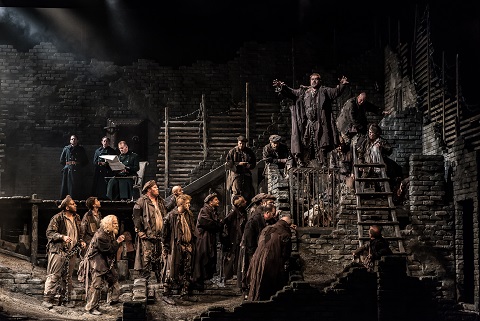 Cast of From the House of the Dead. Photo credit: Clive Barda.
Cast of From the House of the Dead. Photo credit: Clive Barda.
From the House of the Dead is all the more unsettling for Janáček’s unflinching realism. And, this realism most forcefully resides in the astonishingly unconventional orchestral score which Czech conductor Tomáš Hanus brought to life with searing precision and incisiveness. WNO are performing the new critical edition prepared by esteemed Janáček scholar John Tyrrell; heard here for the first time, this authoritative edition further revises the ‘provisional’ edition based upon the 1928 copyists’ score (which includes some of the composer’s revisions) which Tyrrell had prepared with Charles Mackerras for the 1980 Decca recording of the opera. Additions and instrumental doublings, along with the ‘ironing out’ of the composer’s ‘idiosyncrasies’, which had been imposed by Janáček’s pupils, Břetislav Bakala and Osvald Chlubna (who had believed the chamber-like autograph score to be unfinished), have been pared away.
Hanus relished the instrumental extremes, creating a unalleviated tension between bass and the soaring upper lines, and highlighting the stark juxtapositions of colour - riotous brass, blazing trumpets, squealing violins, and poignant oboe - and register - a low tuba growling beneath stratospheric piccolo yelps - which characterise the instrumental writing. The conductor achieved a wonderful transparency through which every edgy motivic gesture, melodic snatch and rhythmic twitch was laid bare. The mosaic-like structure of the score in which textures and musical ideas seem almost randomly to intersect and interrupt evoked the grim, grinding repetitions of prison life. The overture, with its clanking chains, whiplash mimicry and high screaming violins, was an alarmingly blunt exposure to the disturbing immediacy of the events which would unfold. The opening march was intense: the subdued horns rumbled forebodingly as the side drum rolled out the signals which break up each monotonous day and evoke the oppressive military force which overpowers all.
The perpetual tension never lessens: antagonism outweighs collective experience as the prisoners constantly provoke and torment each other, even arguing about the type of bird that they have captured and confined to a cage. The aggressive rituals roll on and round, but at times individuals are picked out for harassment, Chris Ellis’s lighting (realised on tour by Benjamin Naylor) brilliantly isolating individuals within the hellish gloom. And, the arrival of the aristocrat, Aleksandr Petrovich Goryanchikov (the narrator of Dostoevsky’s novel), imprisoned for political crimes, instigates a dreadful rattling of the prisoners’ chains. Dostoevsky had remarked, ‘They hated the upper classes to a fantastic extent. They were extremely hostile and rejoiced at our sorrow. They would have killed us had they been given a chance. They never stopped persecuting us, for it gave them pleasure, distracted them - it was an occupation’. Indeed, Ben McAteer’s clean tenor and raised position on stage did seem to isolate him from the other prisoners, but when at the end of Act 1 Petrovich was dragged away to be beaten, Mark Le Brocq’s Luka Kuzmich’s account of his own similar punishment caused the men - and us - to flinch with every audible crack of the whip. The silencing of the prisoners’ voices at this point spoke painfully of their anguish.
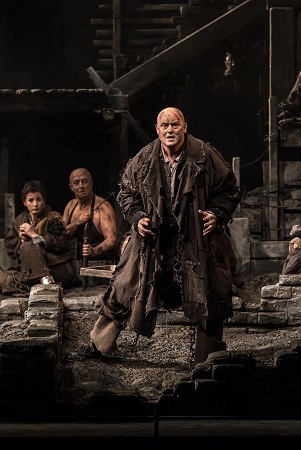 Mark Le Brocq (Luka). Photo credit: Clive Barda.
Mark Le Brocq (Luka). Photo credit: Clive Barda.
Luka is the first to recount his narrative of naked violence, and as he told of his murder of a guard at another prison, Le Brocq’s tenor was a formidable force against the abrupt and angular instrumental lines. Alan Oke’s Skuratov is an unhinged presence during Luka’s account, wrapping the chains which manacle his hands over his head as if to inflict further pain upon himself. In Act 2, Skuratov tells his own heart-rending tale about a woman, Luisa, loved and lost, and her Old German husband, whom he murdered. The contrast between genuine love and a rejoicing in murderous vengeance breaks out into a folk-song which balances precariously between a reminder of the ‘real world’ beyond the prison and a descent into lunacy. Oke skilfully evoked the different voices of the personnel of his grim chronicle, momentarily transporting us to the wider world.
It is Shishkov’s horrifically gripping narration in Act 3, however, that descends to seemingly unredeemable depths of psychological anguish. Simon Bailey was a commanding presence, emerging from the obscurity where he had lingered up until this point to recount his story of loyalty and betrayal. Bailey’s bass-baritone grew more intense and compelling through his 20-minute confession. He had married Akulina, despite Filka’s declaration that he had taken Akulina’s virginity, but upon learning that Filka was indeed the man she truly loved, he had slashed Akulina’s throat.
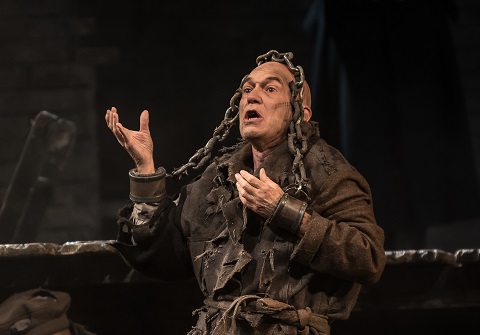 Alan Oke (Skuratov). Photo credit: Clive Barda.
Alan Oke (Skuratov). Photo credit: Clive Barda.
Amid such desolation, Janáček does offer tentative glimmers of brightness. The role of the young Alyeya is cast for mezzo soprano (though sometimes taken by high tenor) and Paula Greenwood’s shining tone, her voice redolent with emotion as Alyeya sings of her sister and mother, sailed above the prisoners’ sunken spirits - although such moments of human warmth can make the resumption of prison life (the noise of the convicts at work interrupts and smothers Alyeya’s recollections) even more despairing. Then, there is the wounded, caged eagle which the prisoners cruelly prod - to torment or keep alive? - but which, a ‘Tsar of the forests’, recovers and is released, a parallel to Petrovich’s new-found freedom. WNO’s representation of this symbolic emancipation was not entirely successful, the somewhat clumsy puppet of Act 1 replaced by projections for the final release - a perfectly acceptable approach in theory, but a little unpolished in execution.
The exaggerated gestures and flashes of colour which characterise Pountney’s presentation of the two pantomimes which mark the Easter festivities at the end of Act 2, emphasise the way the dramatic narratives of ‘Kedril and Don Juan’ and ‘The Miller’s Beautiful Wife’ parallel the prisoners’ destructive experiences of sexual love. The performances offer relief from the regimentation but also aggravate the underlying tensions, emphasising the absence of women in the prison - excepting the women who accompany the priest who offers an Easter blessing and the prostitute who plies her trade - and the prisoners’ own failures.
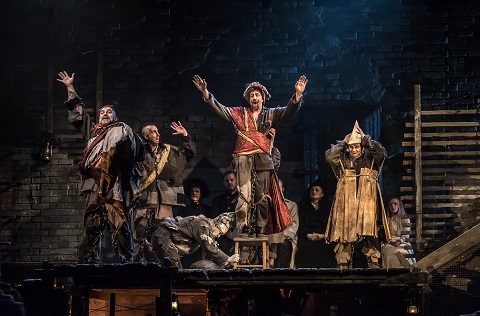 Paul Charles Clark, Laurence Cole, Julian Close, Adrian Thompson. Photo credit: Clive Barda.
Paul Charles Clark, Laurence Cole, Julian Close, Adrian Thompson. Photo credit: Clive Barda.
The production also confirms the compassion and consolation that is to be found amid such degeneracy and despair. Robert Hayward’s Commandment, previously so brutishly angered by Petrovich’s dignity, was almost lost for words when he asked Petrovich for forgiveness for his unjust treatment. Peter Wilman’s Old Convict rose with surprising fortitude and presence to affirm his reconciliation to camp life: after Shishkov has attacked Luka (whom he has recognised as the treacherous Filka), the old man calmly declared, ‘He was born of a mother too’, though the prisoners’ struggle to comprehend what it means that ‘a human being has died’.
In his last opera, Janáček eschews the climactic apotheoses and melodrama with which some of his earlier operas close - and the sort of romantic transfiguration of the kind that, depicting a similar context, Franco Alfano indulges in the final scenes of Risurrezione which I recently saw at the Wexford Festival . Pountney closes with the savage stamping of the concluding march dissolving into the darkness. The oppression is overwhelming, the routine will continue, unchanged: the realism of K át’a Kabanová pushed to its extreme.
Janáček wrote of his ‘black opera’ to Kamila Stösslova: ‘It seems to me that I am gradually descending lower and lower, right to the depths of the most wretched people of humanity. And it is hard going.’ Watching From the House of the Dead can give rise to similar dejection and disorientation. But, the warmth of the lyrical exchanges between Alyeya and Petrovich at the close bring both hope and frustration: the latter’s freedom entails separation. Perhaps for the first time we feel empathy.
Previous WNO tours have seen Tomáš Hanus at the helm for performances of John Copley’s 2011 production of Johann Strauss II’s Die Fledermaus, but on this occasion the task fell to James Southall who ensured that the bubbles did not go flat. The opening chords popped like exploding champagne corks, kick-starting a scintillating overture which set the tone for the entire orchestral performance - one characterised by lightness and grace, rhythmic zest, string playing which sparkled and then swooned, woodwind by turns silky then razor-sharp, and spot-on tuning. Swift tempos kept self-indulgence at bay - Southall didn’t over-egg the rubatos in the waltz - and vivaciousness ruled the day.
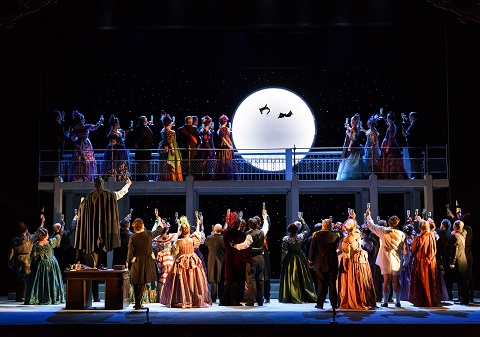 Cast of Die Fledermaus. Photo credit: Bill Cooper.
Cast of Die Fledermaus. Photo credit: Bill Cooper.
Strauss’s belle époque frivolity seemed a rather odd companion for the three Slavic dramas of the Russian Revolution triptych. And, while it is a hangover from the company’s Vienna Vice season, there’s not much degeneracy or danger to be found in Copley’s Viennese merriment despite the fact that the criminal justice system lies at the heart of the drama of mistaken arrest, prison avoidance and voluntary incarceration. But, given the lessons learned when Christopher Alden looked for some darkness amid the bats and ballrooms at ENO in 2013, that’s no bad thing. And, it’s certainly a crowd-pleaser/audience-puller, offering some sunshine should the clouds of Slavic gloom seem like heavy weather. Moreover, with Strauss’s Viennese high society on the cusp of financial destabilisation and members of the government being carted off to gaol for debauchery and corruption, one doesn’t have to look too deeply to find some telling contemporary parallels which add a delicate satirical frisson to the light-weight comedy. The only difference is, perhaps, that nowadays we are less likely to be surprised by the shocking behaviour of the wealthy and the ruling classes.
Tim Reed’s elegant set gives no hint of imminent economic panic and depression, however; in contrast, the graceful balustrades of the spiral staircase which rise from the art nouveau tastefulness of the Eisensteins’ drawing-room to the airy terrace balcony above seem an aptly elegant metaphor for the social and financial ladder that the would-be elite are rapaciously ascending.
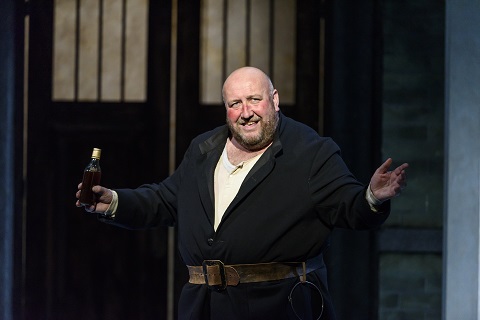 Steve Speirs (Frosch). Photo credit: Bill Cooper.
Steve Speirs (Frosch). Photo credit: Bill Cooper.
The comic capers spin with a light touch, arising naturally from the musical esprit, although the compulsion of Paul Charles Clarke’s Alfred to burst into song - not just in his gaol cell, but also off-stage before the show begins, and whenever the dialogue pauses for breath - is a bit wearing, despite the tenor’s bright ring. Rossini, Verdi, Puccini all get a look in, the latter somewhat anachronistically as Rosalind is drawn into a ‘Nessum Dorma’ duet; and Alfredo, having taken Tosca a little too much to heart, flings himself from the terrace balcony, only to bounce back up again. In Act 3, the drama is momentarily put on hold by the arrival of Steve Speirs’ Frosch, whose Tommy Cooper meets Macbeth’s Porter pièce de résistance was followed by Colonel Frank’s inebriated ineptitude, ably delivered by James Cleverton whose distorted vision we shared via some slippery coat-hook sliding and the over-active agility of the Wilhelm I’s portrait’s florid moustache. It was quite a relief when Adele (Rhian Lois) reappeared, confessing that she had been the Eisensteins’ maid, and the music was restored to centre-stage.
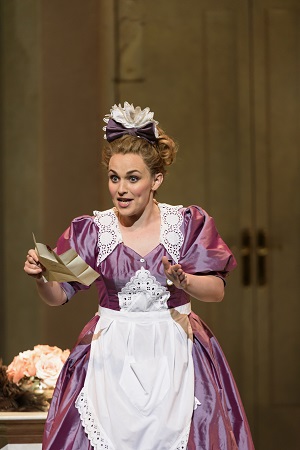 Rhian Lois (Adele). Photo credit: Bill Cooper.
Rhian Lois (Adele). Photo credit: Bill Cooper.
The cast are uniformly attuned to the spirit of Copley’s production. Judith Howard is a lively Rosalinde, only too aware of her husband’s short-comings and dalliances. She slipped into a juicy cod-Hungarian accent for her Csárdás and the high notes were similarly plump. At ENO in 2013, Rhian Lois’s Adele was a welcome light amid the prevailing Freudian shadows, and here she was similarly vibrant, delivering a particularly glittering ‘Laughing Song’: Lois has obviously got the role as securely under her belt as Adele has her wily ‘betters’ under her thumb. I was impressed by Anna Harvey’s Prince Orlovsky, who for once was not mired in misanthropic melancholy but merely seemed to wish for some properly disinhibited partying. The challenging range and leaps of ‘Ich lade gern mir Gäste ein’ (I love to invite my friends) were negotiated with the same ease that saw Orlovsky throw back the vodka shots and toss the tumblers over his shoulder.
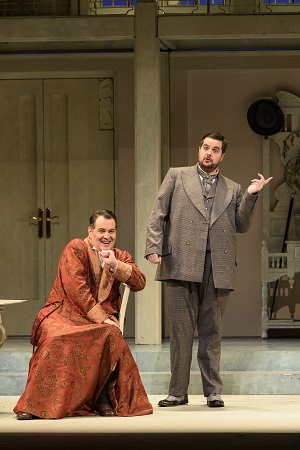 Mark Stone (Eisenstein) and Ben McAteer (Falke). Photo credit: Bill Cooper.
Mark Stone (Eisenstein) and Ben McAteer (Falke). Photo credit: Bill Cooper.
Mark Stein’s Eisenstein was more harmless charmer than crooked cad. Stone makes it all look and sound easy, but fashioning such musical charisma and deft comic judgment takes hard work. Such is this Eisenstein’s hapless inefficacy and vocal allure that one feels one would forgive him any indiscretion. He’s even fairly patient with his incompetent lawyer, Dr Blind (Joe Roche) and forgiving of Ben McAteer’s cruelly vengeful Dr Falke. The slick couplets and adroit internal rhymes of David Pountney and Leonard Hancock’s witty translation were clearly enunciated by all - I rarely needed to glance at the surtitles.
Some of the choral numbers could do with a shot of Orlovsky’s vodka. The WNO Chorus spin and swirl gracefully through the decorative arches of the ballroom, but while their gowns dazzle and glint under Howard Harrison’s purple-tinged light, the dancing is on the sedate side. Hardly the wild nights for which the Prince longs. But, while Strauss’s sachertorte may be a little too saccharine at times, the revenge of the bat, silhouetted against the gleaming moon in the closing tableau, provides some beguiling magic.
The WNO autumn tour continues until 2nd December in Liverpool, Bristol and Oxford.
Claire Seymour
Johann Strauss II: Die Fledermaus
Alfred - Paul Charles Clarke, Adele - Rhian Lois, Rosalinde - Judith Howard, Gabriel von Eisenstein - Mark Stone, Dr Blind - Joe Roche, Dr Falke - Ben McAteer, Colonel Frank - James Cleverton, Prince Orlovsky - Anna Harvey, Orlovsky’s servant - George Newton-Fitzgerald, Ida - Angharad Morgan, Frosch - Steve Speirs; director - John Copley, conductor - James Southall, revival director - Sarah Crisp, designer - Tim Reed, lighting designer - Howard Harrison, costume designer - Deirdre Clancy, choreographer - Stuart Hopps, WNO Orchestra and Chorus.
Birmingham Hippodrome; Wednesday 1st November 2017.
Janáček: From the House of the Dead
Goryanchikov - Ben McAteer, Alyeya - Paul Greenwood, Luka Kuzmich/Filka Morozov - Mark Le Brocq, Big Convict - Paul Charles Clarke, Small Convict - Quentin Hayes, Commandment - Robert Hayward, Old Convict - Peter Wilman, Skuratov - Alan Oke, Drunken Convict - Michael Clifton-Thompson, Chekunov/The Priest - Alastair Moore, The Cook - Laurence Cole, The Smith - Martin Lloyd, Young Convict - Adam Music, A Whore - Sarah Pope, Kedril - Simon Crosby Buttle, Shapkin - Adrian Thompson, Shishkov - Simon Bailey, Cherevin/Off-stage Voice - Gareth Dafydd-Morris, Don Juan - Julian Close, A Guard - Joe Roche, Four Actors - Matthew Batte, Nick Hywell, James Rockey, Dafydd Weeks. Female Child - Lillyella-Mai Robertson/Iona Roderick; director - David Pountney, conductor - Tomáš Hanus, designer - Maria Björson, lighting designer - Chris Ellis, lighting realied on tour - Benjamin Naylor, WNO Orchestra.
Birmingham Hippodrome; Thursday 2nd November 2017.
Photo credit: Clive Barda
November 2, 2017
The 2017 Glyndebourne Tour arrives in Canterbury with a satisfying Così fan tutte
Hytner’s elegant production is a smooth slow-burner: everything unfolds with subtlety and slickness - from the graceful sliding panel which transforms an urbane interior to a sun-drenched exterior in the blink of an eye, to Don Alfonso’s sly manoeuvrings, to the metamorphosis of two suave Neapolitan aristocrats into dashing Albanian romancers. For once, gentle charm outweighs mordant cynicism. Even the actors who serve as flunkies and maids, deftly shifting and re-arranging props, are debonair. Indeed, the comedy takes a while to get into its stride: this Don Alfonso seems almost too disinterested in the young chaps’ seriously ardent avowals of their beloveds’ constancy, and the girls themselves are almost bookishly demure initially. But, it’s not long before the eye-brows are being cocked and wry smiles are twitching, as the increasing contrast between the cool observers and the over-heated participants creates a persuasive dramatic tension and momentum.
Vicki Mortimer’s sets are simple but refined. The bar in which Don Alfonso lays down the gauntlet to the over-confident Ferrando and Guglielmo, needs just a few wall-mounted daily newspapers and a breakfast table to establish a mood of leisured urbanity. The back wall recedes to reveal a terrace bedecked with lemon trees and scented bouquets, and Dorabella and Fiordiligi reclining on sun loungers, engrossed in novels, the unmarred blue backdrop beautifully suggestive of limitless sea and sky beyond. The arrival of the imploring, insistent ‘Albanians’ brings about a coloristic transformation, a red, arching wedding canopy and splashes of orange and gold evoking the headiness of the exotic which has won the women’s hearts and which is enhanced by Paule Constable’s poetic lighting (revived by Keith Benson).
The period costumes incorporate imaginative details: the lining and cuffs of the gents’ frock coats offer a splash of red excitement, and Dorabella’s crimson kitten heels peep out from beneath her elegant gown, a reminder of her impetuousness which contrasts with Fiordiligi’s cooler ice-blue gown and temperament. Just a neat moustache and goatee transform the men into Albanian adventurers, a little stylish embroidery and stripy waist scarfs being sufficient to suggest the ‘Other’; as we suspend our disbelief, the transformation is all the more convincing for the lack of extravagance and hyperbole. One can thus forgive a little hamming during the ‘mock-suicide’ antics.
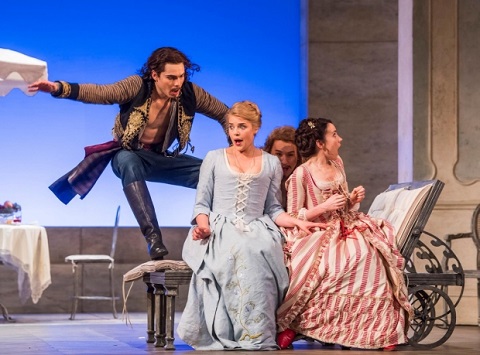 Ilya Kutyukhin (Guglielmo), Kirsten Mackinnon (Fiordiligi), Bogdan Volkov (Ferrando), Rachel Kelly (Dorabella). Photo credit: Tristram Kenton
Ilya Kutyukhin (Guglielmo), Kirsten Mackinnon (Fiordiligi), Bogdan Volkov (Ferrando), Rachel Kelly (Dorabella). Photo credit: Tristram Kenton
Hytner seems almost deliberately to eschew the potential opportunities for high jinks and excess, and moderation makes the subtle ‘gags’ all the more telling - as when Guglielmo, supposedly dying of arsenic poisoning, snatches a slug of wine from the al fresco table when he thinks no one is watching (of course, Alfonso is!); or when Dorabella exhibits an indecorous interest in Guglielmo’s bare chest, exposed by the disguised Despina as she administers the Doctor’s Mesmer magnet.
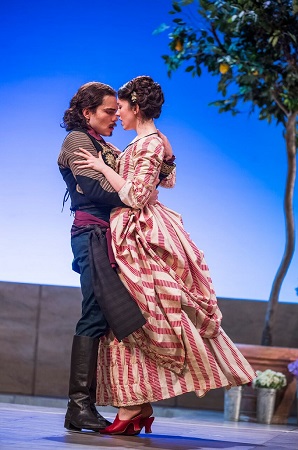 Ilya Kutyukhin (Guglielmo), Rachel Kelly (Dorabella). Photo credit: Tristram Kenton
Ilya Kutyukhin (Guglielmo), Rachel Kelly (Dorabella). Photo credit: Tristram Kenton
The young cast fit neatly into their roles. As Dorabella, Irish mezzo Rachel Kelly glowed with a warmth expressive of the younger sister’s impulsive, passionate nature. The full, rich tone of her Act 2 confession of indiscretion, ‘È amore un ladroncello’ (Love is a little thief), was winningly honest. Canadian soprano Kirsten MacKinnon’s Fiordiligi was well characterised; we witnessed and believed in a credible, heartfelt crisis of loyalty and love. MacKinnon scaled the heights of ‘Come scoglio’ cleanly - although here and in ‘Per pietà’ her chest voice was not consistently steady or firm - and was a fearsome rebutter of Ferrando’s advances. In the repeat of the first section, she focused her indignation on her younger sister, instructing her in the need for steadfastness; the prominence given to her pendant made its subsequent loss all the more affecting.
Ukrainian tenor Bogdan Volkov, who won second prize at Plácido Domingo’s Operalia competition in 2016, was a sensitive Ferrando. His tone was tender and the phrases beautifully shaped in ‘Un’aura amorosa’, and this aria was an unanticipated moment of stillness, evoking sincerity of sentiment, within the unfolding machinations. Volkov demonstrated plenty of power, though, when provoked by Dorabella’s infidelity, though Russian baritone Ilya Kutyukhin just nodded ahead in the charisma stakes, as a flamboyant, high-spirited Guglielmo.
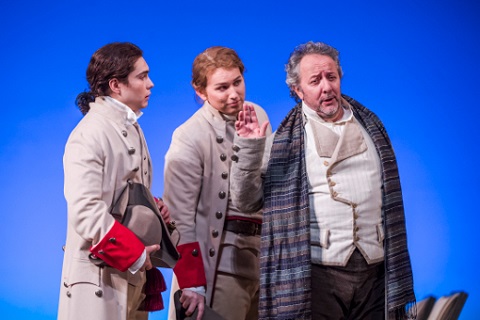 Ilya Kutyukhin (Guglielmo), Bogdan Volkov (Ferrando), José Fardilha (Don Alfonso). Photo credit: Tristram Kenton
Ilya Kutyukhin (Guglielmo), Bogdan Volkov (Ferrando), José Fardilha (Don Alfonso). Photo credit: Tristram Kenton
Watching over all with a cool impassiveness was José Fardilha’s nonplussed Don Alfonso: he seemed unconcerned about the outcome of his wager; he’s seen it all before. Though the Portuguese singer’s baritone was a little husky at times, the recitative was absolutely fluent and as an imperceptible but prevailing influence Fardilha swept the action forward with an irresistible effortlessness.
I felt that Portuguese soprano Ana Quintans was a tad too hyper-active as Despina, though her bright, clean soprano shone freshly. She needed a little more direction in her two arias, for she had a tendency to lapse into a ‘nudge-wink’ mode supplemented by lots of hand-flapping and funny voices: the effect was out-of-kilter with the prevailing low-key eloquence.
The Marlowe Theatre can present acoustic challenges for musicians and singers, and I’m not sure that on this first night of GTO’s brief residency conductor Leo McFall had quite got its measure. The overture felt rather tentative, the opening Andante somewhat laboured, the ‘motto’ figure heavily signposted. I haven’t sat in the Circle before, so can’t judge whether the prominence of the woodwind and horns was an acoustical quirk, but while the playing was notable for its refinement - and Mozart’s woodwind contribute greatly to characterisation and dramatic orientation - they frequently seemed too loud. Bassoon, flute and clarinet penetrated forcefully in ‘Come scoglio’ and in ‘Donne mie, la fate a tanti’ (My ladies, you do it to so many) the two horns were strong and true but rather overpowered the gloating Guglielmo. Often there seemed an imbalance between strings and wind. McFall also didn’t have a completely sure grip on the larger ensembles and choruses, when stage and pit occasionally went adrift; the conductor seemed to set quite rigid ensembles and didn’t so much as adapt to his singers but dragged them back into the fold.
However, this was a very satisfying evening. At the end of Don Alfonso’s ‘demonstration’, the pupils in this ‘school for lovers’ had clearly learned their lesson. For once, the re-coupling at the close did not unsettle or give cause for doubt. The resolution was as serene as the azure sky, in which not a single grey cloud hovered to cast a shadow of uncertainty. Hytner’s production might lack a little piquancy at times, but sometimes equipoise and peace are welcome.
Claire Seymour
Mozart: Così fan tutte
Ferrando - Bogdan Volkov, Guglielmo - Ilya Kutyukhin, Don Alfonso - José Fardilha, Fiordiligi - Kirsten MacKinnon, Dorabella - Rachel Kelly, Despina - Ana Quintans, Actors (Jofre Caraben van der Meer, Philip Dew, Vigee Harding, Adrien Mastrosimone, Mark Ruddick); director - Nicholas Hytner, conductor - Leo McFall, revival director - Bruno Ravella, designer - Vicki Mortimer, lighting designer - Paule Constable, revival lighting designer - Keith Benson, Glyndebourne Tour Orchestra, Glyndebourne Chorus (chorus master - Nicholas Jenkins).
Marlowe Theatre, Canterbury; Tuesday 31st October 2017.
image=http://www.operatoday.com/Alfonso%20and%20men%20Kenton.jpg
image_description=Così fan tutte, Glyndebourne Touring Opera at the Marlowe Theatre
product=yes
product_title=Così fan tutte, Glyndebourne Touring Opera at the Marlowe Theatre
product_by=A review by Claire Seymour
product_id=Above: Ilya Kutyukhin (Guglielmo), José Fardilha (Don Alfonso), Bogdan Volkov (Ferrando)
Photo credit: Tristram Kenton